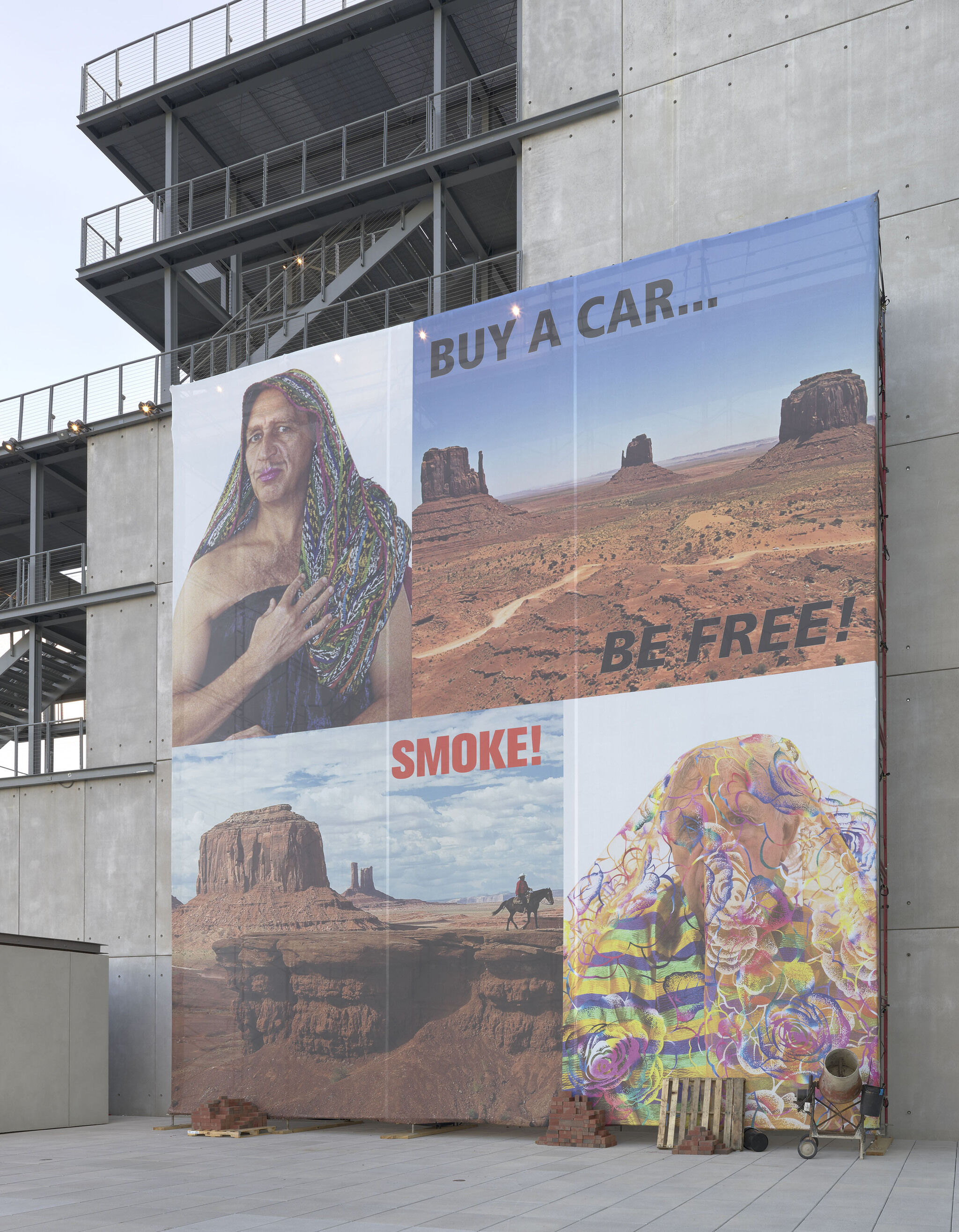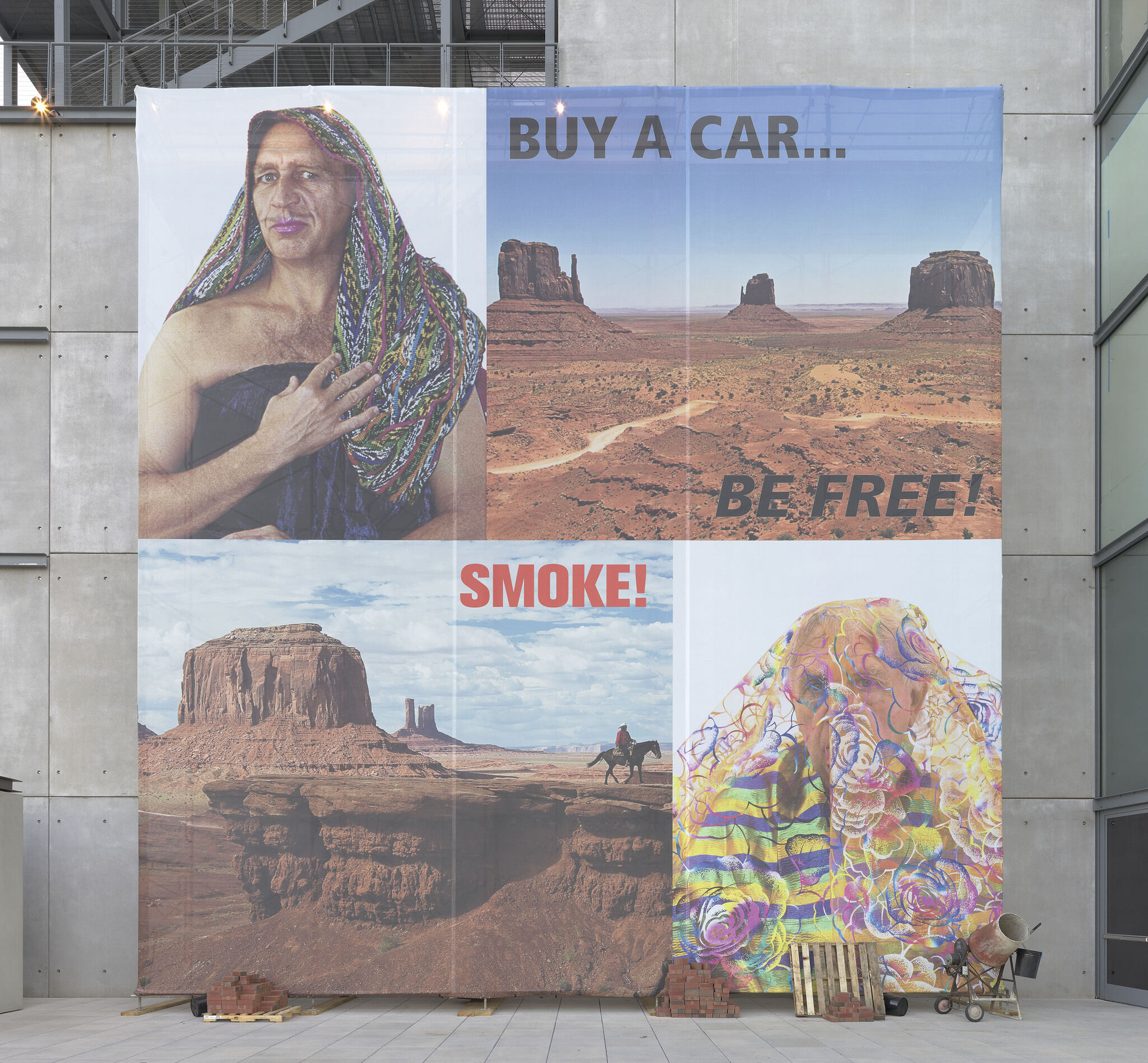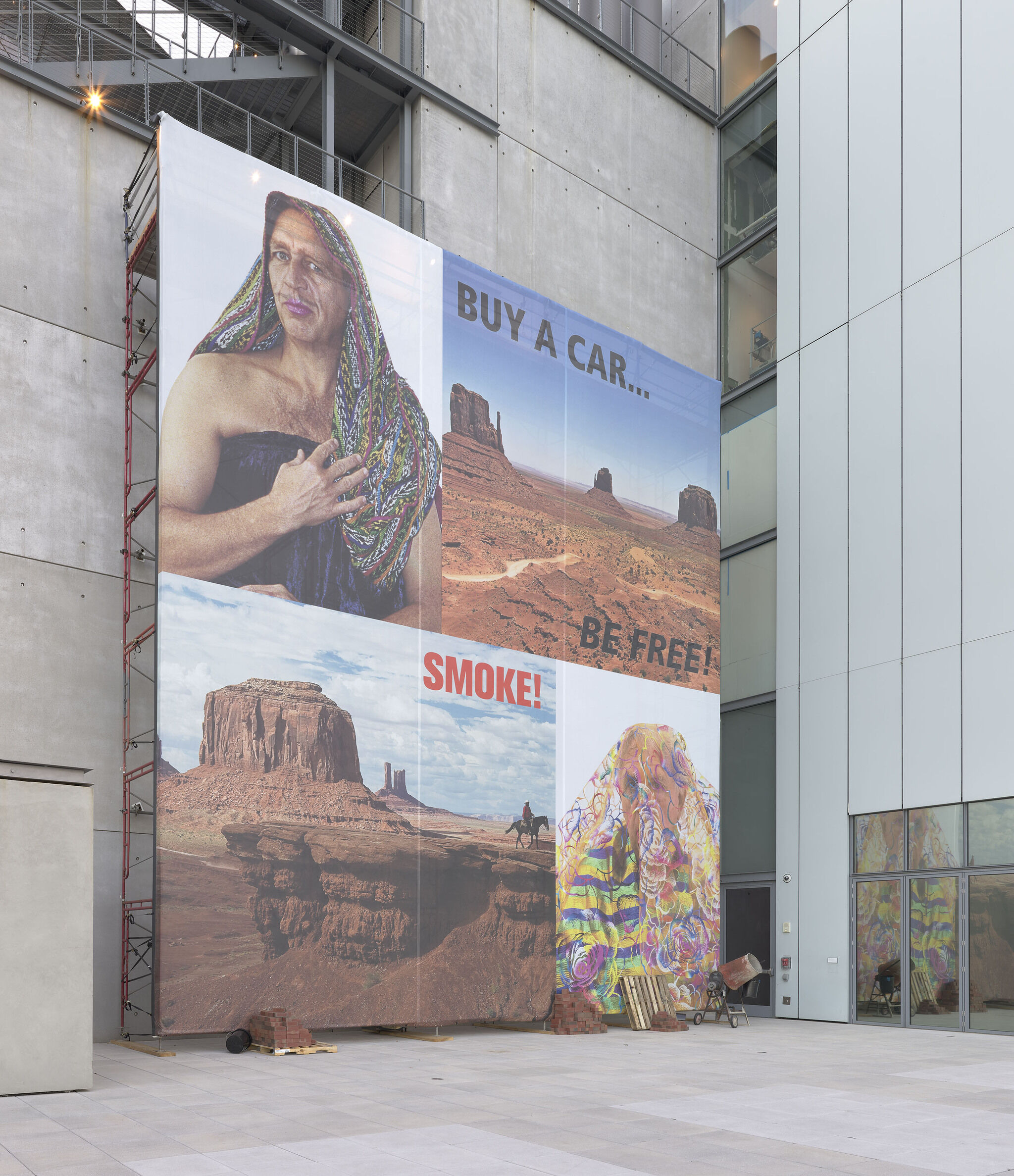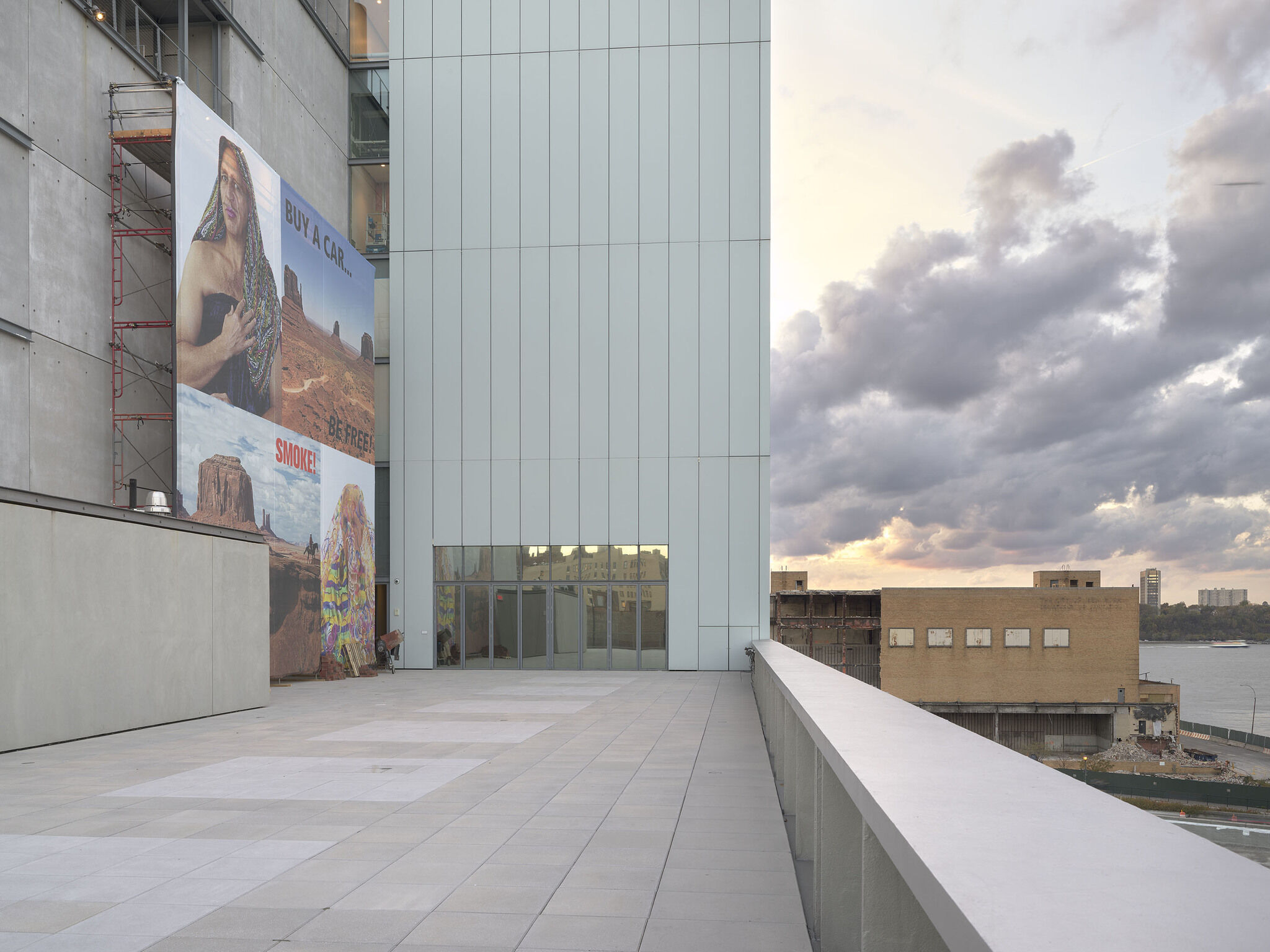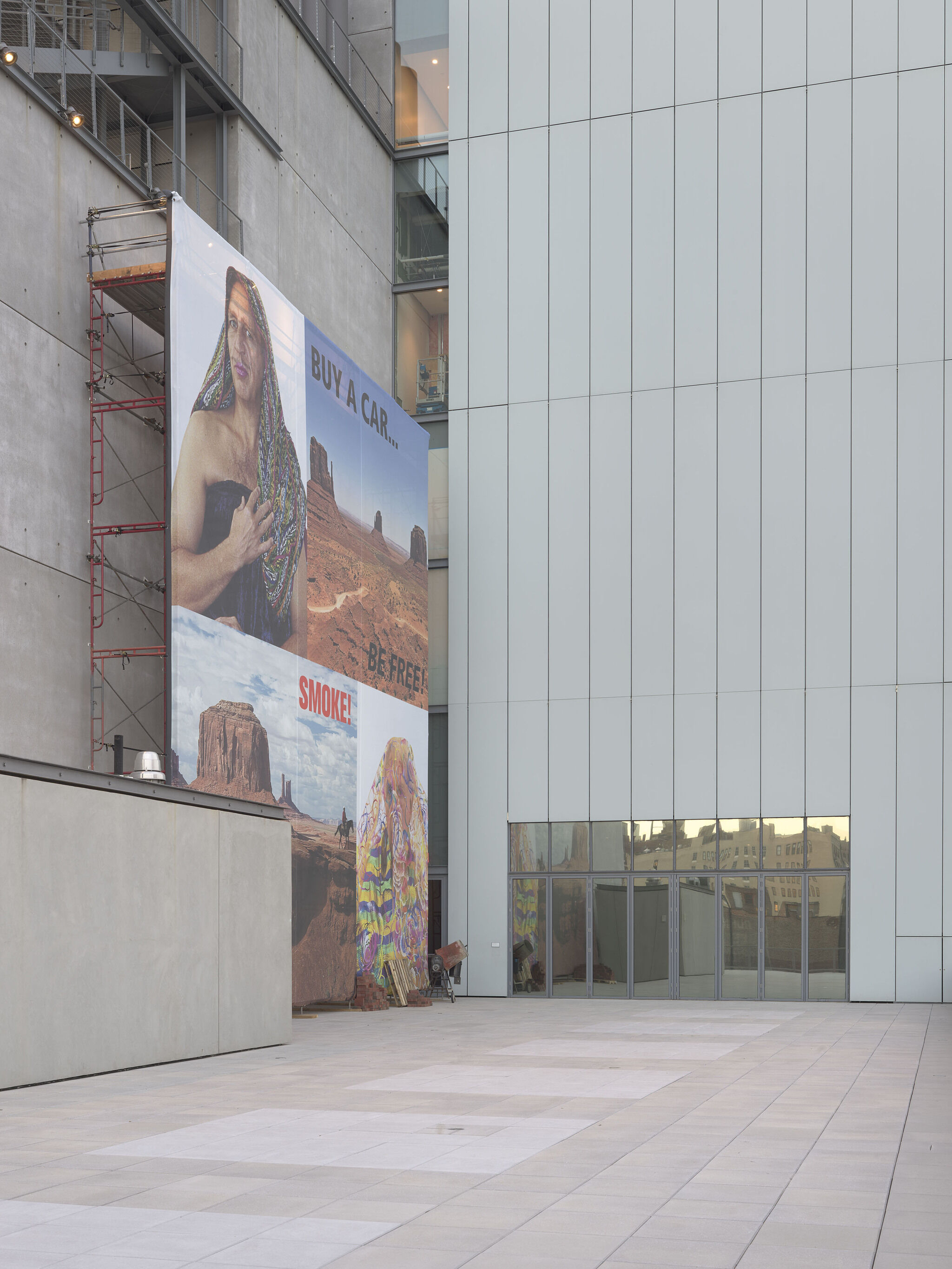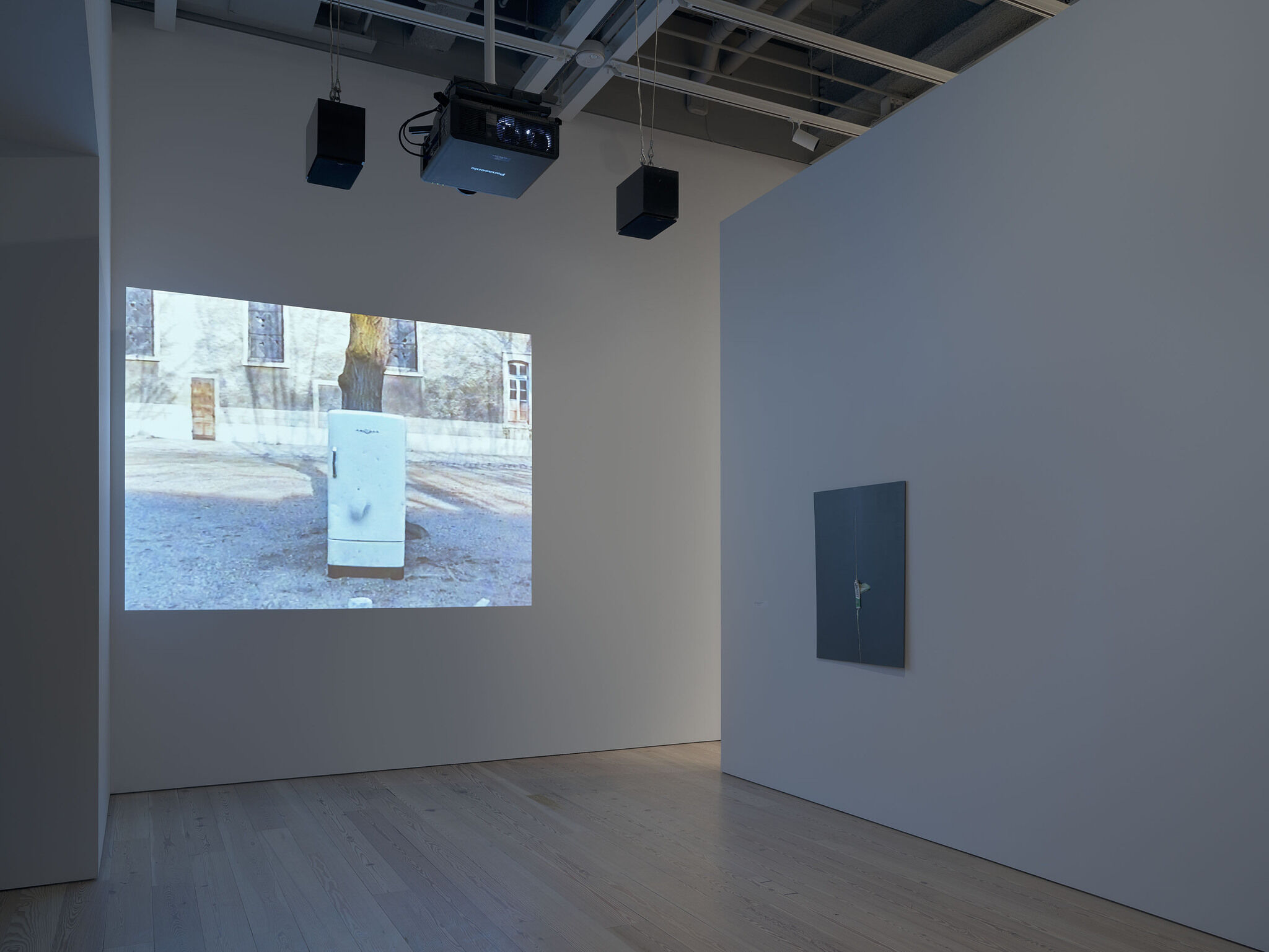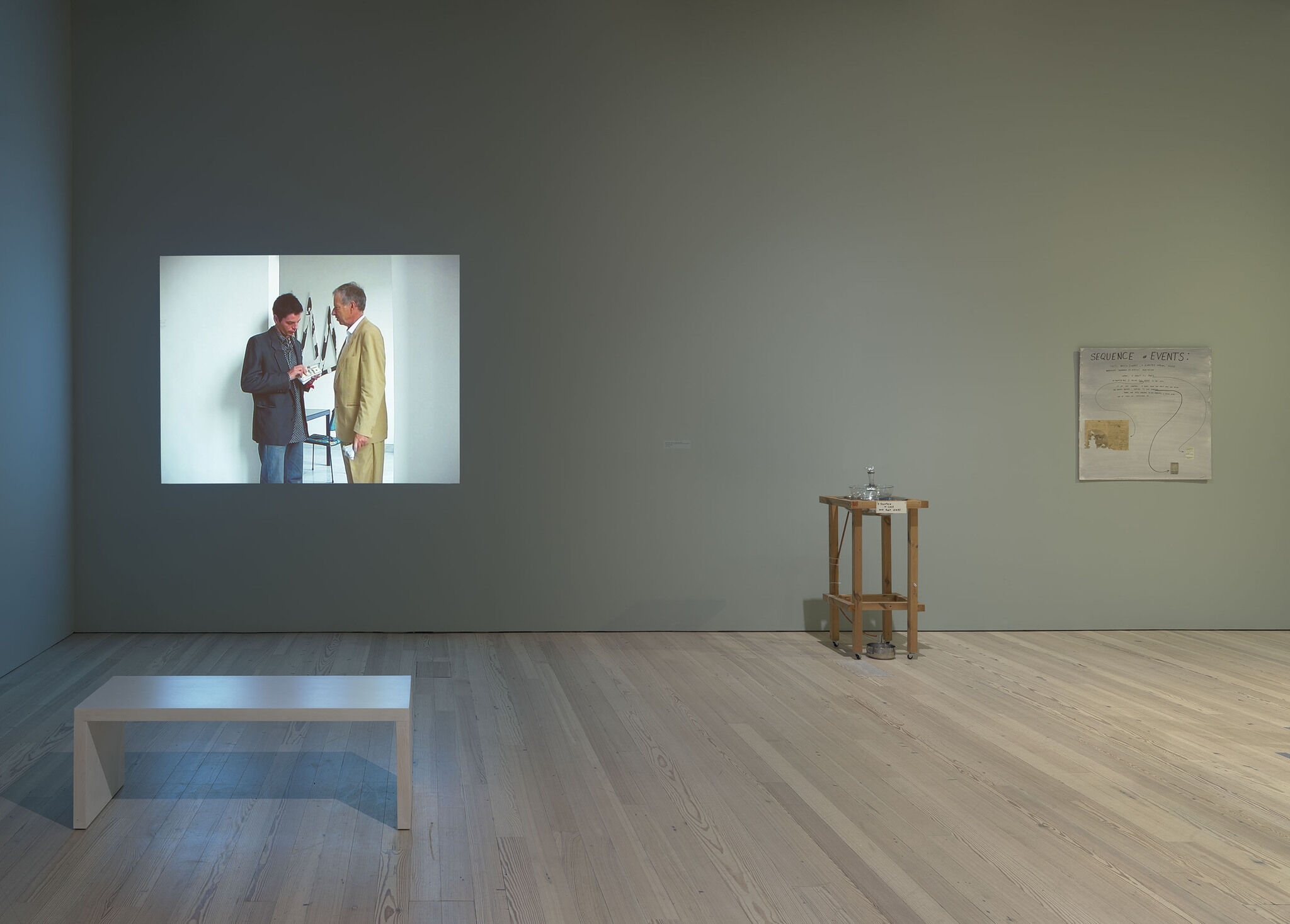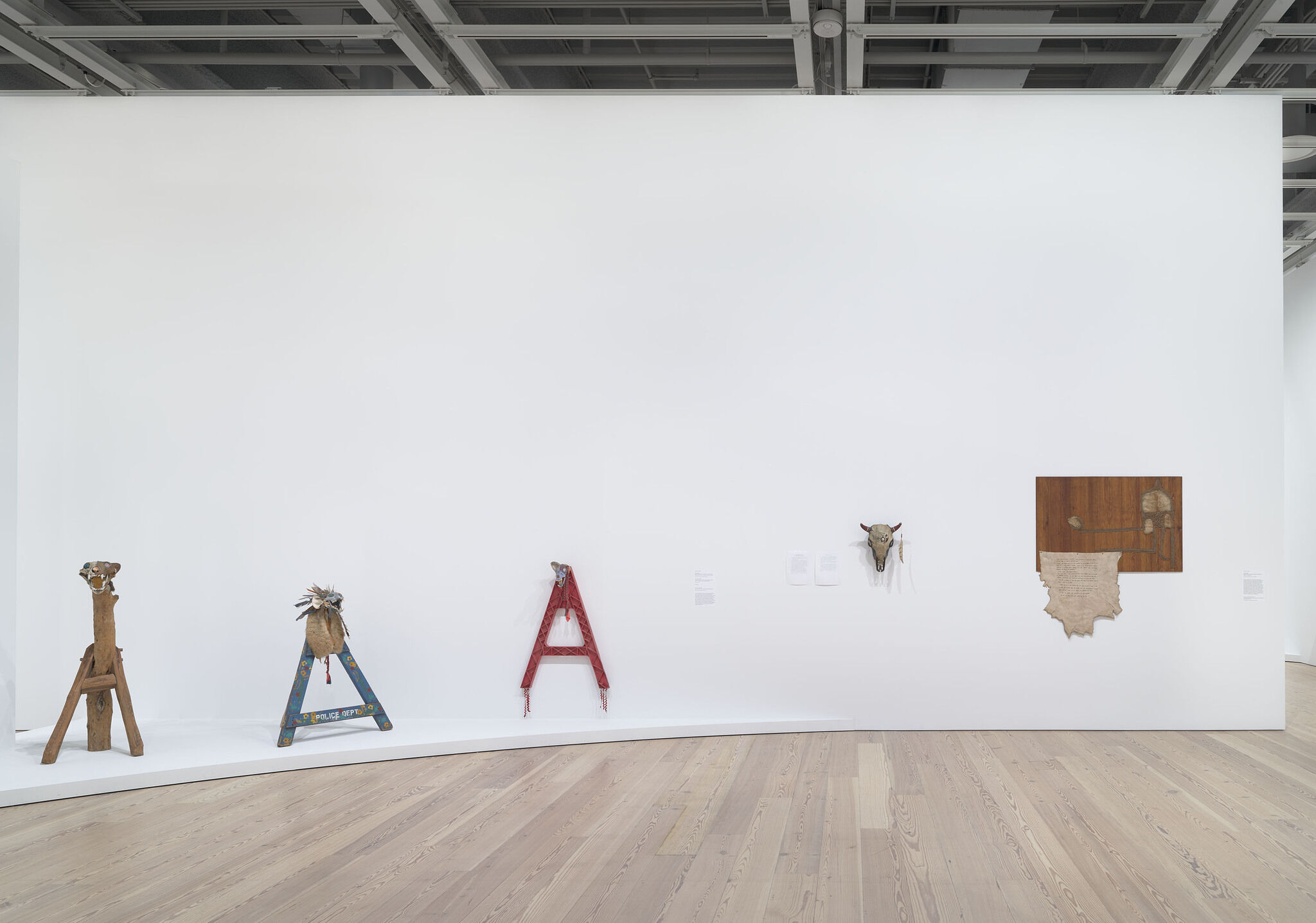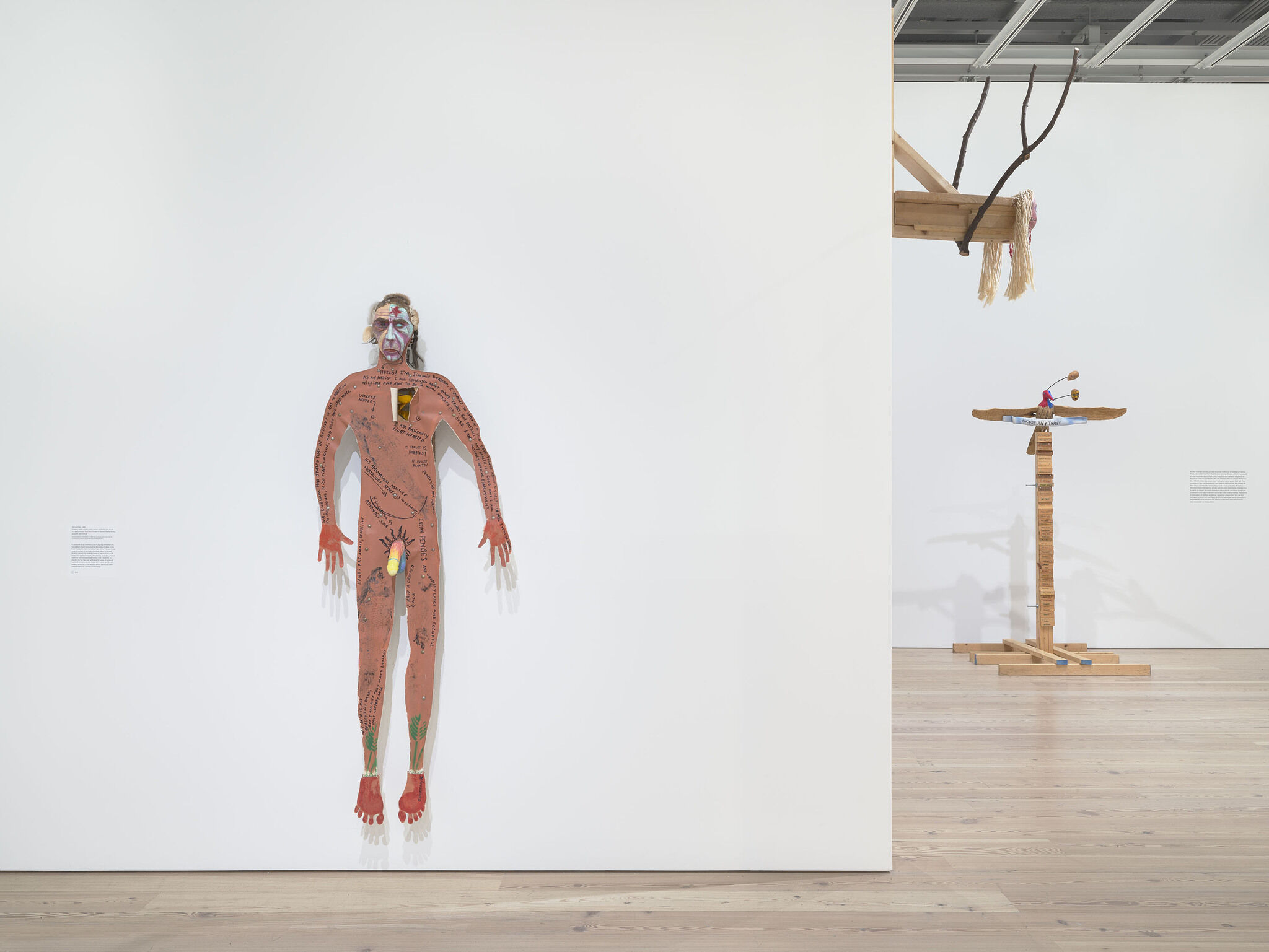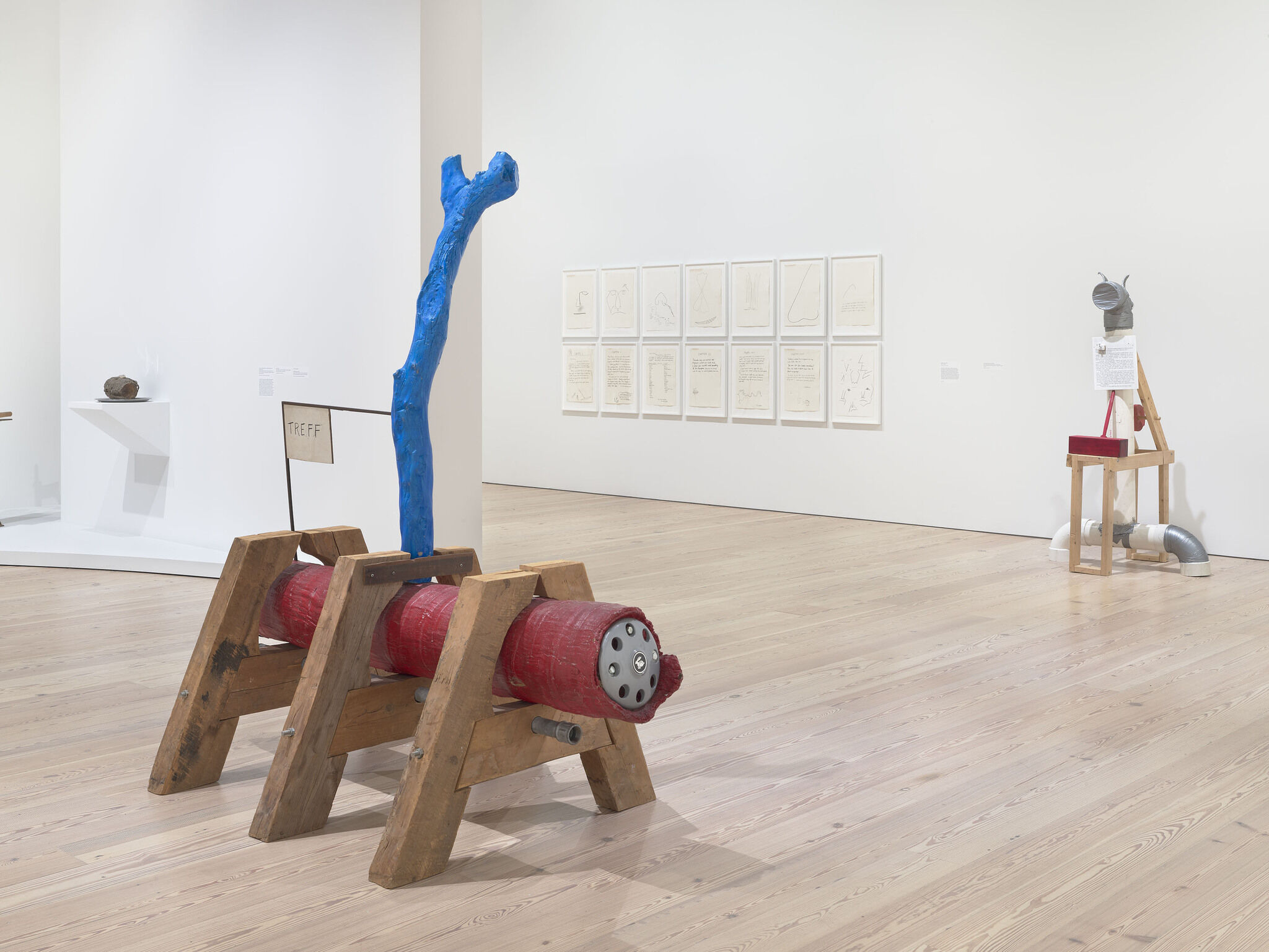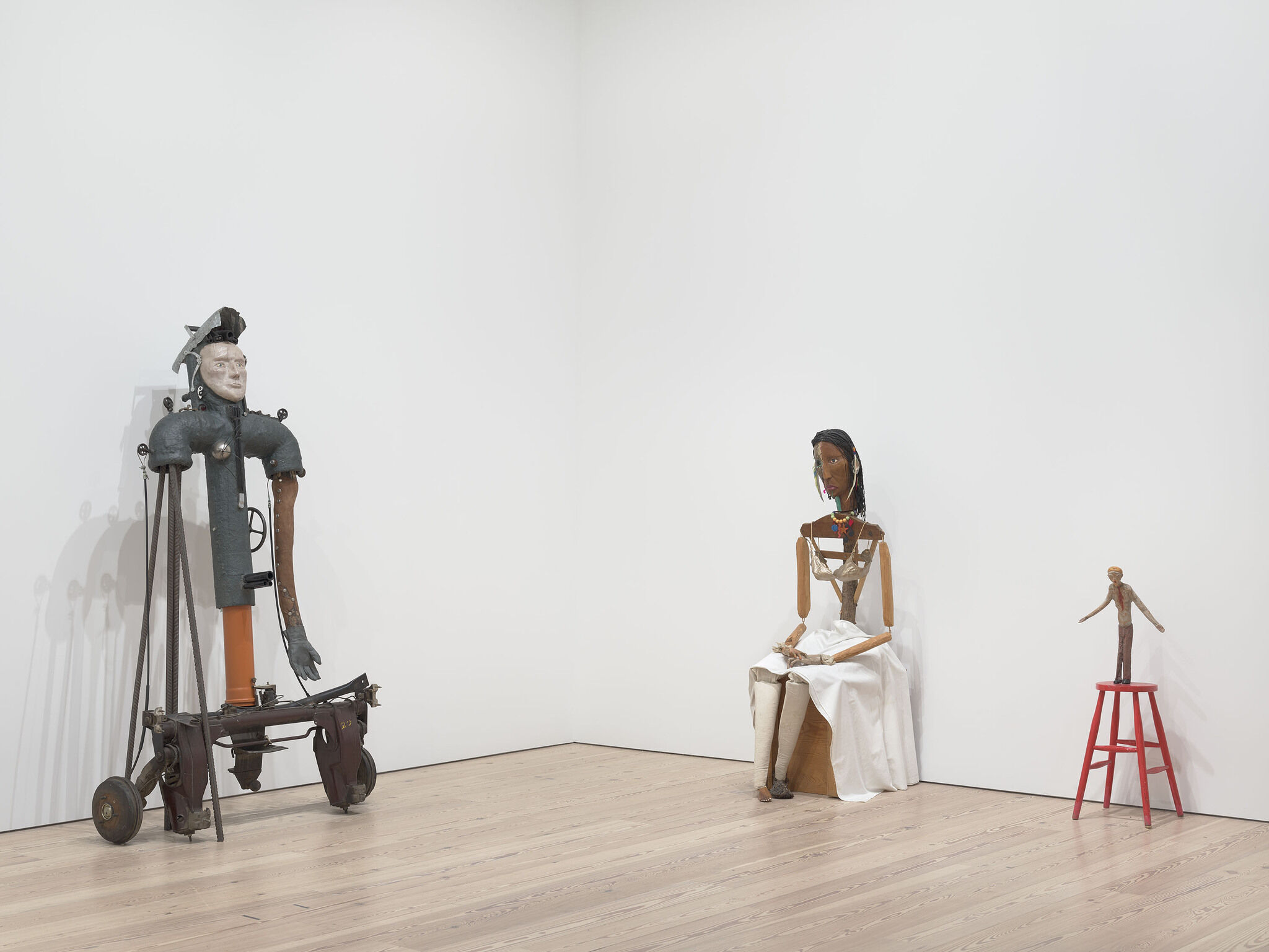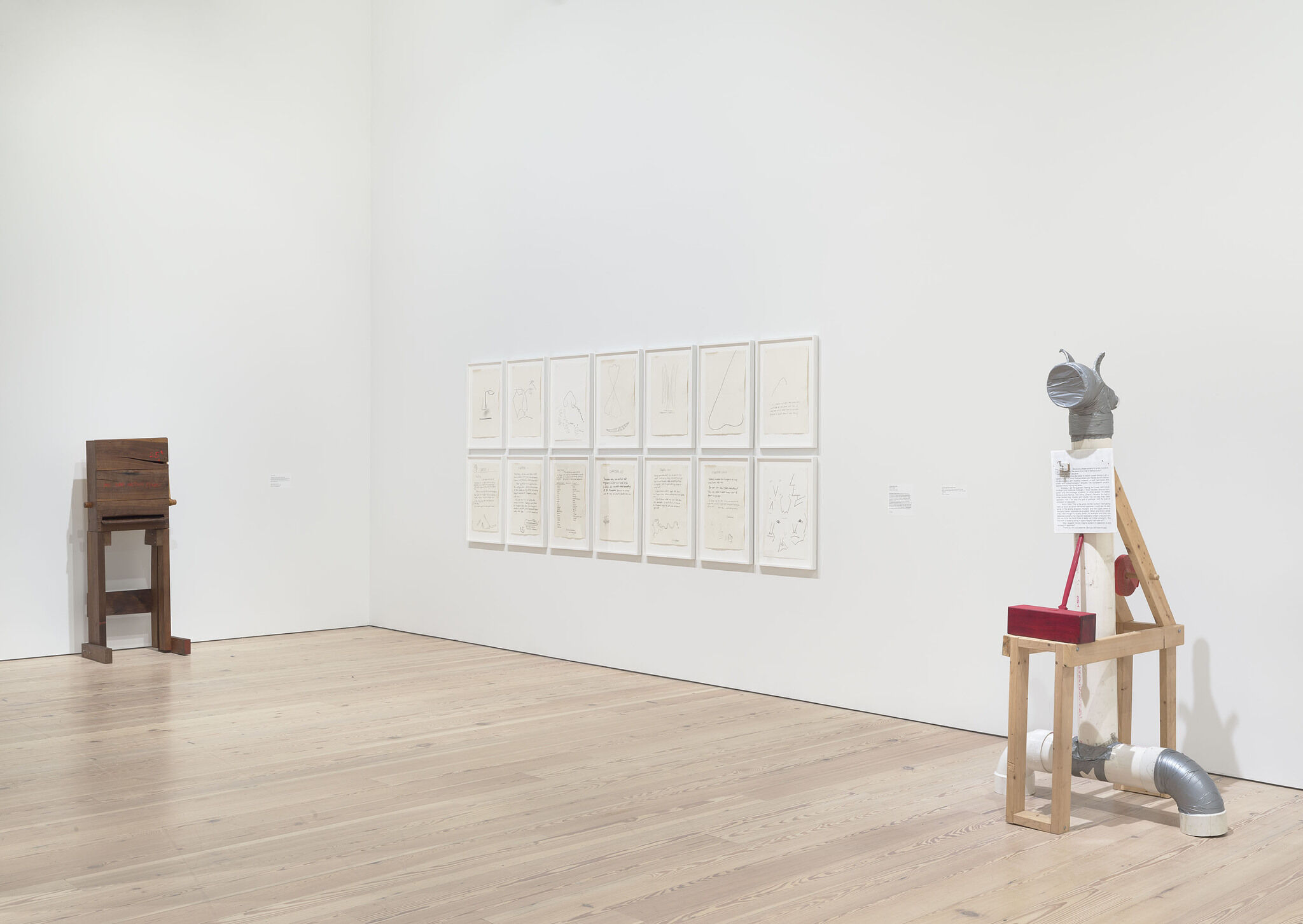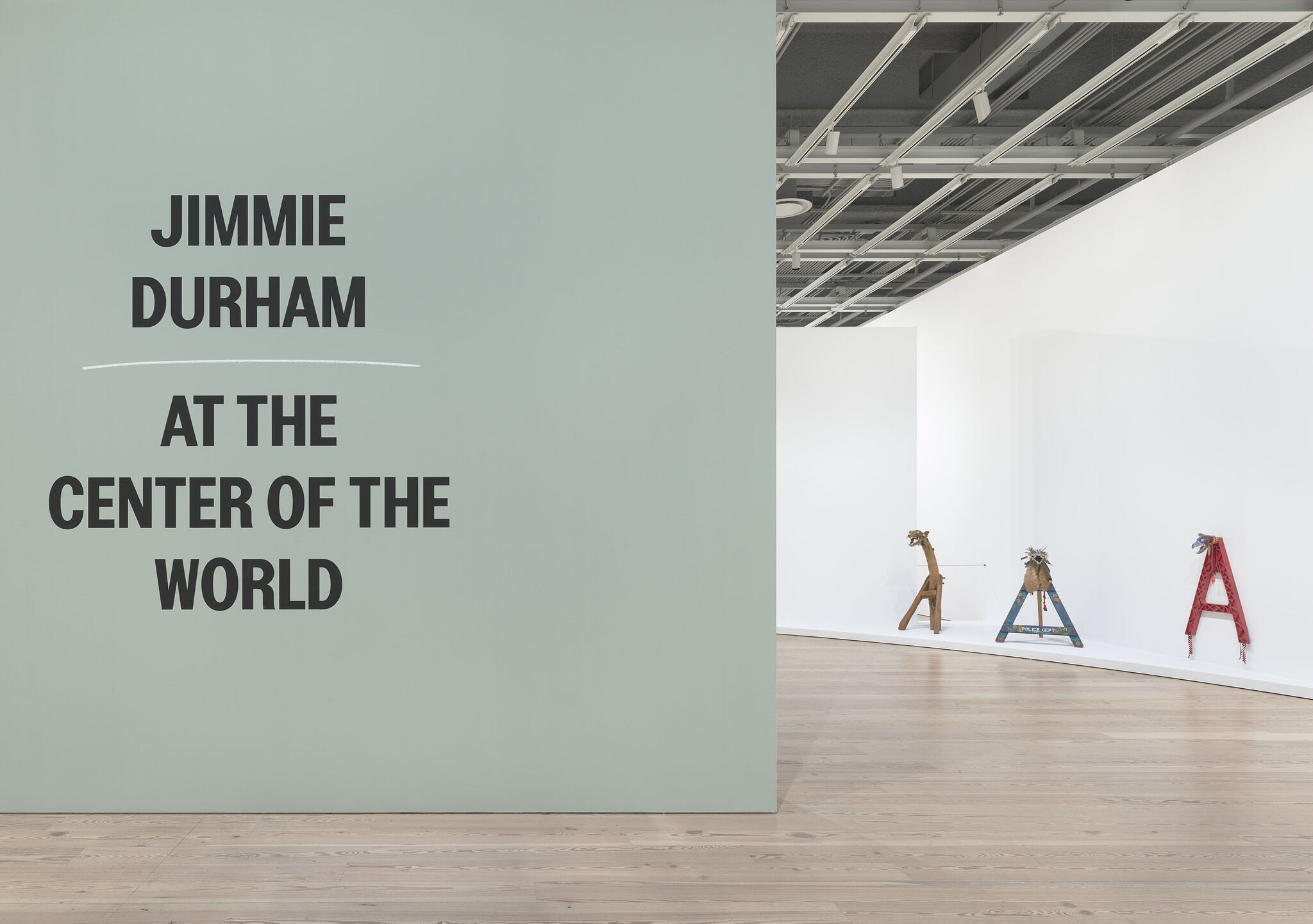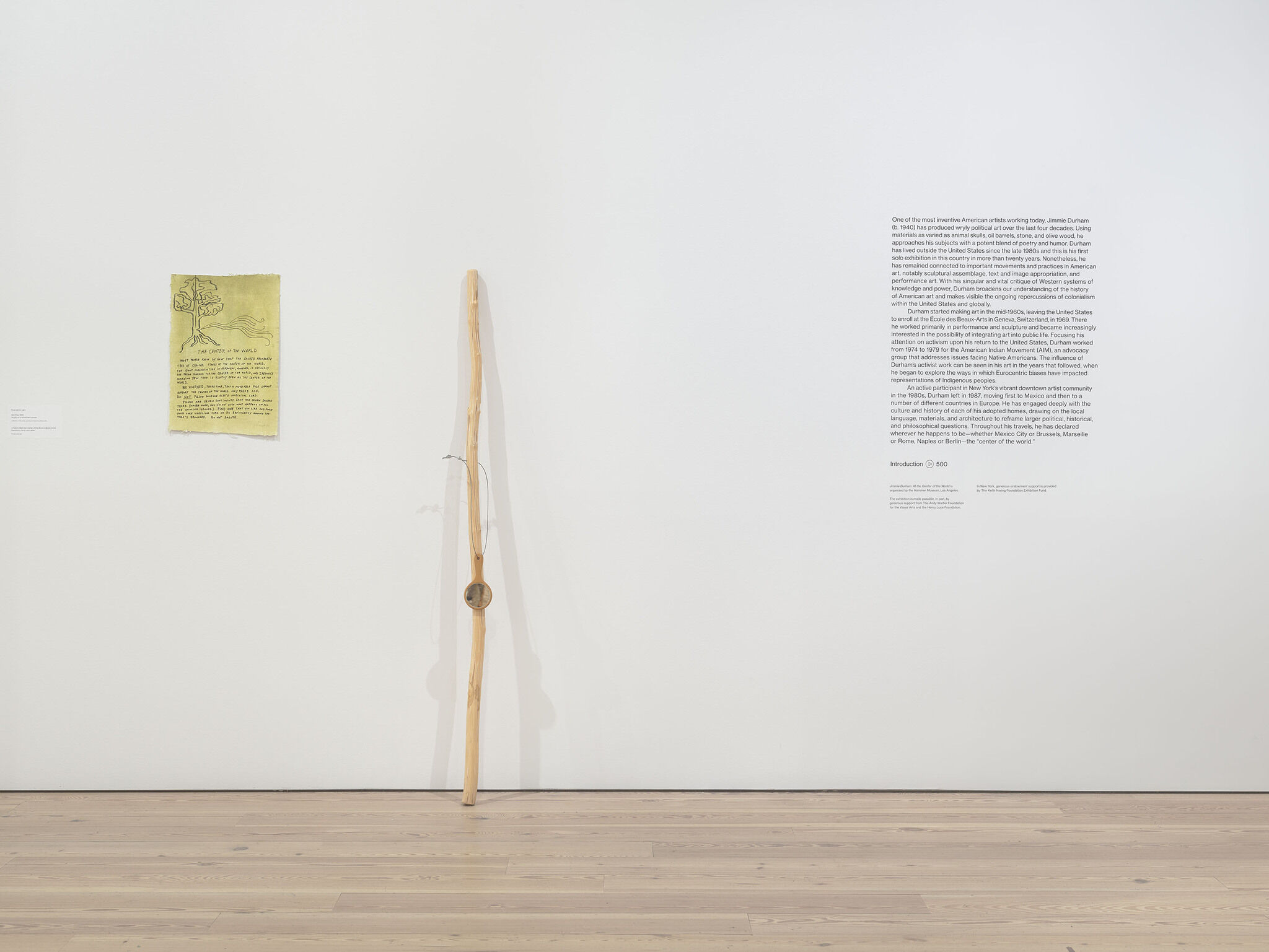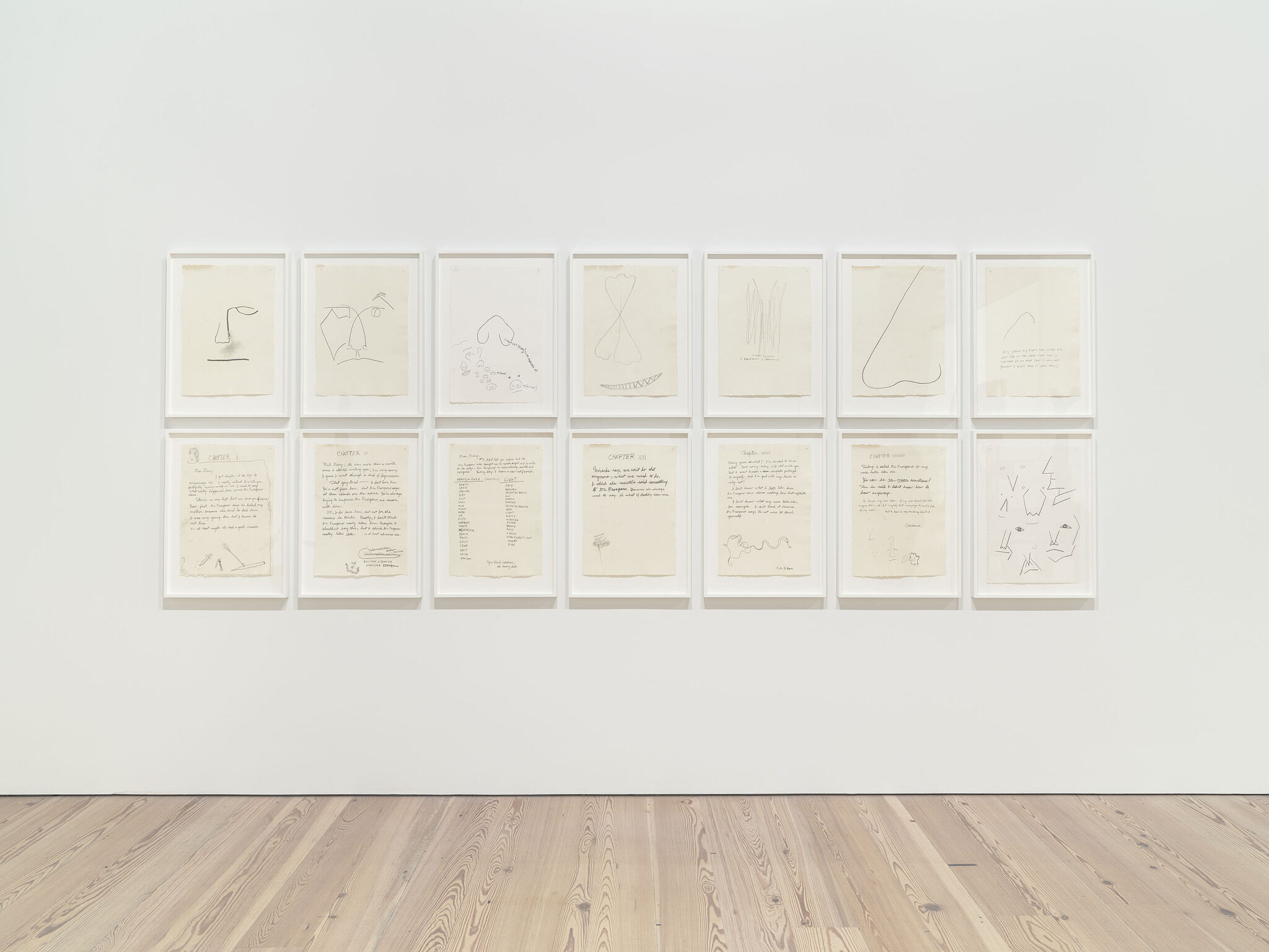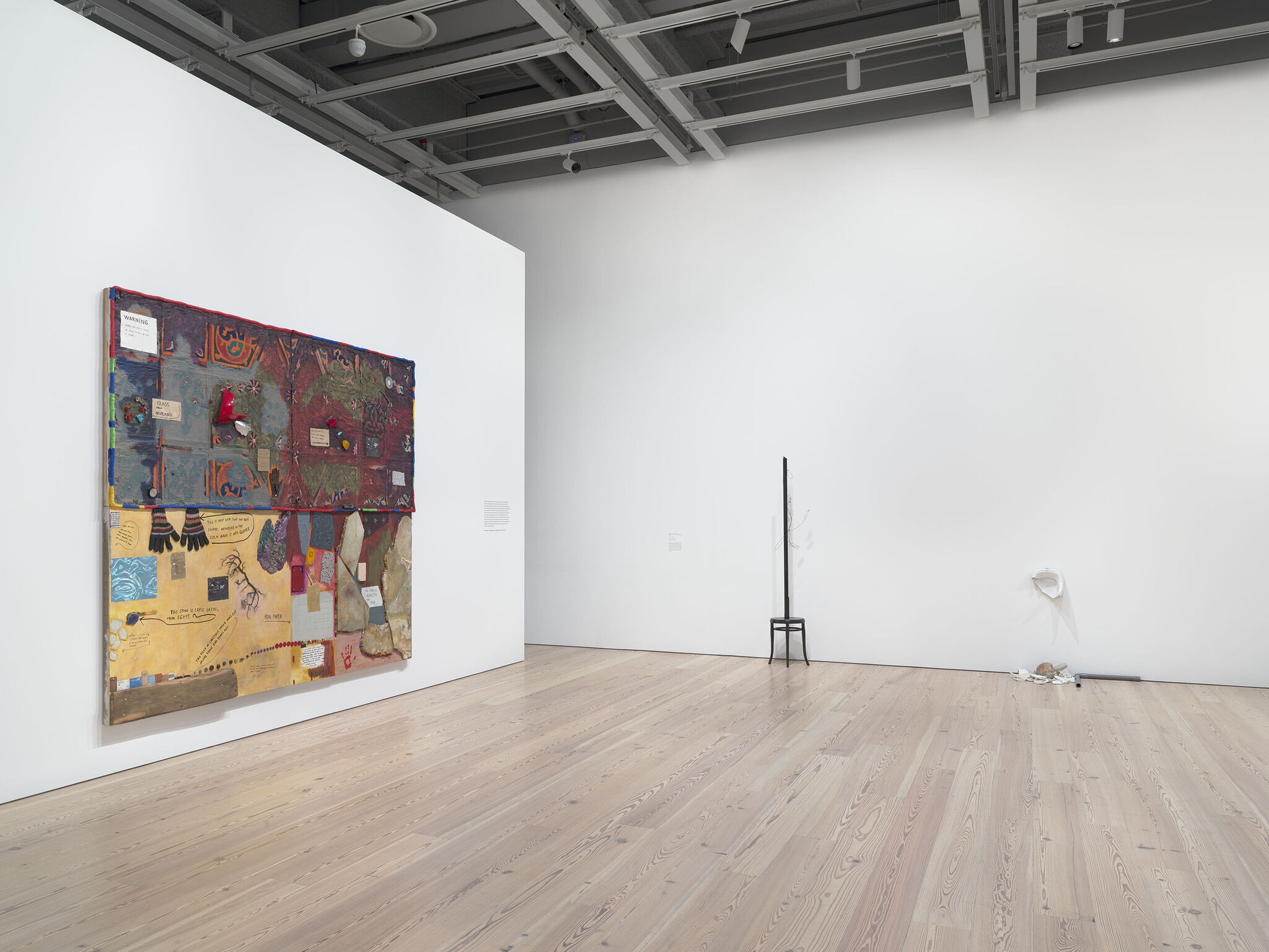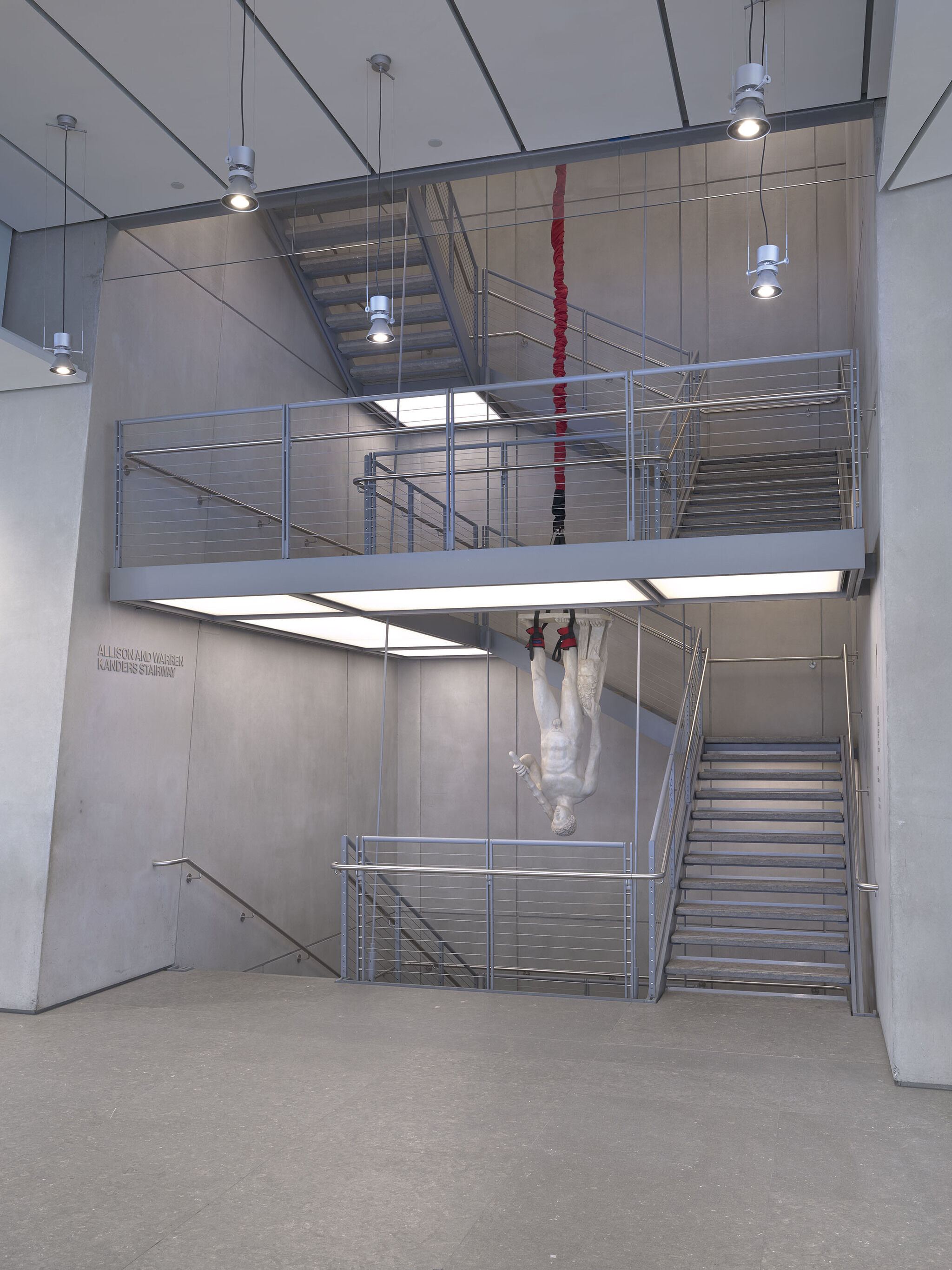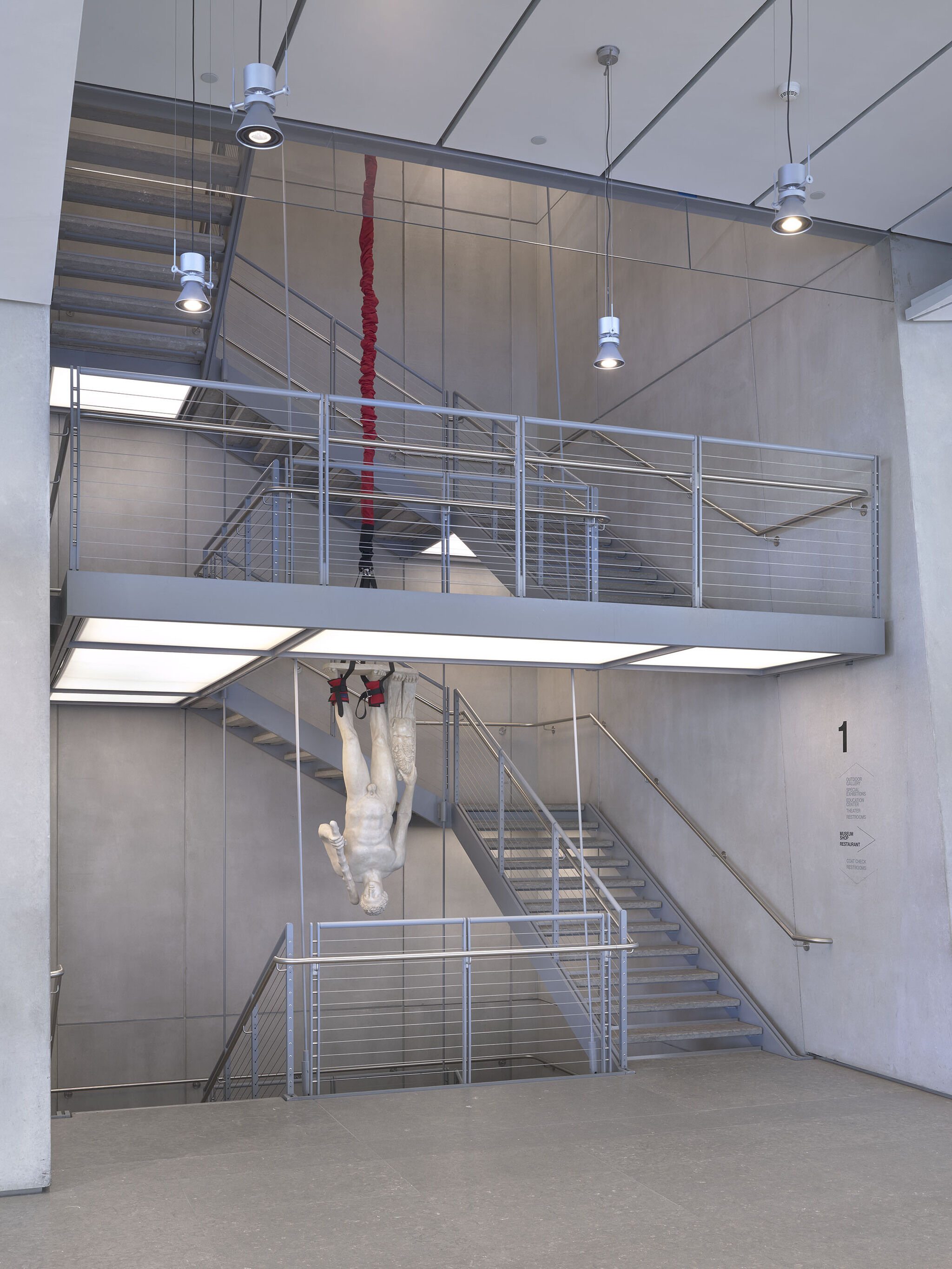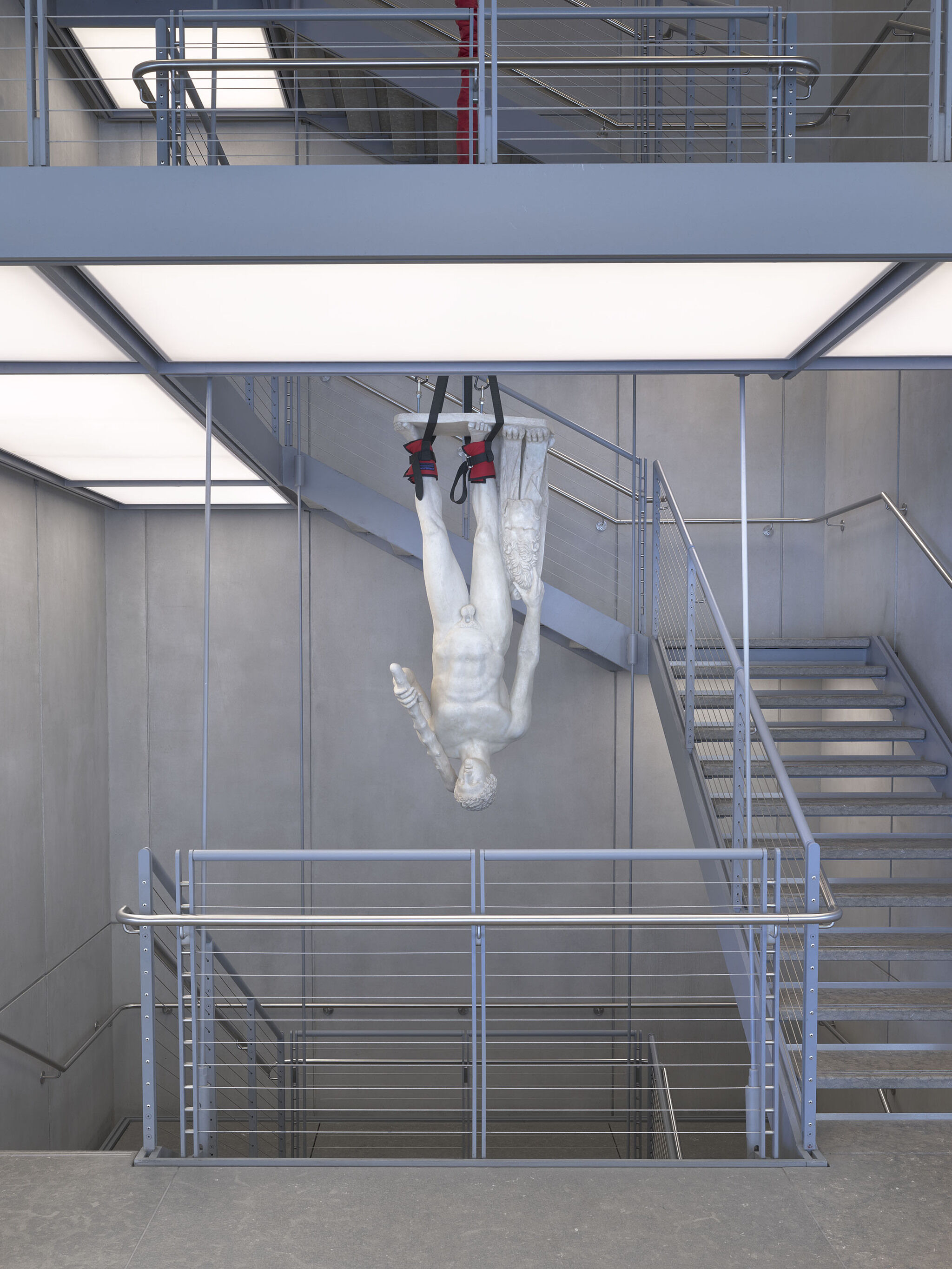Jimmie Durham: At the Center of the World
Nov 3, 2017–Jan 28, 2018
Jimmie Durham: At the Center of the World
Artist and activist Jimmie Durham (b. 1940) has worked as a visual artist, performer, essayist, and poet for more than forty-five years. A political organizer for the American Indian Movement during the 1970s, he was an active participant in the downtown New York City artistic community in the 1980s. In 1987 he moved to Cuernavaca, Mexico, then to Europe in 1994, where he has lived ever since. Predominantly a sculptor, Durham often combines found objects and natural materials and incorporates text to expose Western-centric views and prejudices hidden in language, objects, and institutions. Calling himself an "interventionist," Durham is oftentimes critical in his analysis of society but with a distinctive wit that is simultaneously generous and humorous.
Durham's expansive practice spans sculpture, drawing, collage, photography, video, and performance, and the exhibition includes approximately 120 objects dating from 1970 to the present. It is accompanied by a catalogue comprising several scholarly essays, an interview with the artist, a chronology, and a selection of Durham's own writings, both old and new. The first North American retrospective of Durham's work, At the Center of the World traces his remarkable attentiveness to materials and characteristic approach to assemblage while demonstrating his commitment to shedding light on the complexities of historical narratives, notions of authenticity, and the borders and boundaries that try to contain us.
Jimmie Durham: At the Center of the World is organized by the Hammer Museum, Los Angeles, and curated by Anne Ellegood, senior curator, with MacKenzie Stevens, curatorial assistant. The installation at the Whitney Museum is overseen by Elisabeth Sussman, Sondra Gilman Curator of Photography, and Laura Phipps, assistant curator, Whitney Museum of American Art.
Jimmie Durham: At the Center of the World is organized by the Hammer Museum, Los Angeles.
The exhibition is made possible, in part, by generous support from The Andy Warhol Foundation for the Visual Arts and the Henry Luce Foundation.
In New York, generous endowment support is provided by The Keith Haring Foundation Exhibition Fund.
Director's Statement
Jimmie Durham's retrospective exhibition has revived longstanding debates about the artist's self-identification as Cherokee, and Native American tribal sovereignty. Director Adam Weinberg addresses the ways in which the exhibition can serve as a platform for discussion and dialogue.
Events
View all-
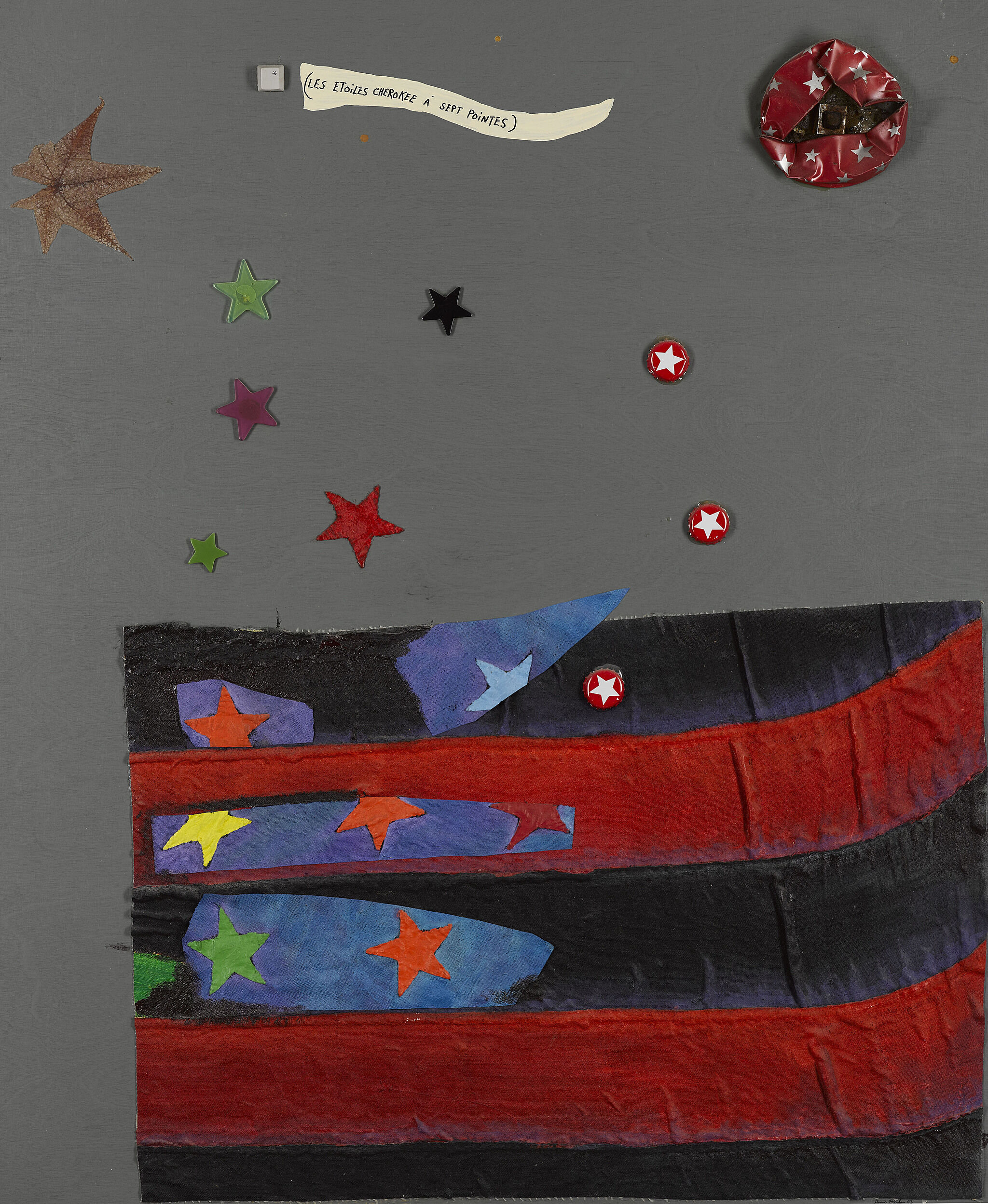
Feathered Flags:
A Lecture by Paul Chaat SmithFriday, January 19, 2018
6:30 pm -
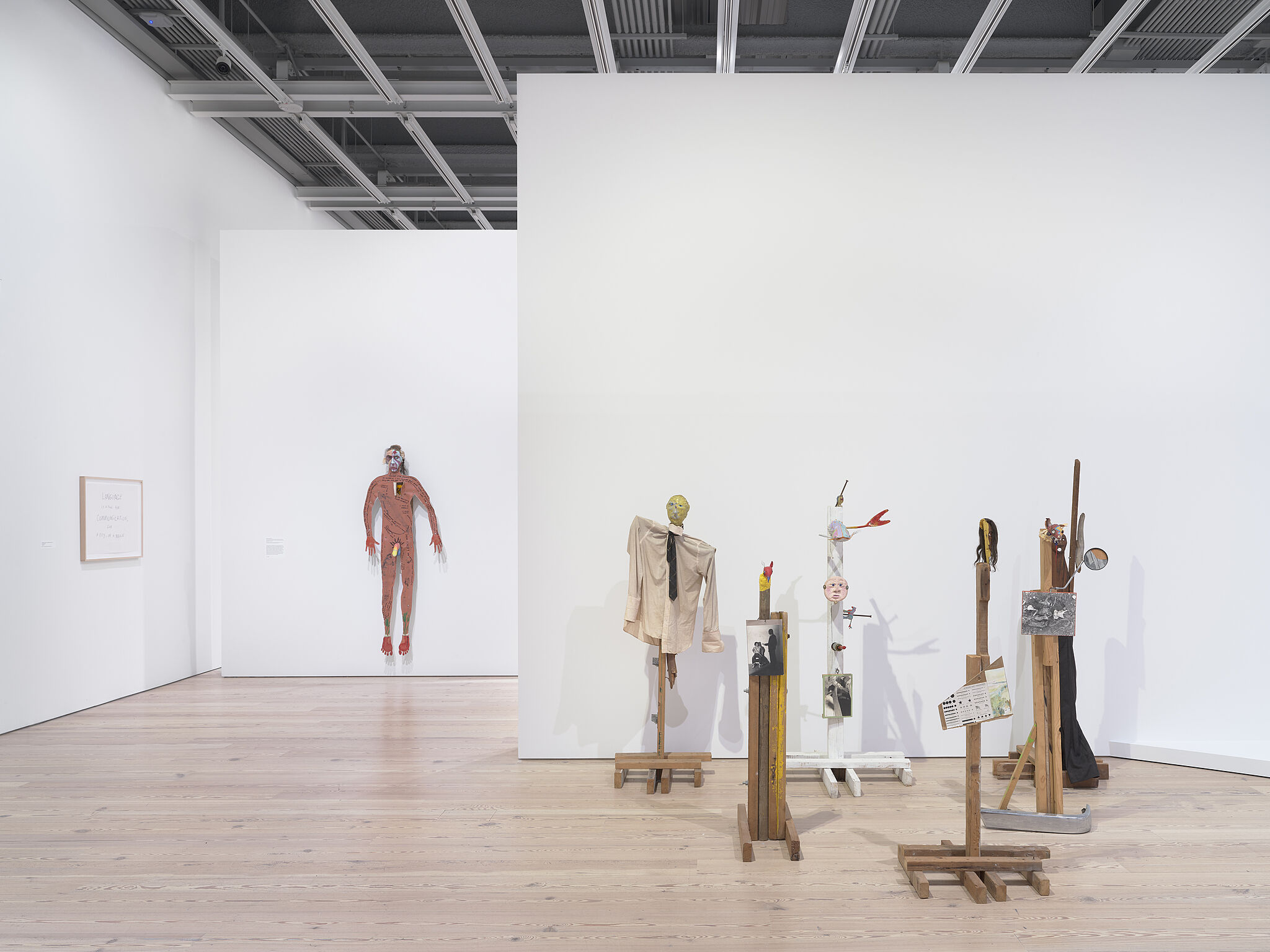
Reception and Contemporaries Tours of Jimmie Durham: At the Center of the World
Thursday, January 18, 2018
7:45 pm -
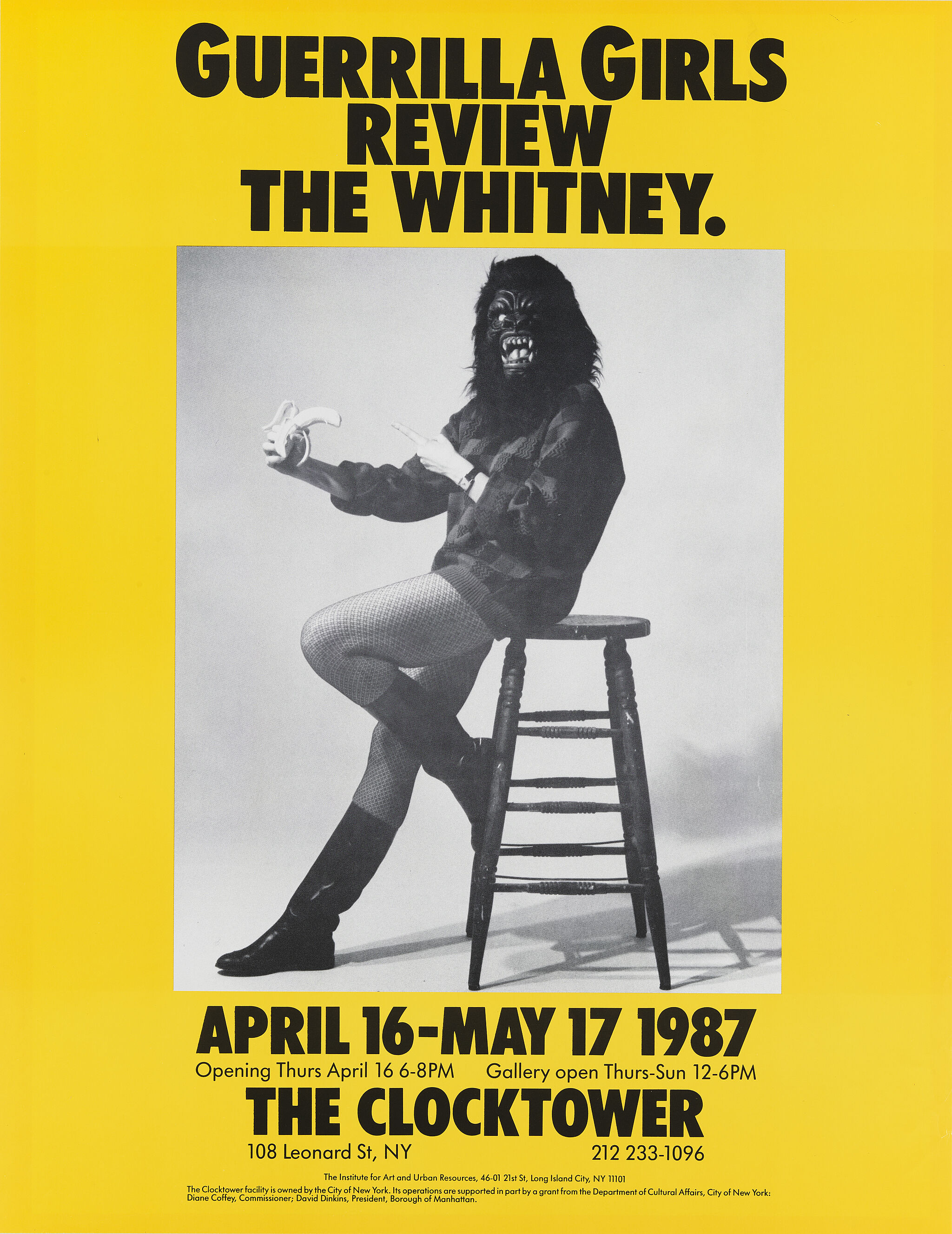
Art as Activism, Activism as Art
Wednesday, January 17, 2018
6:30–8 pm -
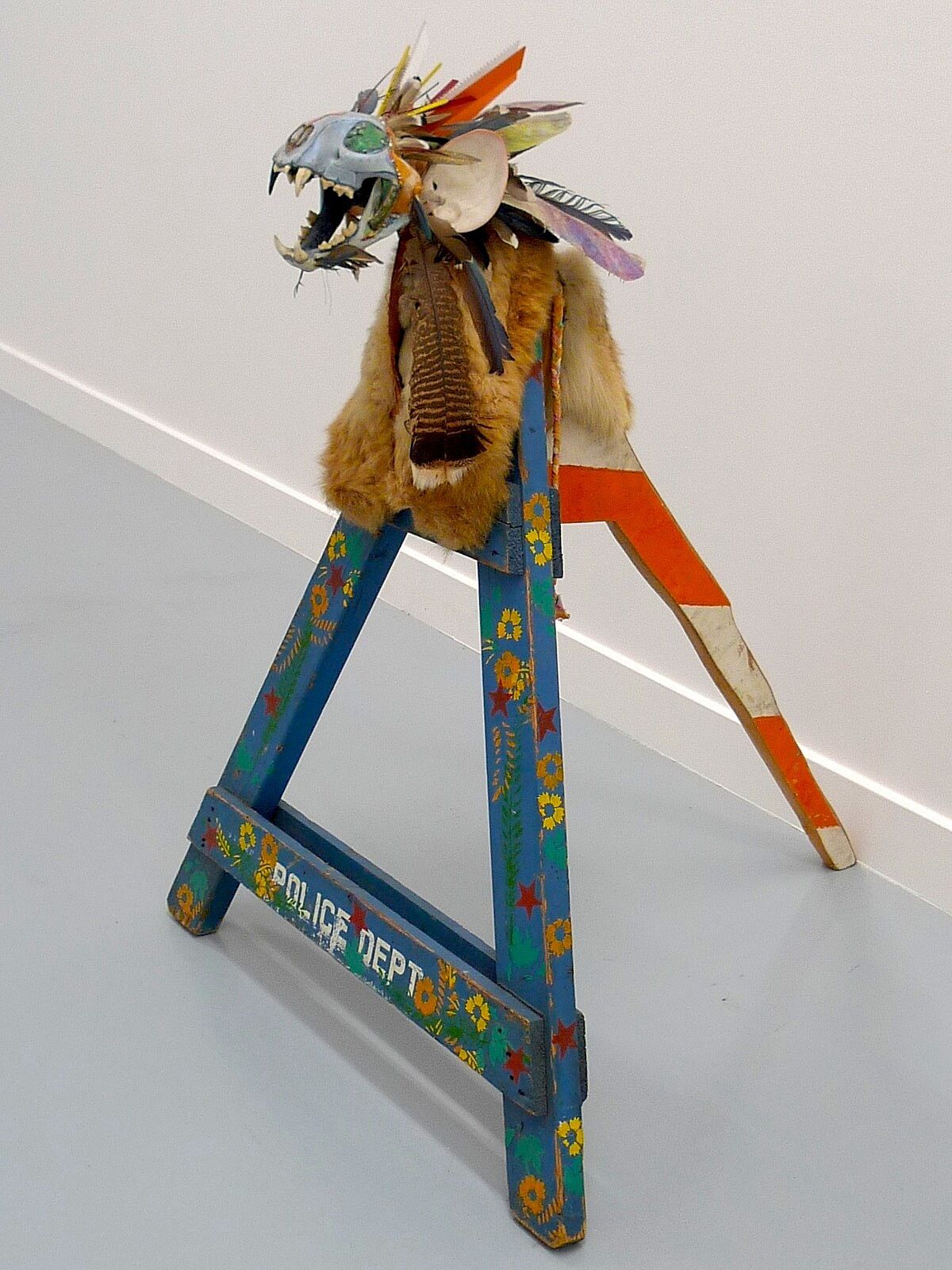
Stroller Tour:
Jimmie Durham: At the Center of the WorldSaturday, December 9, 2017
9:30–10:30 am
Installation photography
-
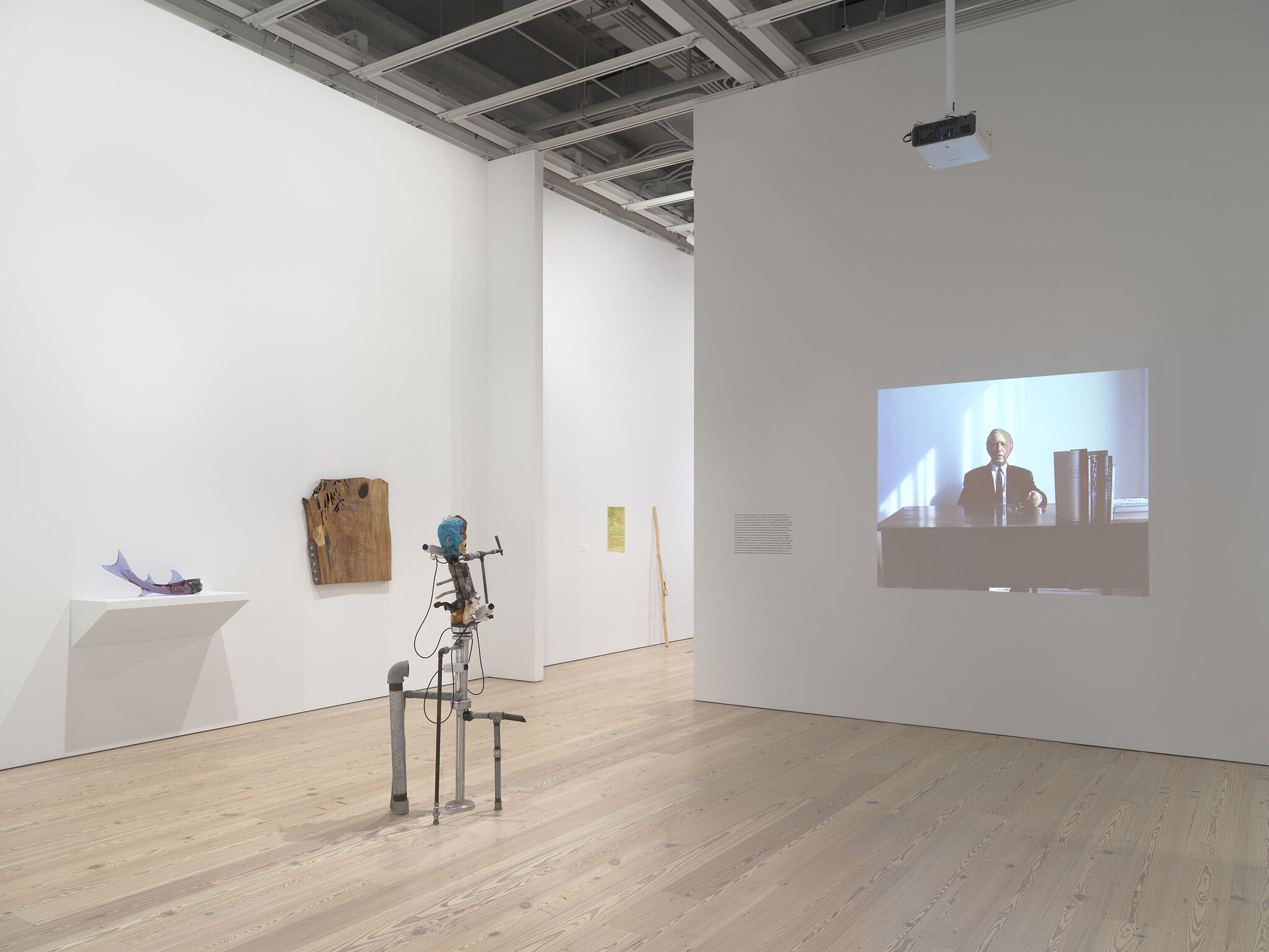

Installation view of Jimmie Durham: At the Center of the World (Whitney Museum of American Art, New York, November 3, 2017–January 28, 2018). From left to right: Carnivalesque Shark in Venice, 2015; Slash and Burn, 2007; The Doorman, 2009; Anti Flag, 1992; A Pole to Mark the Center of the World in Berlin, 2004; Obsidiana, 2009. Photograph by Ron Amstutz
-
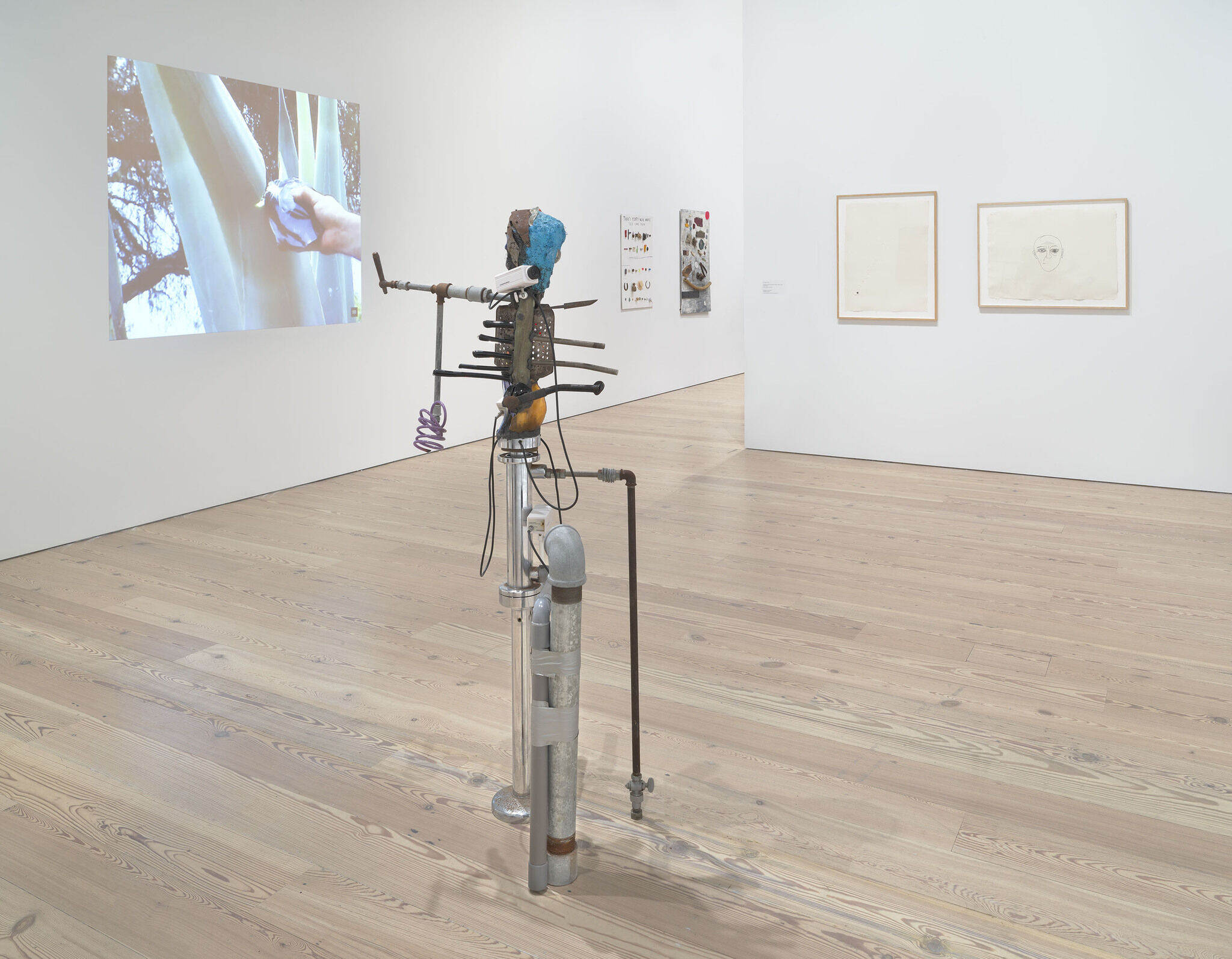

Installation view of Jimmie Durham: At the Center of the World (Whitney Museum of American Art, New York, November 3, 2017–January 28, 2018). From left to right: Obsidiana, 2009; The Doorman, 2009; THERE’S PLENTY MORE WHERE THESE CAME FROM, 2008; Snake Eyes!, 2006; Obsidiana mexican, homenaje a Fontana, Mexico, 2009; Obsidian tongue, 2009. Photograph by Ron Amstutz
-
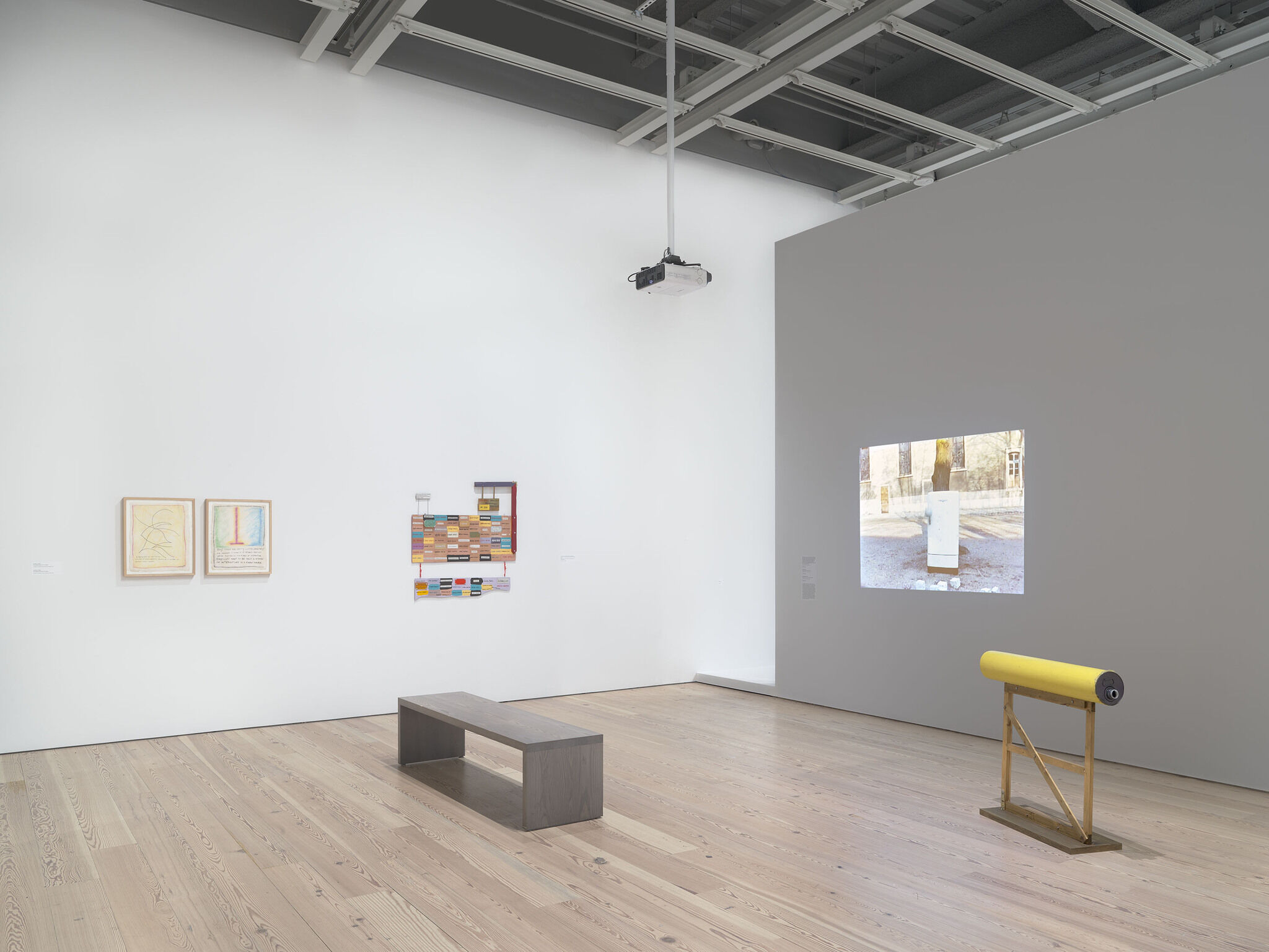

Installation view of Jimmie Durham: At the Center of the World (Whitney Museum of American Art, New York, November 3, 2017–January 28, 2018). From left to right: Science I, 1990; Science II, 1990; The names of the team of scientists who published an article on human chromosome 14 in Nature magazine, 2003; Collected Stones: 13 short videos (Incident at Middelburg,1996; A Stone from Metternich’s House in Bohemia, 1996; 13 Rue Fenelon, 1996; Enough!, 1995; A Heavy Stone, 1996;HTV, 1996; Pink Granite at Work, 1997; Un Projet à Lille,1996; Nature Morte, 2000; Towards Light, 1999–2002;A Stone at Home in Bed Asleep, 2000; Stoning the Refrigerator, 1996; Brazilian Bloodstone, 1997), 1995-2002; Yellow Higgs Transmitting Apparatus, 2013. Photograph by Ron Amstutz
-
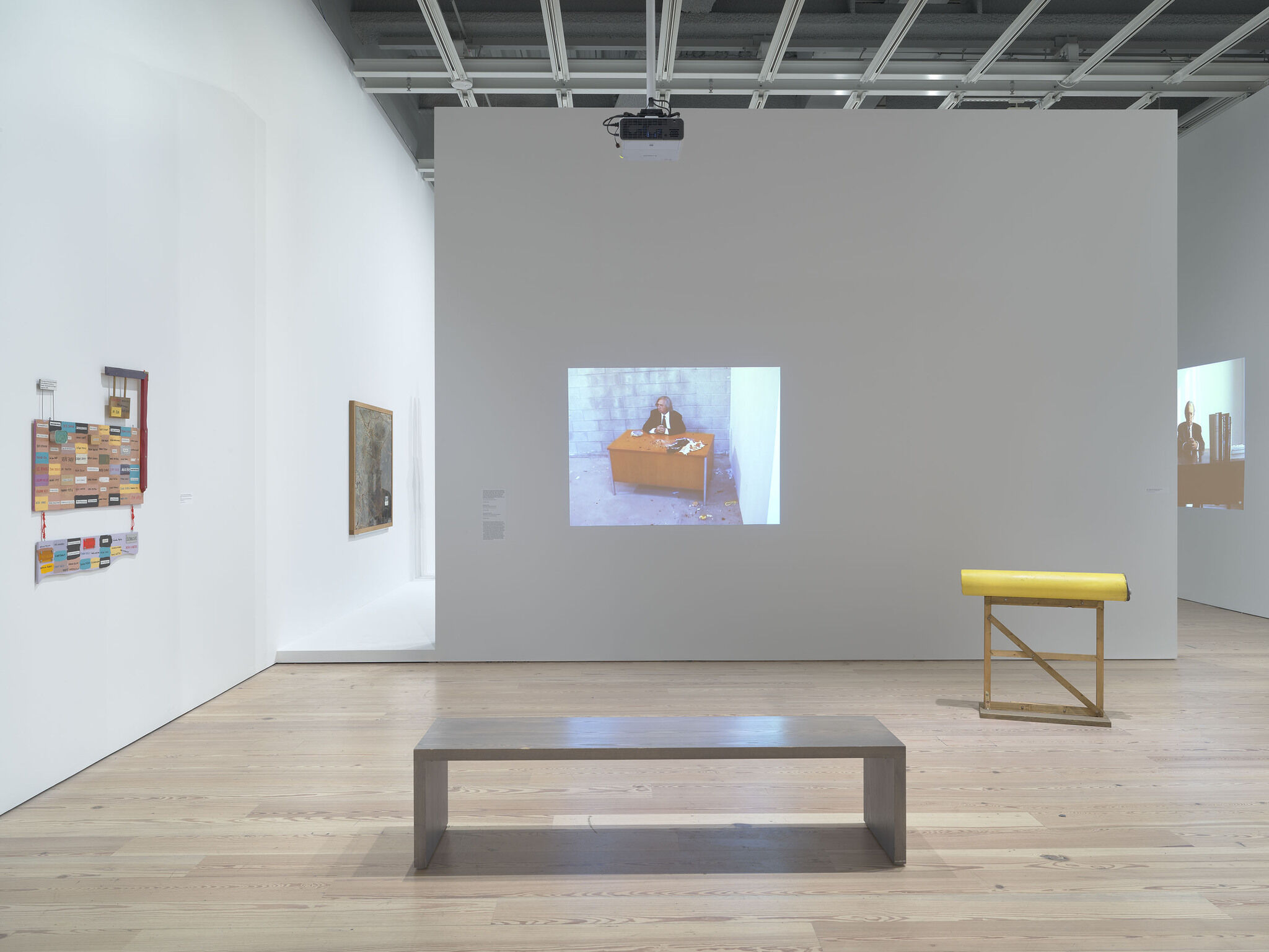

Installation view of Jimmie Durham: At the Center of the World (Whitney Museum of American Art, New York, November 3, 2017–January 28, 2018). From left to right: The names of the team of scientists who published an article on human chromosome 14 in Nature magazine, 2003; Belo Horizonte, 2013; Smashing, 2004; Yellow Higgs Transmitting Apparatus, 2013; Obsidiana, 2009. Photograph by Ron Amstutz
-
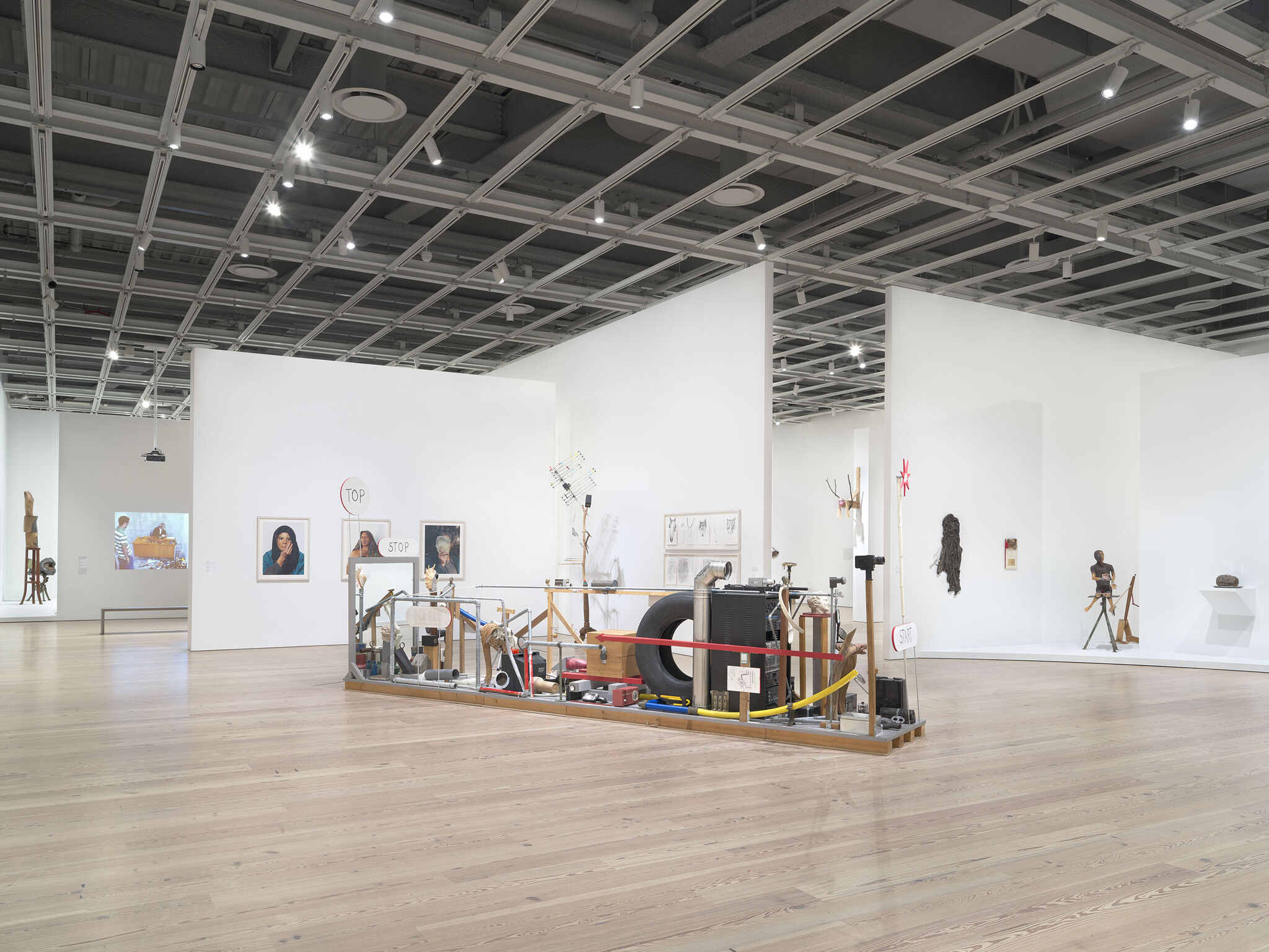

Installation view of Jimmie Durham: At the Center of the World (Whitney Museum of American Art, New York, November 3, 2017–January 28, 2018). From left to right: The Forest and Brancusi, 2012; Elephant Skull Study #2, 2012; Smashing, 2004; Self-Portrait Pretending to be Maria Thereza Alves, 1995-2006; Self-Portrait Pretending to be Rosa Levy, 1994; Self-Portrait Pretending to Be a Stone Statue of Myself, 2006; Something…Perhaps a Fugue or an Elegy, 2005; The Bluebird of Happiness and the Miner’s Canary (Classic Rock), 2008; Drawn Lines and Faces, 1998; Three Faces, 1998; Over the River and Through the Woods, 1989; Confessional, 2006; Wahlverwandtschaften [Elective affinities], 1992; Jesus (Es geht um die Wurst) [Jesus (It’s all about the sausage)], 1992; Untitled (It’s Got Mr. Durham’s Teeth), 1992; Head, 2006. Photograph by Ron Amstutz
-
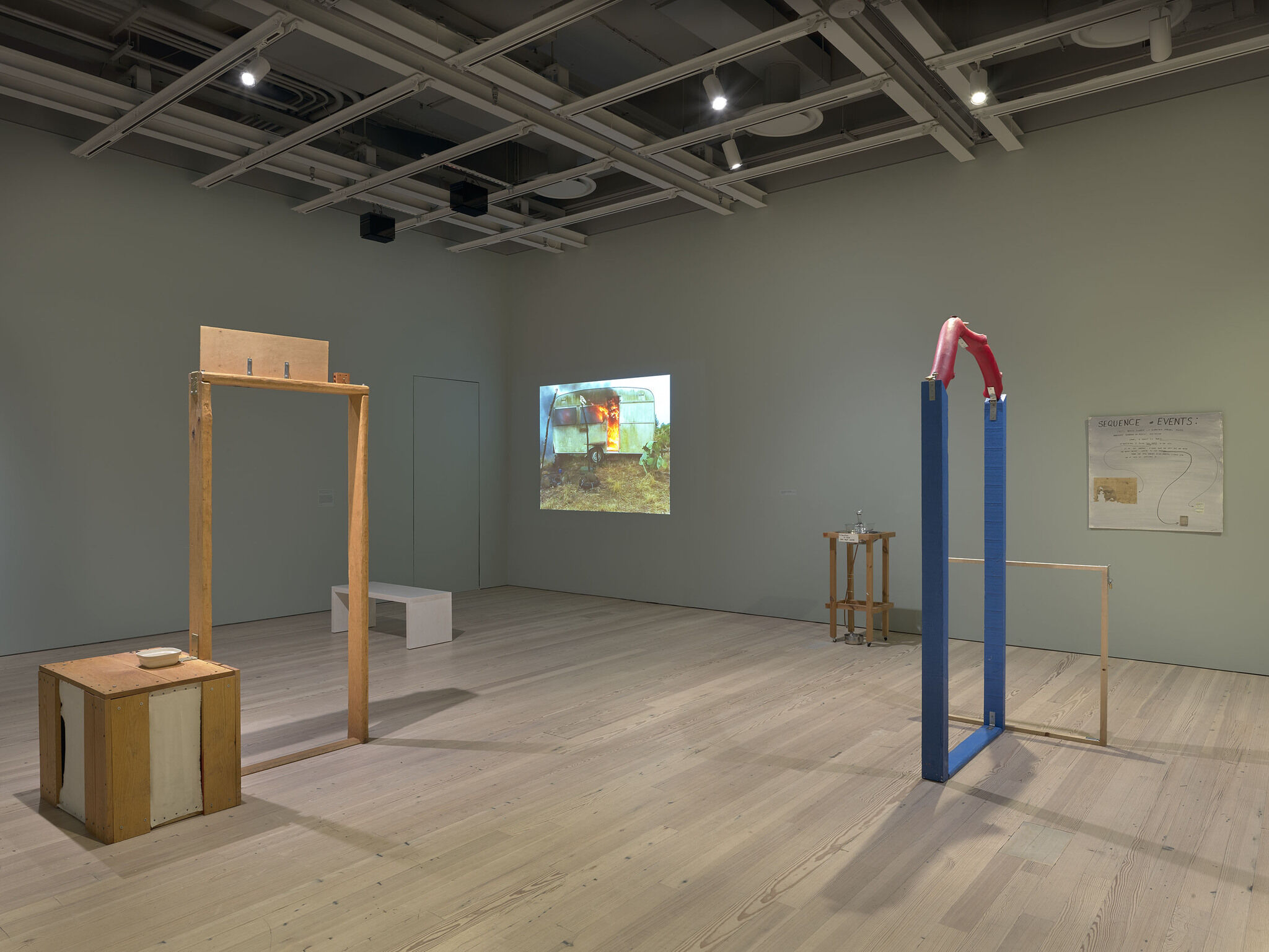

Installation view of Jimmie Durham: At the Center of the World (Whitney Museum of American Art, New York, November 3, 2017–January 28, 2018). From left to right: Forbidden Things, 1993; La Poursuite du Bonheur, 2002; A Fountain in Case Your Roof Leaks, 1996; Arc de Triomphe for Personal Use, 1996; Sequence of Events, 1993. Photograph by Ron Amstutz
-
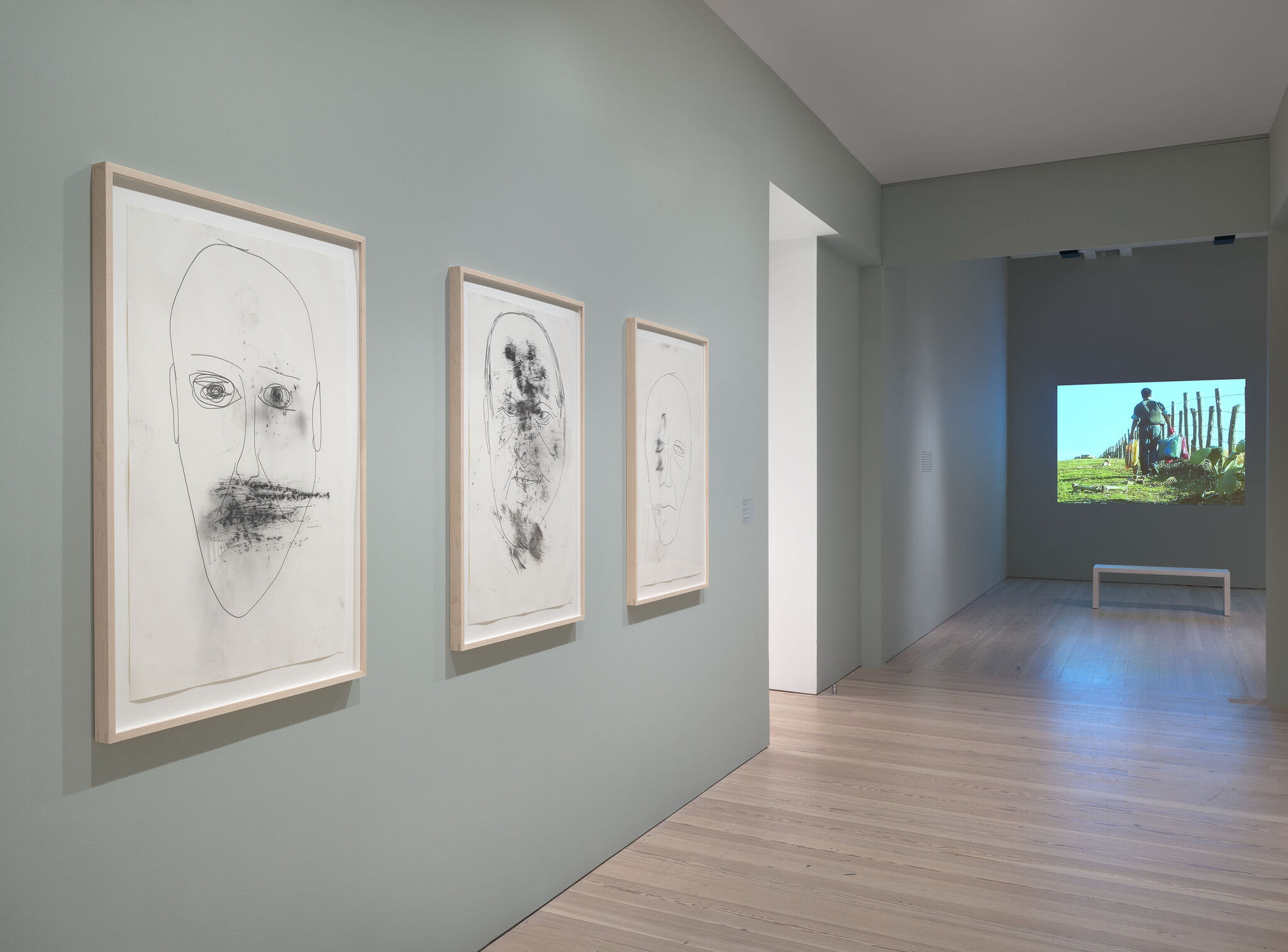

Installation view of Jimmie Durham: At the Center of the World (Whitney Museum of American Art, New York, November 3, 2017–January 28, 2018). From left to right: Untitled (Damaged face drawings), 2006; Untitled (Damaged face drawings), 2006; Untitled (Damaged face drawings), 2006; La Poursuite du Bonheur, 2002. Photograph by Ron Amstutz
-
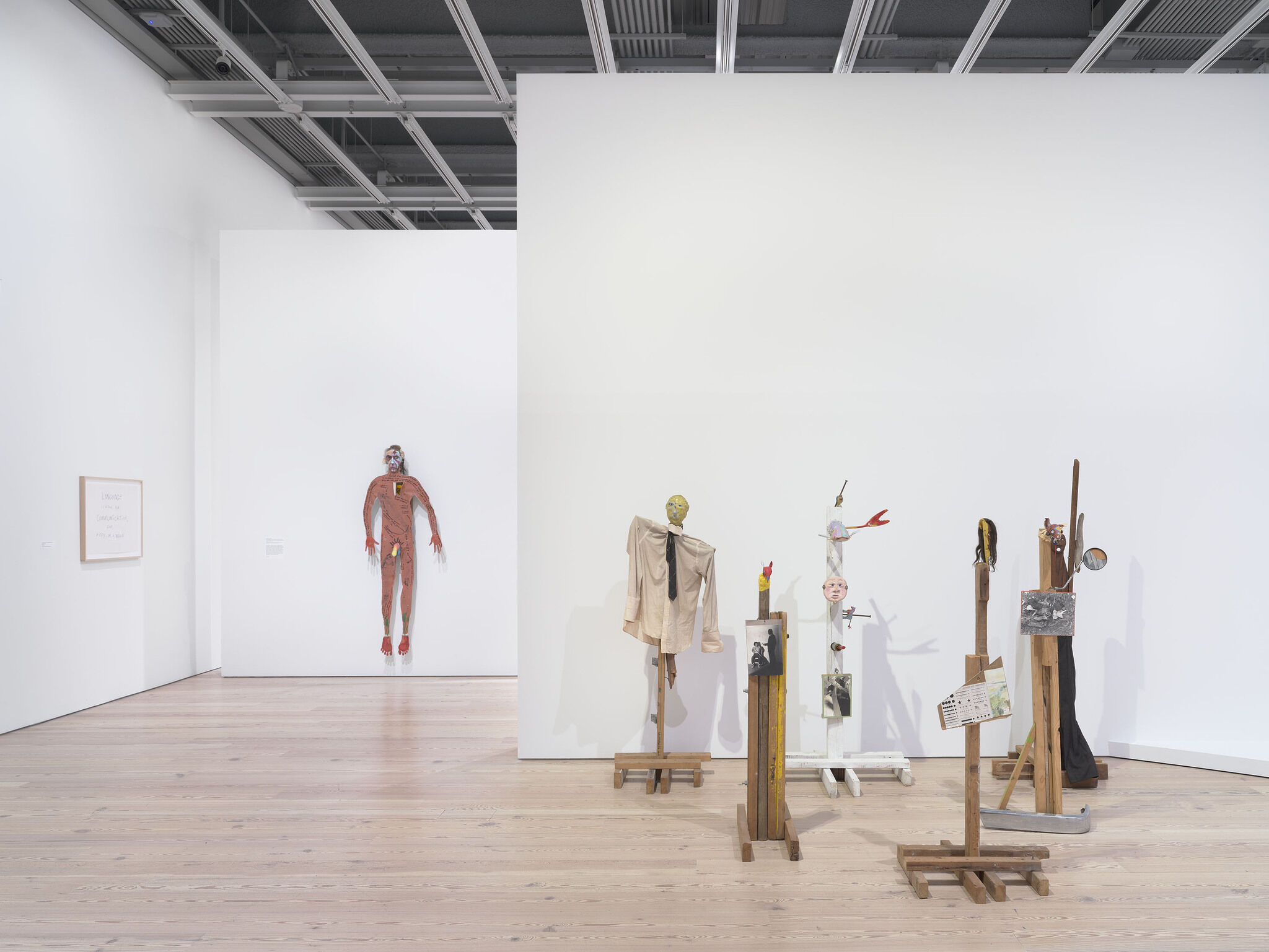

Installation view of Jimmie Durham: At the Center of the World (Whitney Museum of American Art, New York, November 3, 2017–January 28, 2018). From left to right: Language is a tool for communication, like a city, or a brain, 1992; Self-portrait, 1986; Ahead, 1991; Untitled (Armadillo), 1991; Untitled, 1991; Half Off, 1991; Raccoon (Skunk), 1989; Would and Cotton, 1991. Photograph by Ron Amstutz
-
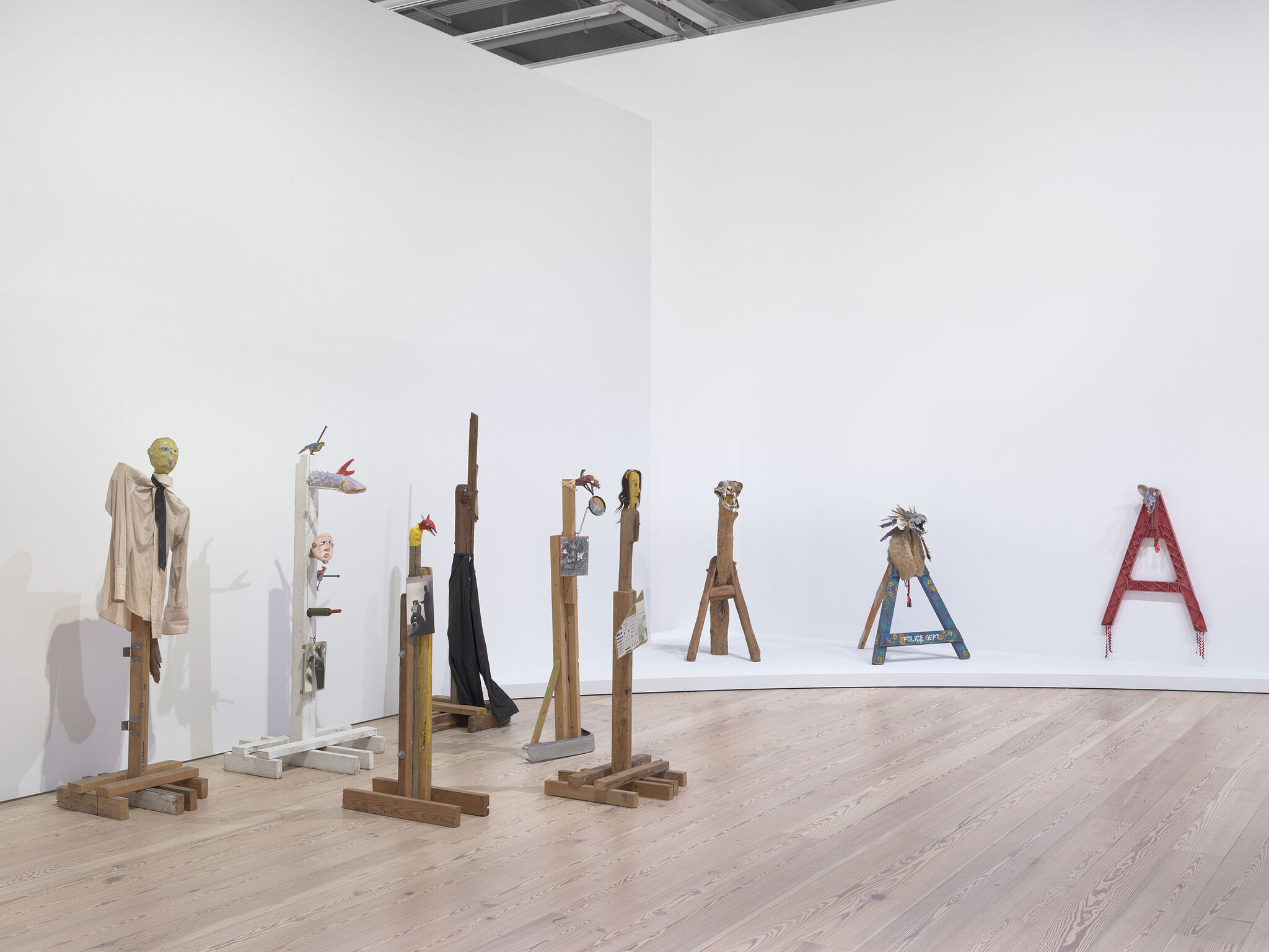

Installation view of Jimmie Durham: At the Center of the World (Whitney Museum of American Art, New York, November 3, 2017–January 28, 2018). From left to right: Ahead, 1991; Untitled, 1991; Untitled (Armadillo), 1991; Would and Cotton, 1991; Raccoon (Skunk), 1989; Half Off, 1991; Wahya, 1984; Tlunh Datsi, 1984; New York Gitli, 1984. Photograph by Ron Amstutz
-
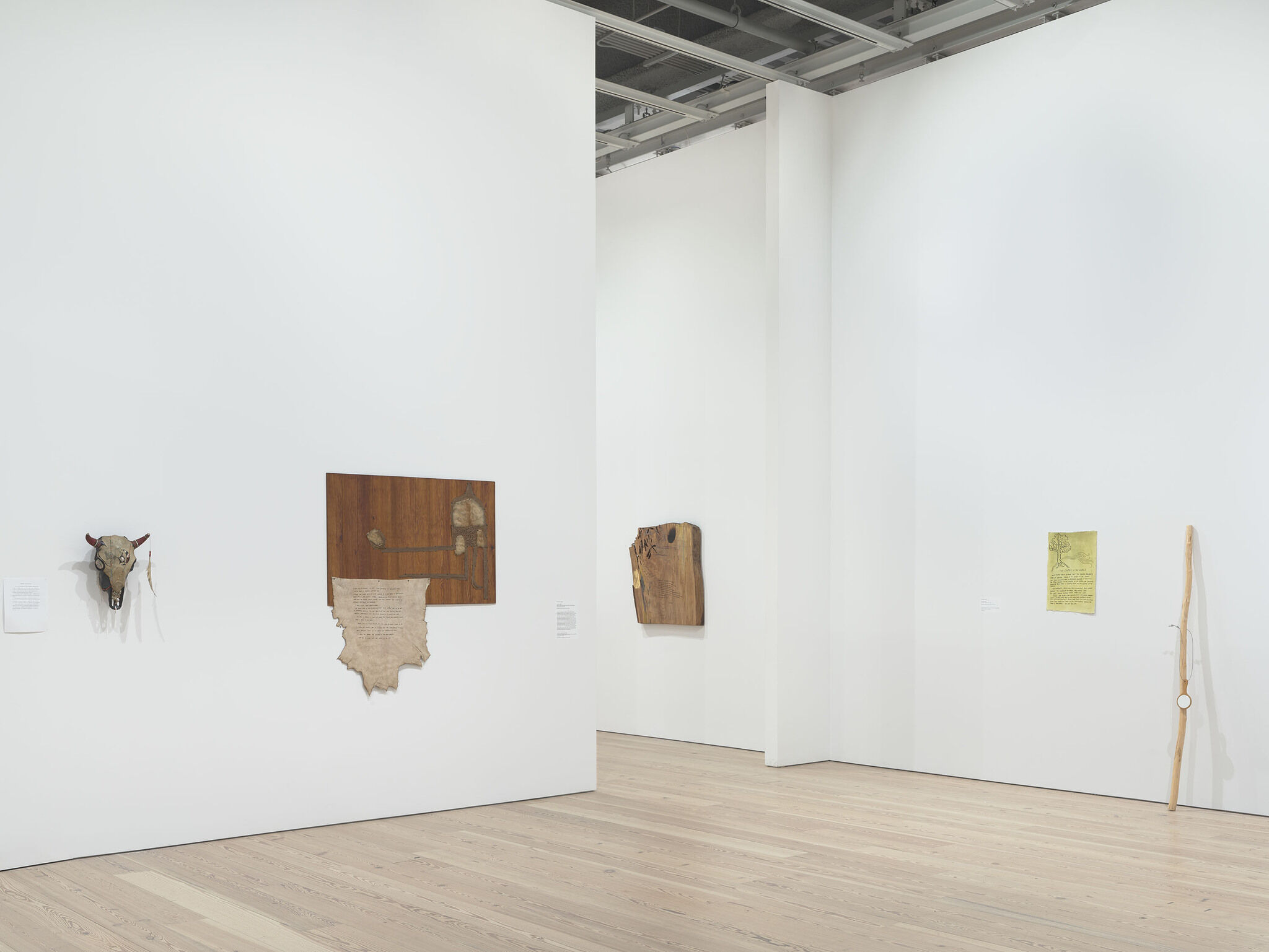

Installation view of Jimmie Durham: At the Center of the World (Whitney Museum of American Art, New York, November 3, 2017–January 28, 2018). From left to right: Untitled, 1982; I will try to explain, 1970-2012; Slash and Burn, 2007; Anti Flag, 1992; A Pole to Mark the Center of the World in Berlin, 2004. Photograph by Ron Amstutz
-
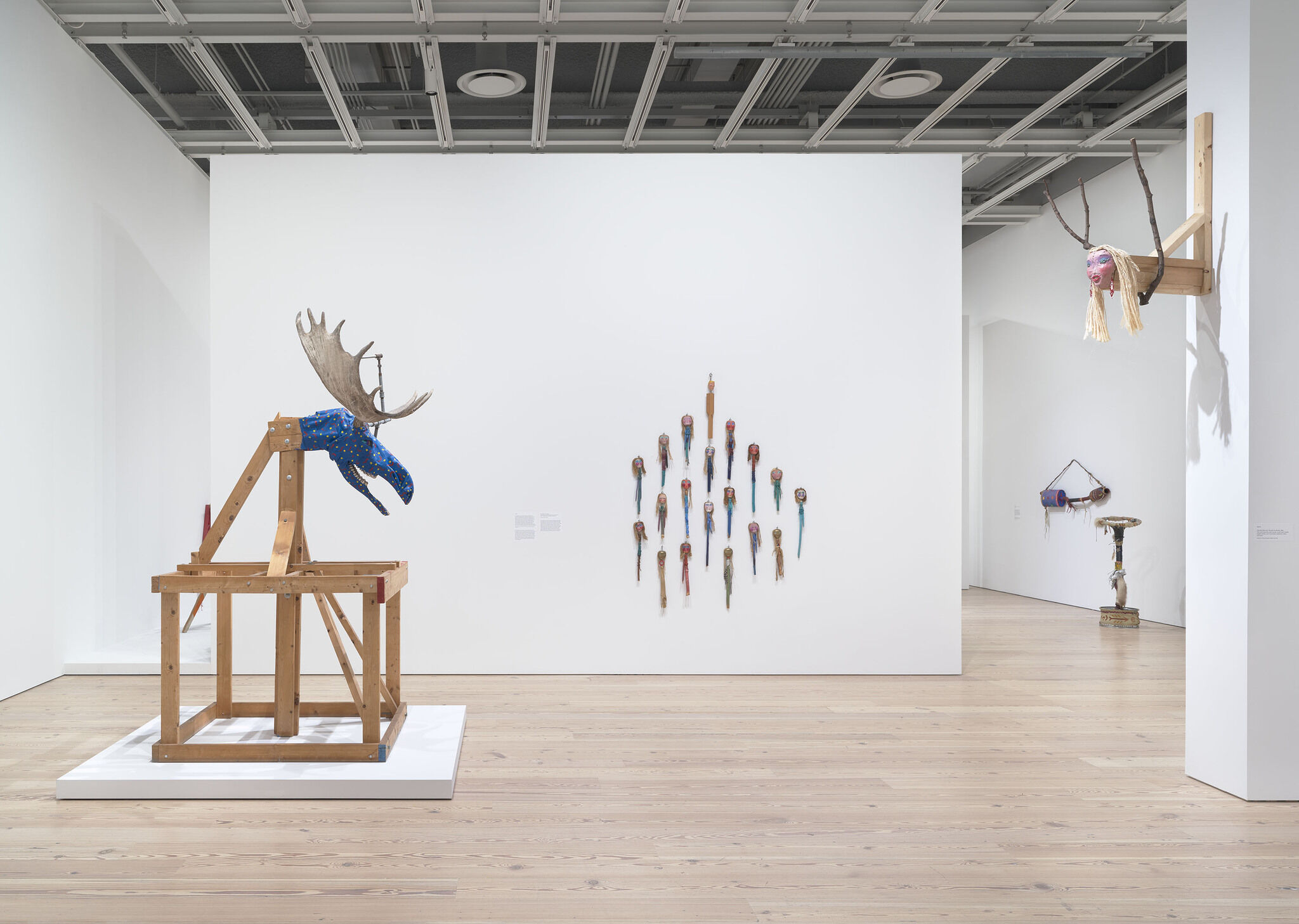

Installation view of Jimmie Durham: At the Center of the World (Whitney Museum of American Art, New York, November 3, 2017–January 28, 2018). From left to right: The Cathedral of St. John the Divine in Manhattan is the World’s Largest Gothic Cathedral. Except, of course, that it is a fake; first by the simple fact of being built in Manhattan, at the turn of the century. But the stone work is also re-inforced with steel which is expanding with rust. Someday it will destroy the stone. The Cathedral is in Morningside Heights over-looking a panoramic view of Harlem which is separated by a high fence, 1989; New Clear Family, 1989; Bedia’s Muffler, 1985; Bedia’s Stirring Wheel, 1985; Over the River and Through the Woods, 1989. Photograph by Ron Amstutz
-
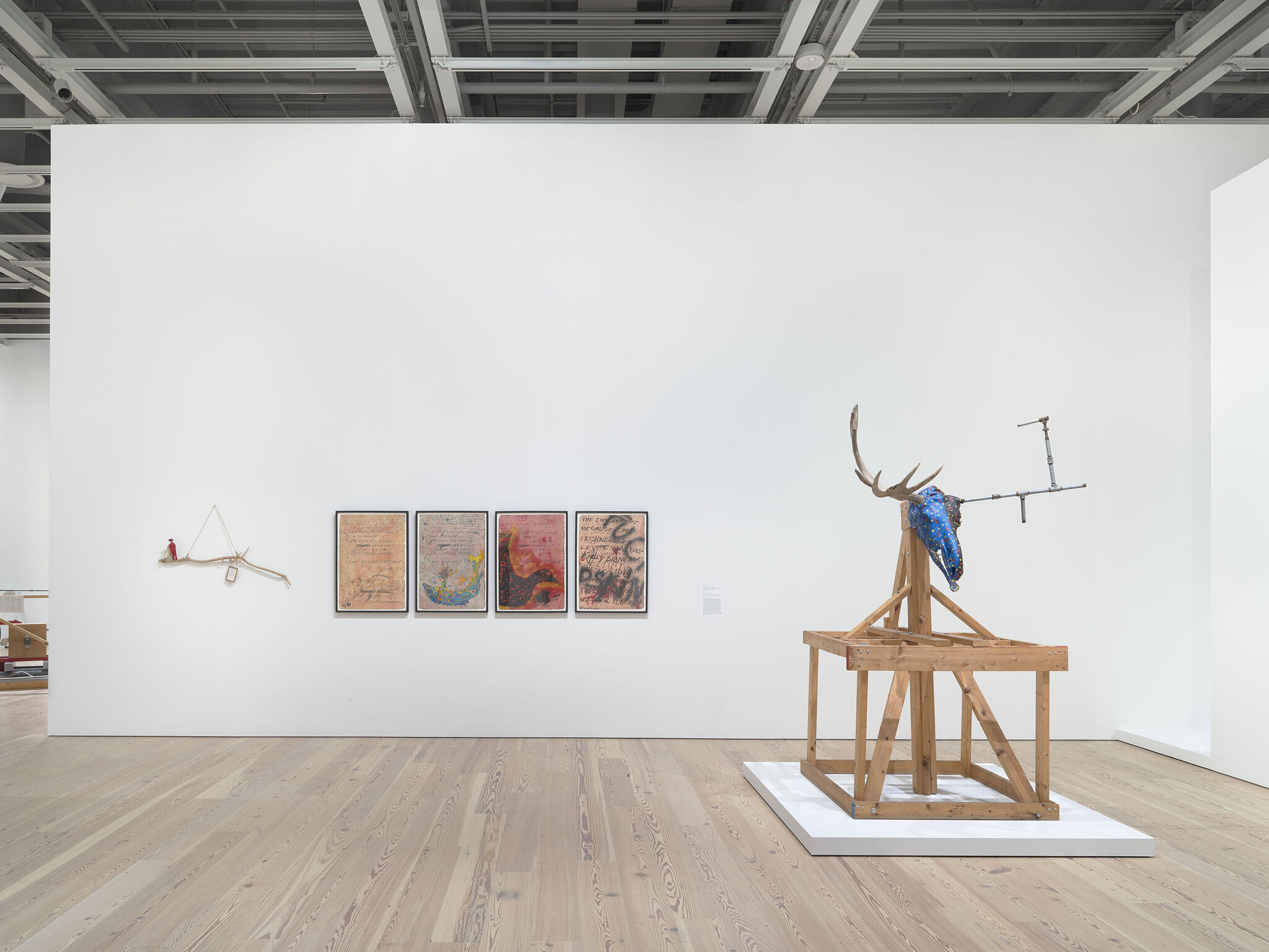

Installation view of Jimmie Durham: At the Center of the World (Whitney Museum of American Art, New York, November 3, 2017–January 28, 2018). From left to right: The Arrogant Little Peasant, 1989; Zeke Proctor’s Letter, 1989; The Cathedral of St. John the Divine in Manhattan is the World’s Largest Gothic Cathedral. Except, of course, that it is a fake; first by the simple fact of being built in Manhattan, at the turn of the century. But the stone work is also re-inforced with steel which is expanding with rust. Someday it will destroy the stone. The Cathedral is in Morningside Heights over-looking a panoramic view of Harlem which is separated by a high fence, 1989. Photograph by Ron Amstutz
-
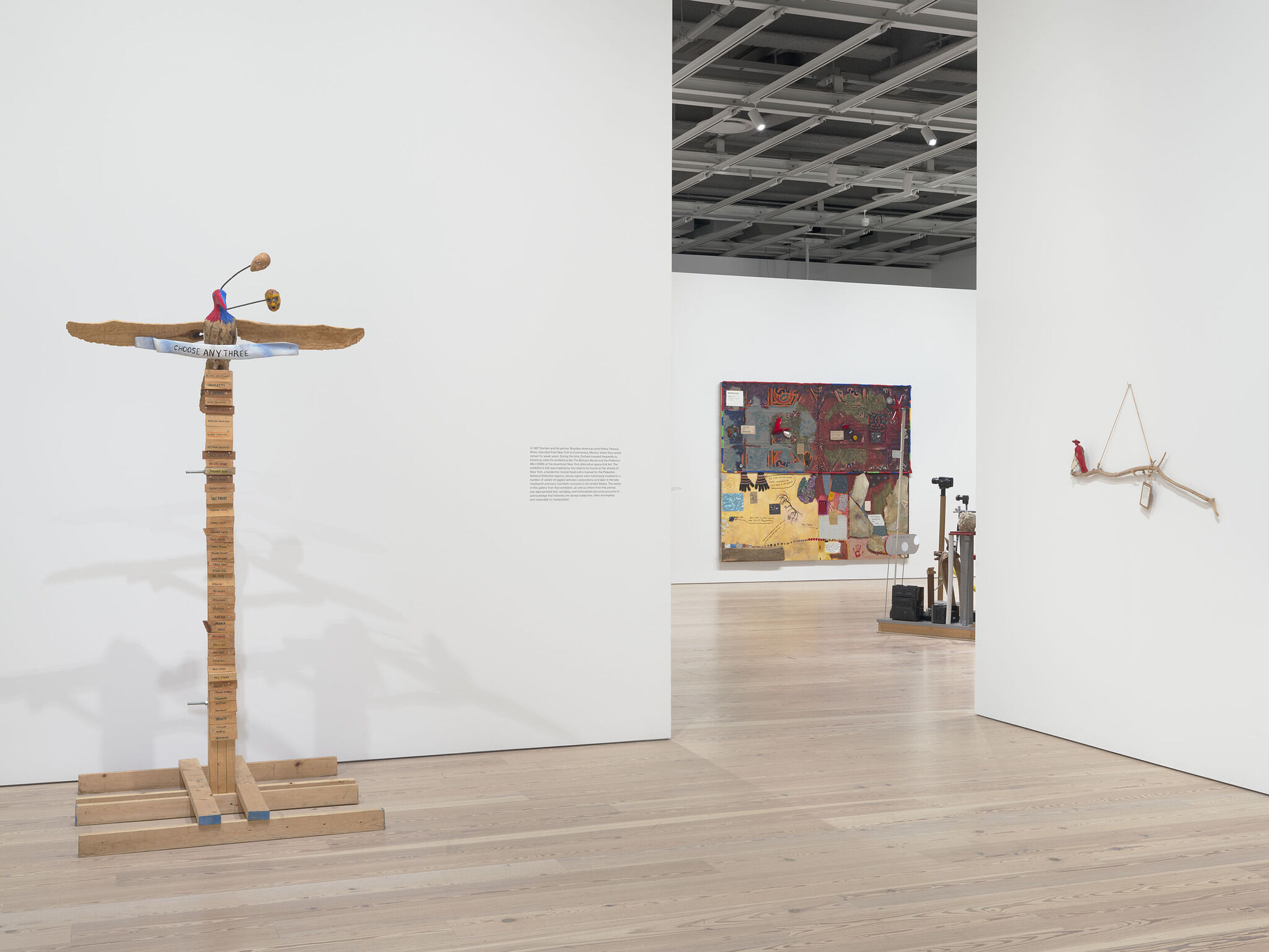

Installation view of Jimmie Durham: At the Center of the World (Whitney Museum of American Art, New York, November 3, 2017–January 28, 2018). From left to right: Choose Any Three, 1989; Various Elements from the Actual World, 2009; Something…Perhaps a Fugue or an Elegy, 2005; The Arrogant Little Peasant, 1989. Photograph by Ron Amstutz
-
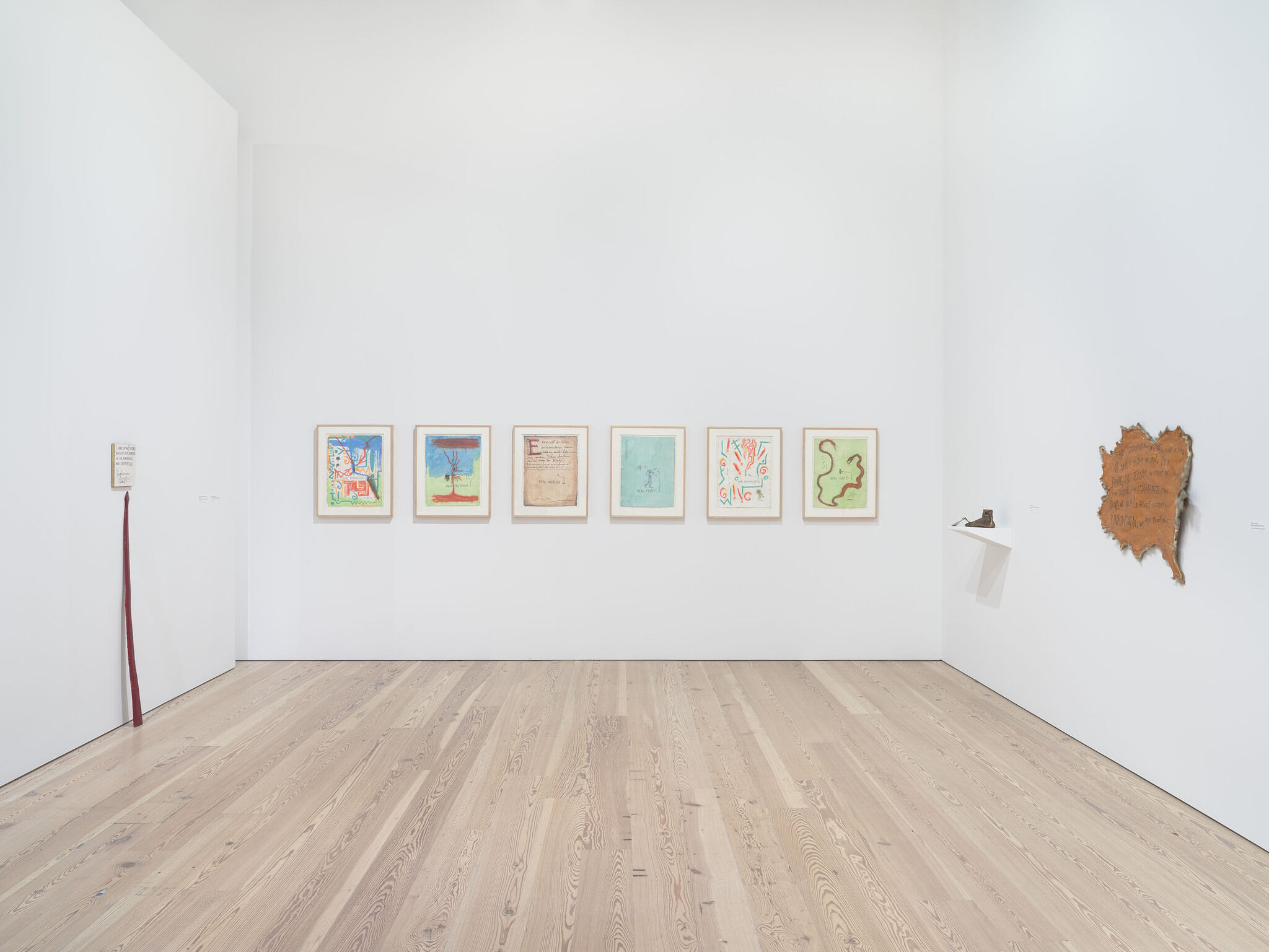

Installation view of Jimmie Durham: At the Center of the World (Whitney Museum of American Art, New York, November 3, 2017–January 28, 2018). From left to right: Articles 2 and 3 from the 1986 Pinkerton’s Agency Manual, 1989; Six Authentic Things, 1989; Footnote, 1989; Tradition, 1989. Photograph by Ron Amstutz
-
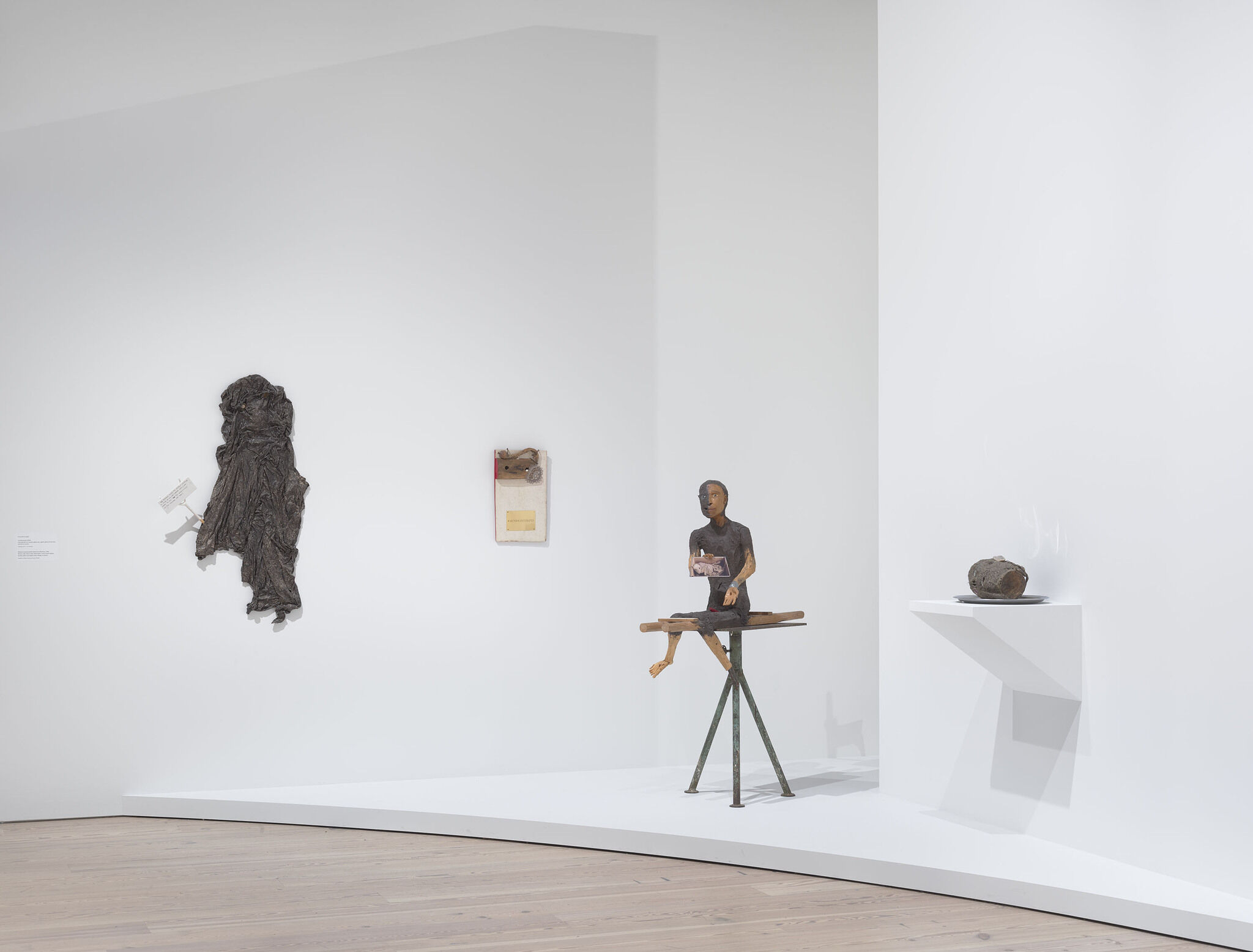

Installation view of Jimmie Durham: At the Center of the World (Whitney Museum of American Art, New York, November 3, 2017–January 28, 2018). From left to right: Confessional, 2006; Wahlverwandtschaften [Elective affinities], 1992; Jesus (Es geht um die Wurst) [Jesus (It’s all about the sausage)], 1992; Head, 2006. Photograph by Ron Amstutz
-
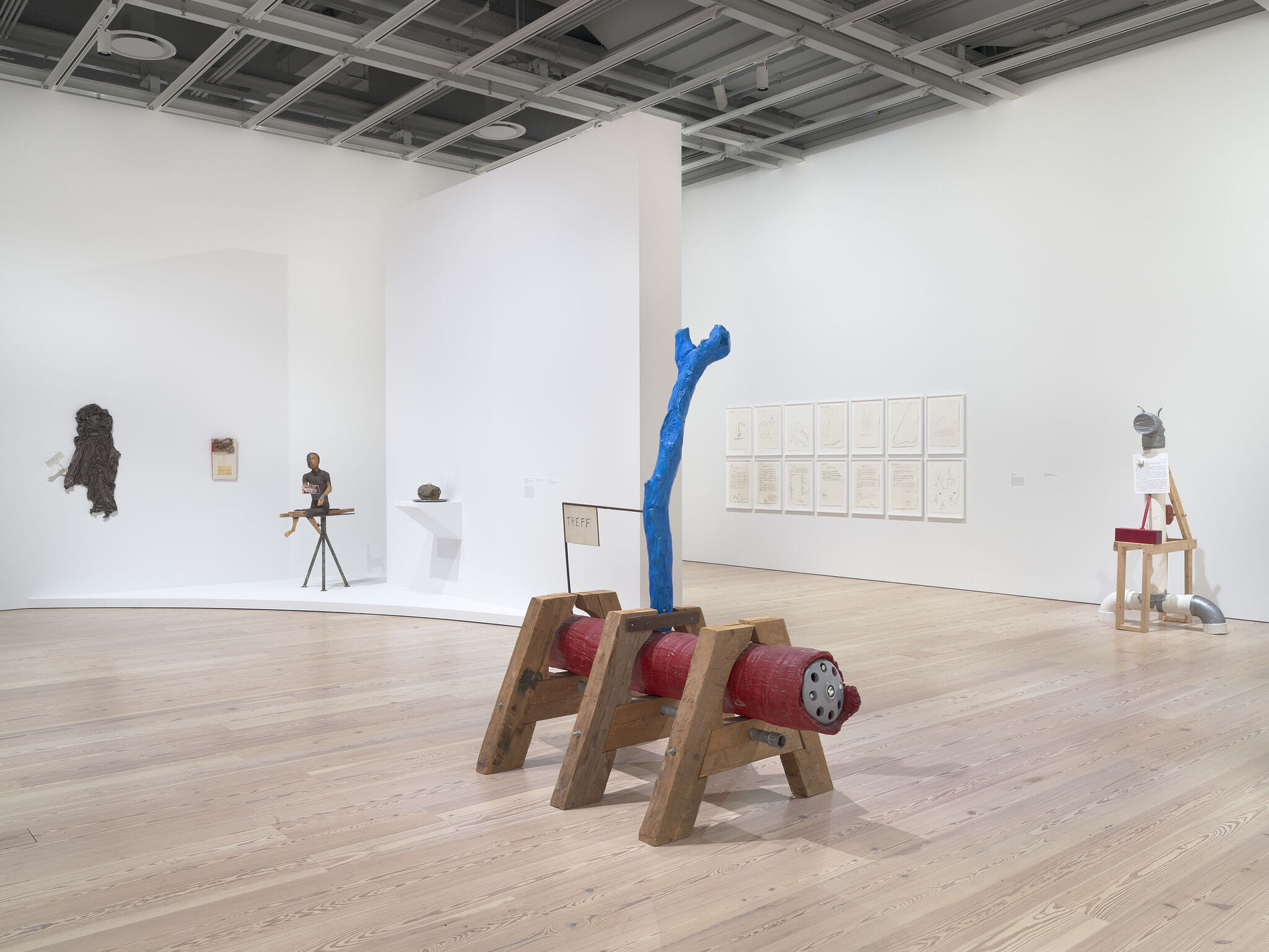

Installation view of Jimmie Durham: At the Center of the World (Whitney Museum of American Art, New York, November 3, 2017–January 28, 2018). From left to right: Confessional, 2006; Wahlverwandtschaften [Elective affinities], 1992; Jesus (Es geht um die Wurst) [Jesus (It’s all about the sausage)], 1992; Head, 2006; Treff [Encounter], 1992; Caliban Codex, 1992; The Guardian (free tickets), 1992. Photograph by Ron Amstutz
-
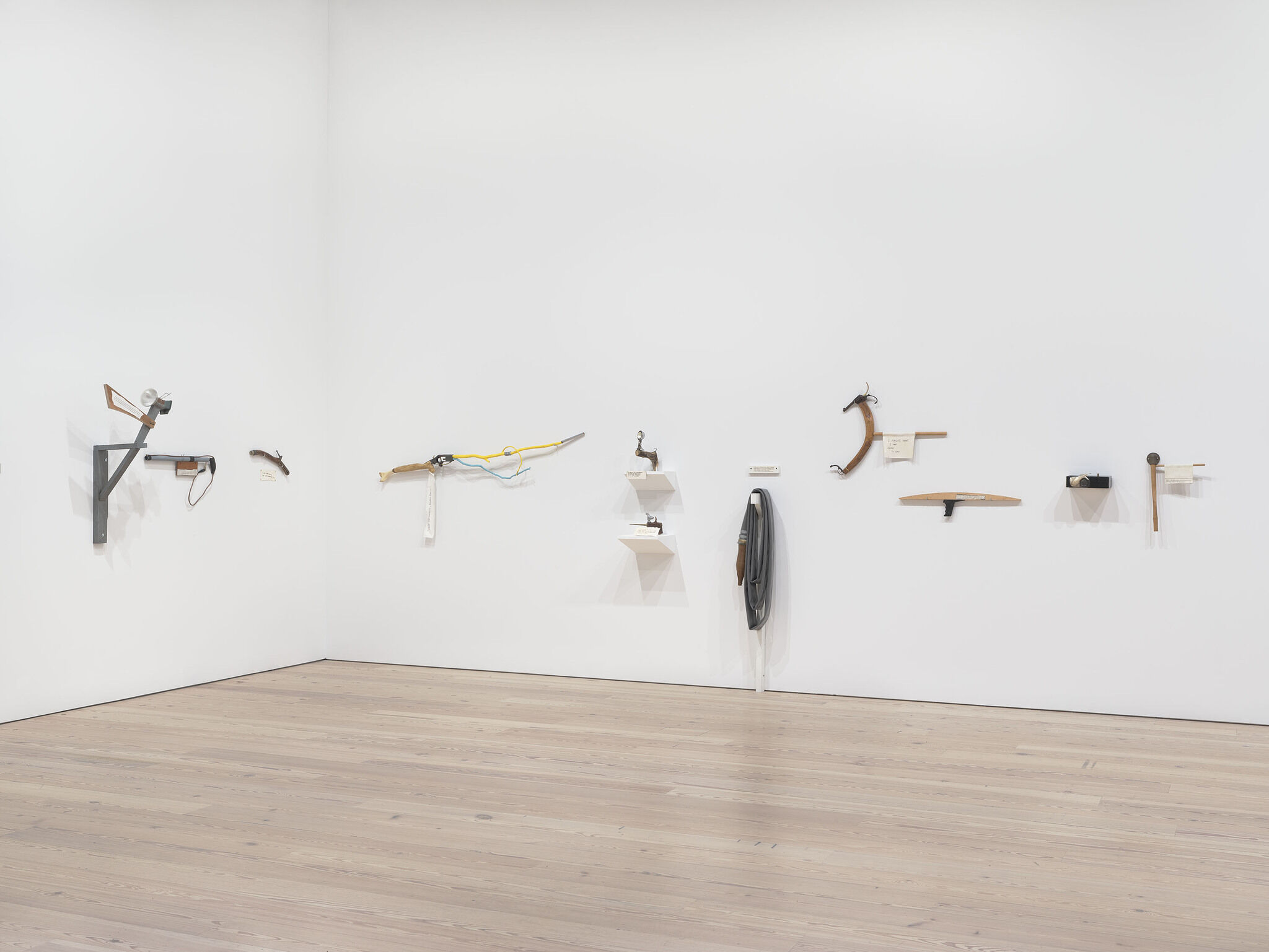

Installation view of Jimmie Durham: At the Center of the World (Whitney Museum of American Art, New York, November 3, 2017–January 28, 2018). From left to right: Sonderbar kam es mir vor, daß sie diese Übung an einer alten Stadtmauer ohne die mindeste Bequemlichkeit für die Zuschauer vornehmen; warum sie es nicht im Amphitheater tun, wo so schöner Raum wäre!, 1993–2012; So saß sie, wenn sie nicht liegen musste, in Gesellschaft der Rätin Spatz, verhielt sich still und hing, eine Handarbeit im Schoße, an der sie nicht arbeitete, diesem oder jenem Gedanken nach., 1993; Tu ne cede malis, sed contra audentior ito., 1993; False Orthografie, Broken English, 1993; In flaming fire take vengeance upon them that know not God and that obey not the gospel of our Lord Jesus Christ., 1993; He bid his Angels turn askance the poles of Earth twice ten degrees and more from the sun’s axle; they with labor pushed oblique the centric globe:, 1993; Весь этот и следующий день друзья и товарищи Рóстова замечали, что он не скучен, не сердит, но молчалив, задумчив и сосредоточен. Он неохотно пил, старался оставаться один и о чем-то все думал, 1993; I Forgot What I Was Going to Say, 1992; Mishap in the jungle. The rest of them were mostly Indians: tough young fellows with wiry strength and impassive faces. The withest, 1993; Behold my hands and my feet, that is myself: Handle me and see; for a spirit hath not flesh and bones-as ye see me have., 1993; ελθων δ΄ εξ ορεος μεϒας αιετος αϒκυλοχειλης πασι κατ΄ αυχενας ηξε και εκτανεν, 1993. Photograph by Ron Amstutz
-
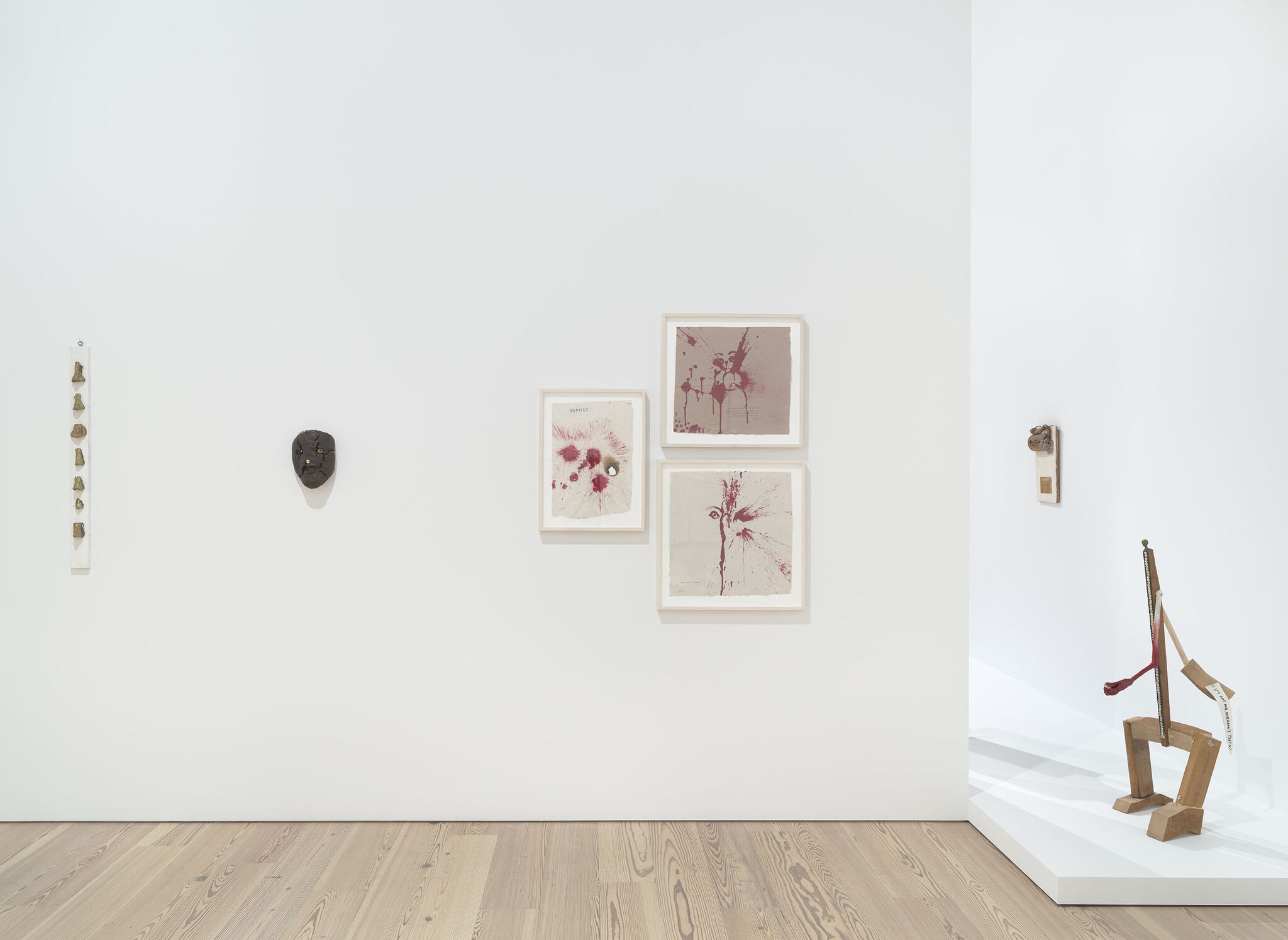

Installation view of Jimmie Durham: At the Center of the World (Whitney Museum of American Art, New York, November 3, 2017–January 28, 2018). From left to right: Some noses, 1992; Untitled (Caliban’s Mask), 1992; Poppies, 1992; Not Caliban’s Nose, 1992; Small action painting, 1992; Wahlverwandtschaften [Elective affinities], 1992; Untitled (It’s Got Mr. Durham’s Teeth), 1992. Photograph by Ron Amstutz
-
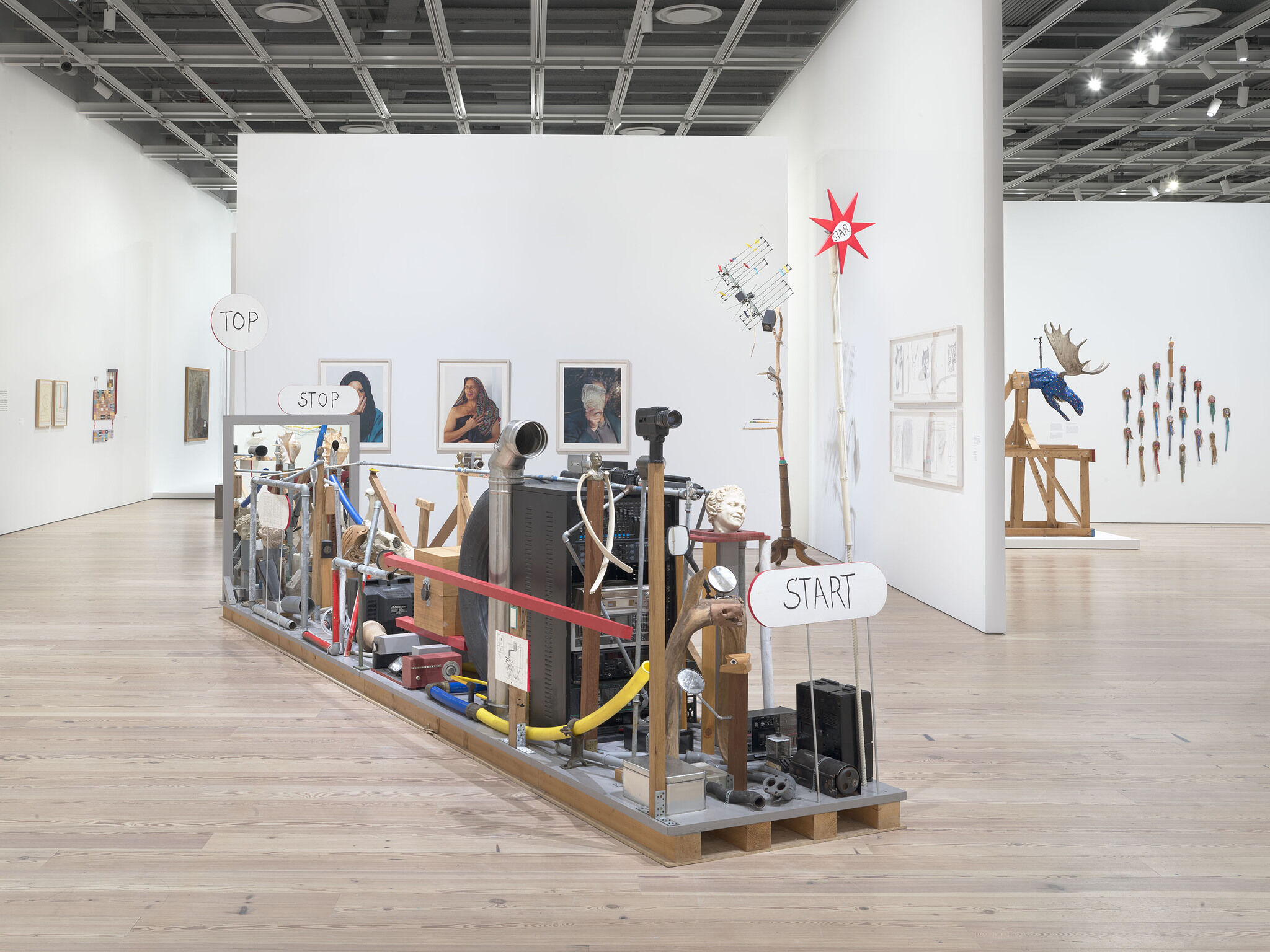

Installation view of Jimmie Durham: At the Center of the World (Whitney Museum of American Art, New York, November 3, 2017–January 28, 2018). From left to right: Science I, 1990; Science II, 1990; The Names of the team of scientists who published an article on human chromosome 14 in Nature magazine, 2003; Belo Horizonte, 2013; Something . . . Perhaps a Fugue or an Elegy, 2005; Self-Portrait Pretending to be Maria Thereza Alves, 1995-2006; Self-Portrait pretending to be Rosa Levy, 1994; Self-Portrait Pretending to Be a Stone Statue of Myself, 2006; The Bluebird of Happiness and the Miner’s Canary (Classic Rock), 2008; Drawn Lines and Faces, 1998; Three Faces, 1998; The Cathedral of St. John the Divine in Manhattan is the World’s Largest Gothic Cathedral. Except, of course, that it is a fake; first by the simple fact of being built in Manhattan, at the turn of the century. But the stone work is also re-inforced with steel which is expanding with rust. Someday it will destroy the stone. The Cathedral is in Morningside Heights over-looking a panoramic view of Harlem which is separated by a high fence, 1989; New Clear Family, 1989. Photograph by Ron Amstutz
-
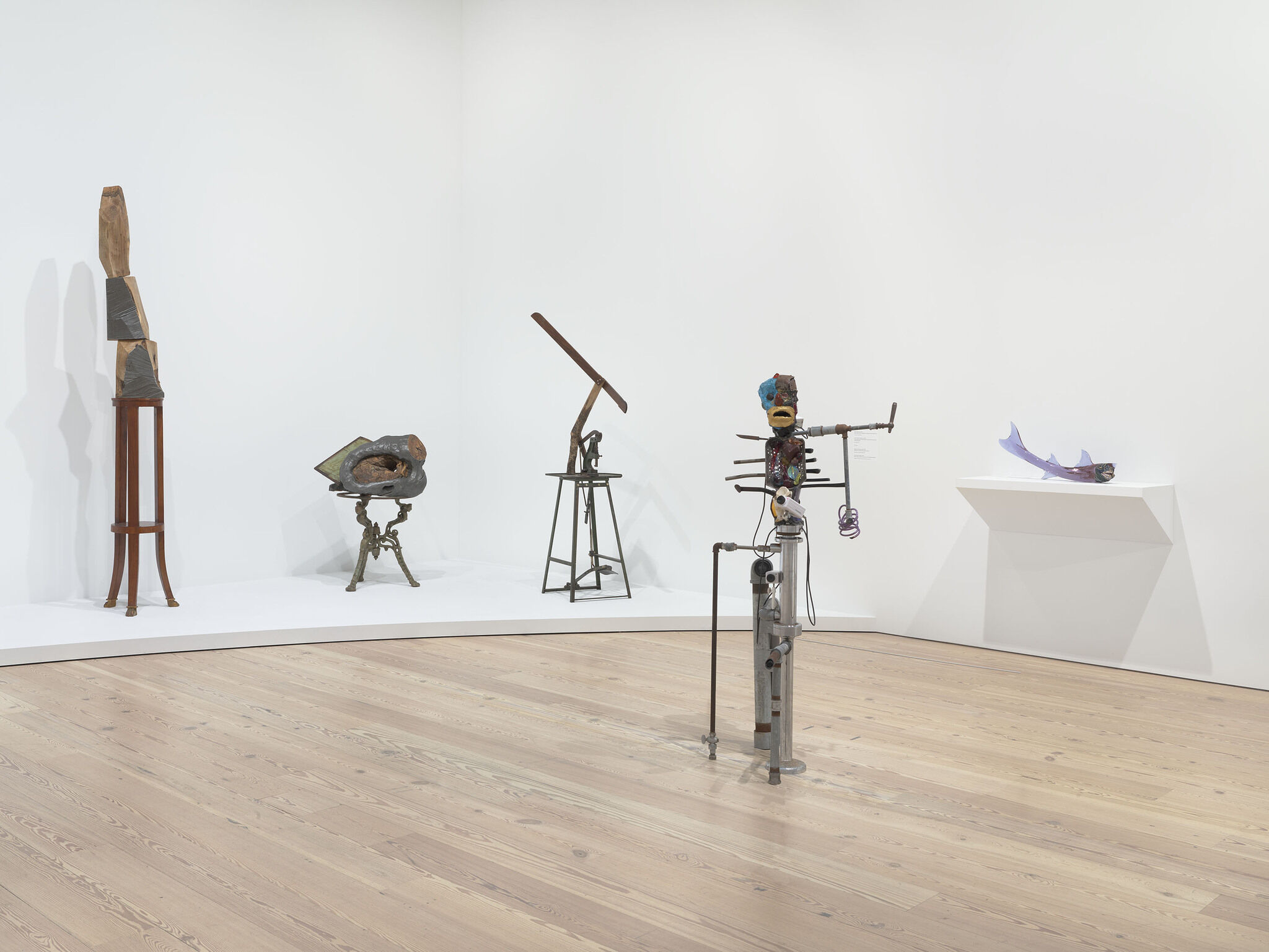

Installation view of Jimmie Durham: At the Center of the World (Whitney Museum of American Art, New York, November 3, 2017–January 28, 2018). From left to right: The Forest and Brancusi, 2012; Elephant Skull Study #2, 2012; This should explain, 2012; The Doorman, 2009; Carnivalesque Shark in Venice, 2015. Photograph by Ron Amstutz
-
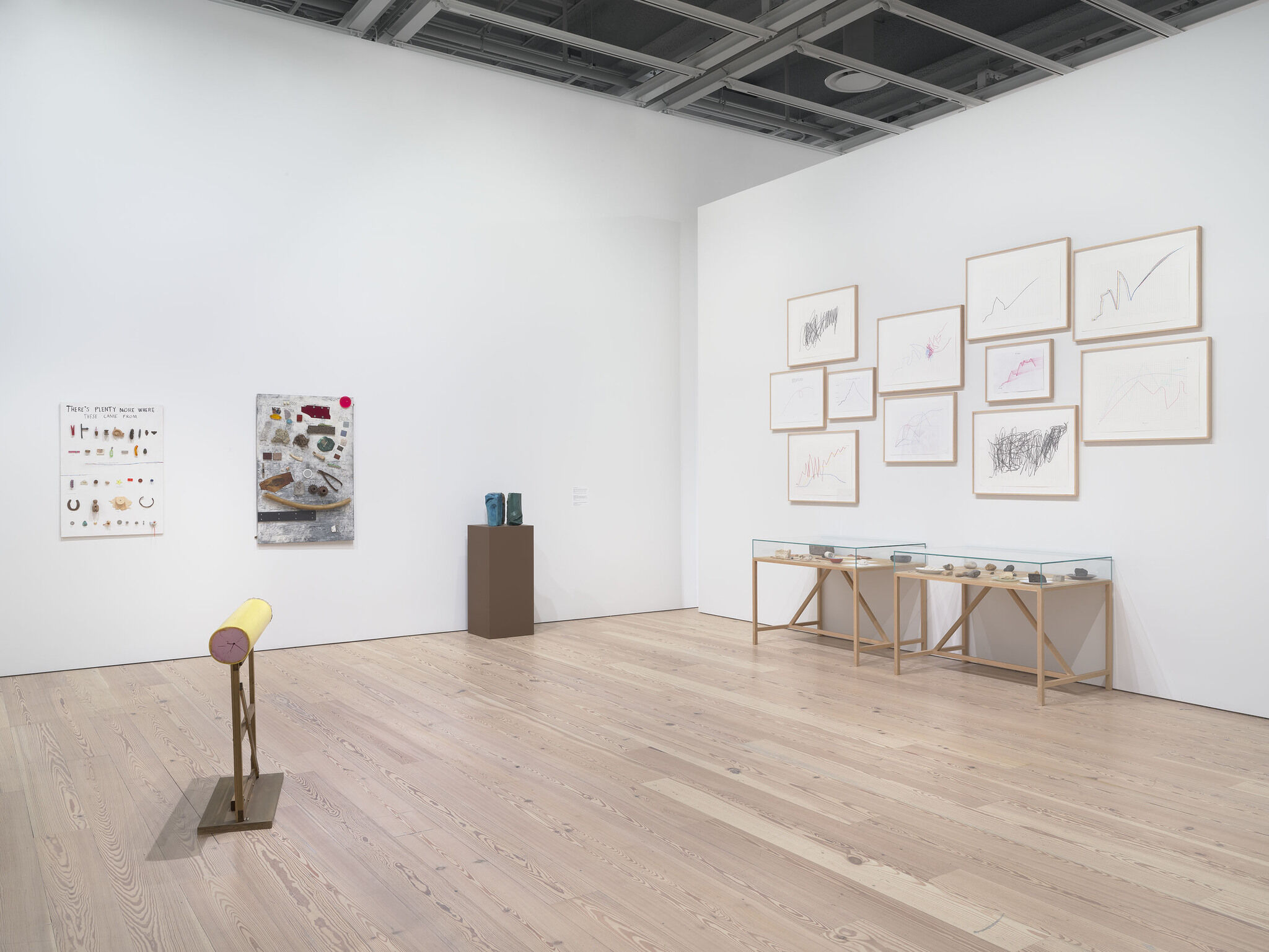

Installation view of Jimmie Durham: At the Center of the World (Whitney Museum of American Art, New York, November 3, 2017–January 28, 2018). From left to right: THERE’S PLENTY MORE WHERE THESE CAME FROM, 2008; Yellow Higgs Transmitting Apparatus, 2013; Snake Eyes!, 2006; The Effect of Gamma Rays on Certain European Plants-Volume III, 2014; Untitled (One a Scale of One Through Ten, Recalcitrant Trends, III Wind, Seven Lines Indicating Various Colors and Trends, The Turquoise Line is Probably Indicative, Red and Blue Meeting, Water, Lightning and Anger, Clearly, Not Everything Functions, Indications of the Frequent Escape Mechanisms of Clarity, From Normality…, More a Process than a Beginning and an End), 2013; The Dangers of Petrification II, 1998-2007. Photograph by Ron Amstutz
-
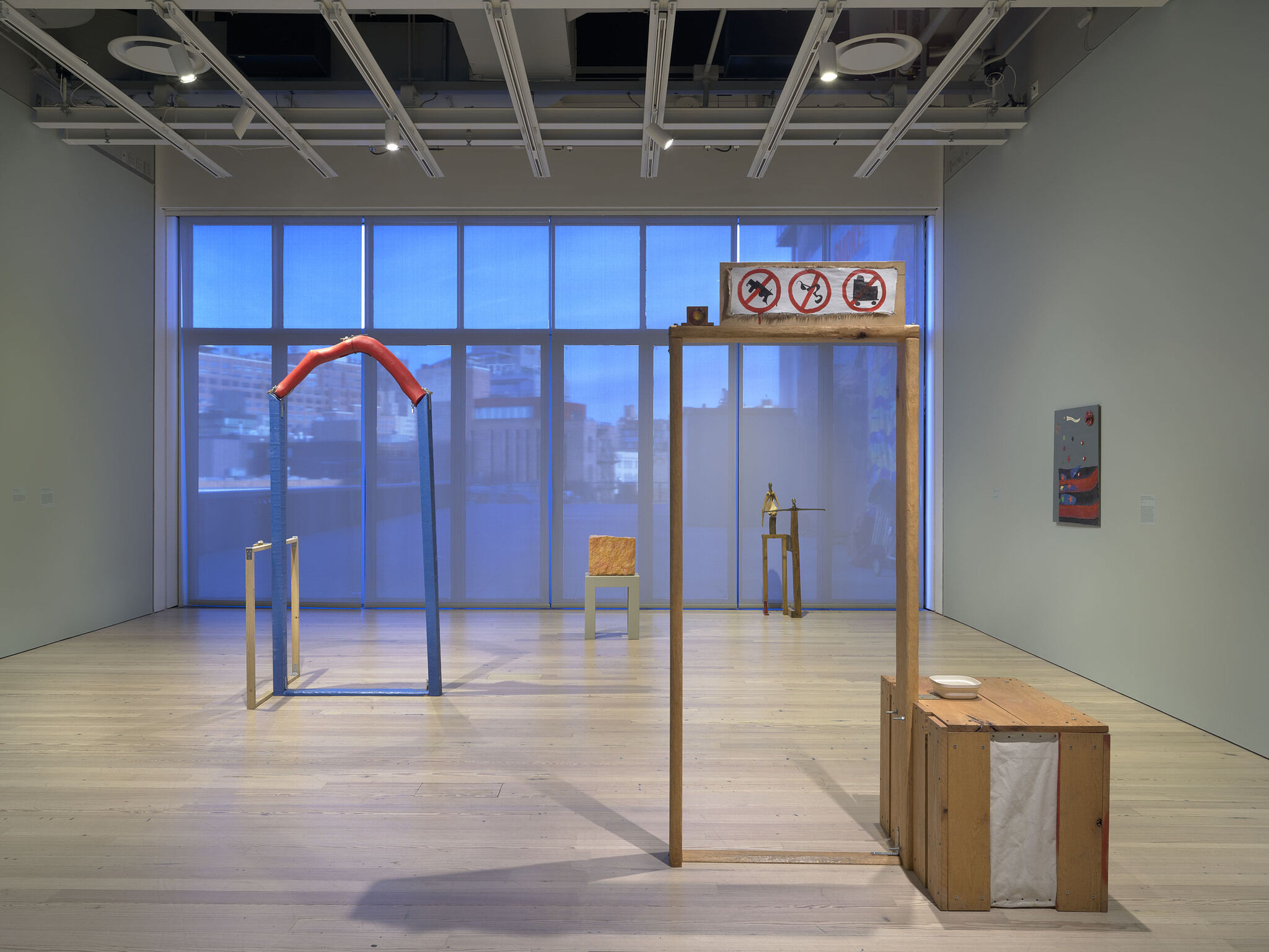

Installation view of Jimmie Durham: At the Center of the World (Whitney Museum of American Art, New York, November 3, 2017–January 28, 2018). From left to right: Arc de Triomphe for Personal Use, 1996; A Stone Rejected by the Builder (1), 2006; L’Essence, 2007; Forbidden Things, 1993; Une étude des étoiles [A study of stars], 1995. Photograph by Ron Amstutz
-
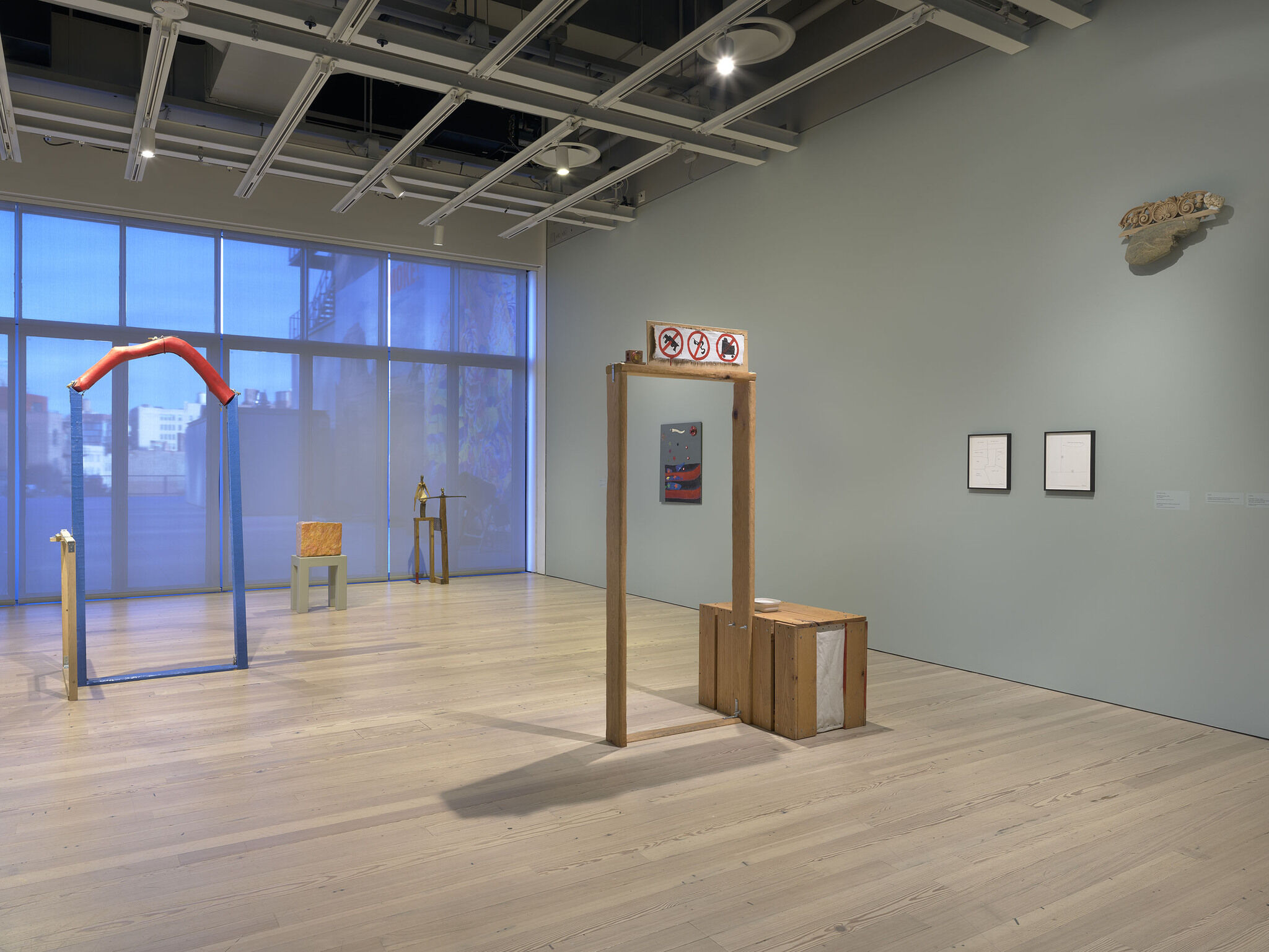

Installation view of Jimmie Durham: At the Center of the World (Whitney Museum of American Art, New York, November 3, 2017–January 28, 2018). From left to right: Arc de Triomphe for Personal Use, 1996; A Stone Rejected by the Builder (1), 2006; Forbidden Things, 1993; L’Essence, 2007; Une étude des étoiles [A study of stars], 1995; Untitled (sections), 2012; Untitled (provisional auxilliary horizon), 2012; Suggested Proposal for a New Architecture n°2, 2004. Photograph by Ron Amstutz
-
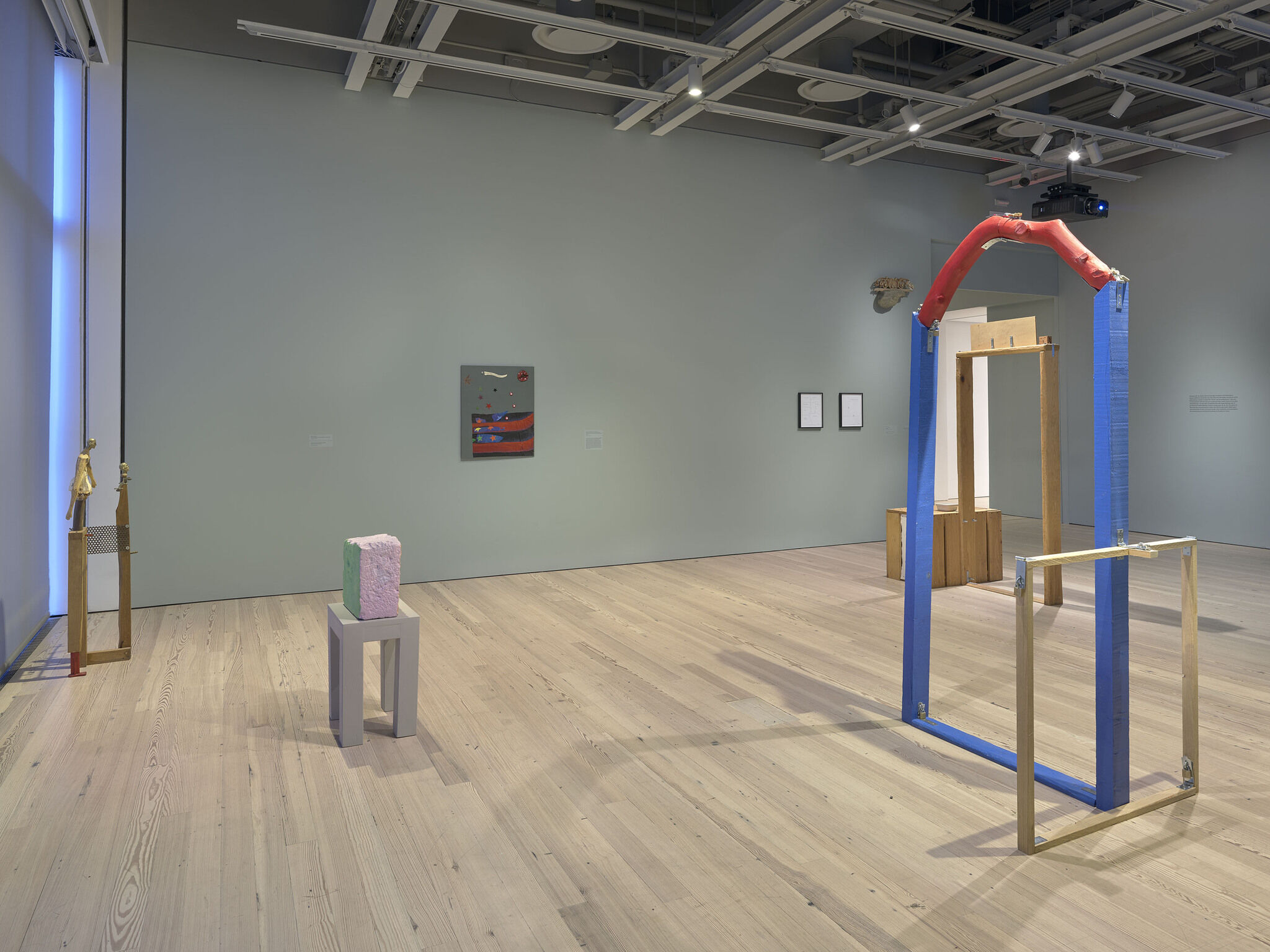

Installation view of Jimmie Durham: At the Center of the World (Whitney Museum of American Art, New York, November 3, 2017–January 28, 2018). From left to right: Forbidden Things, 1993; A Stone Rejected by the Builder (1), 2006; Une étude des étoiles [A study of stars], 1995; Untitled (sections), 2012; Untitled (provisional auxilliary horizon), 2012; Suggested Proposal for a New Architecture n°2, 2004; L’Essence, 2007; Arc de Triomphe for Personal Use, 1996. Photograph by Ron Amstutz
-
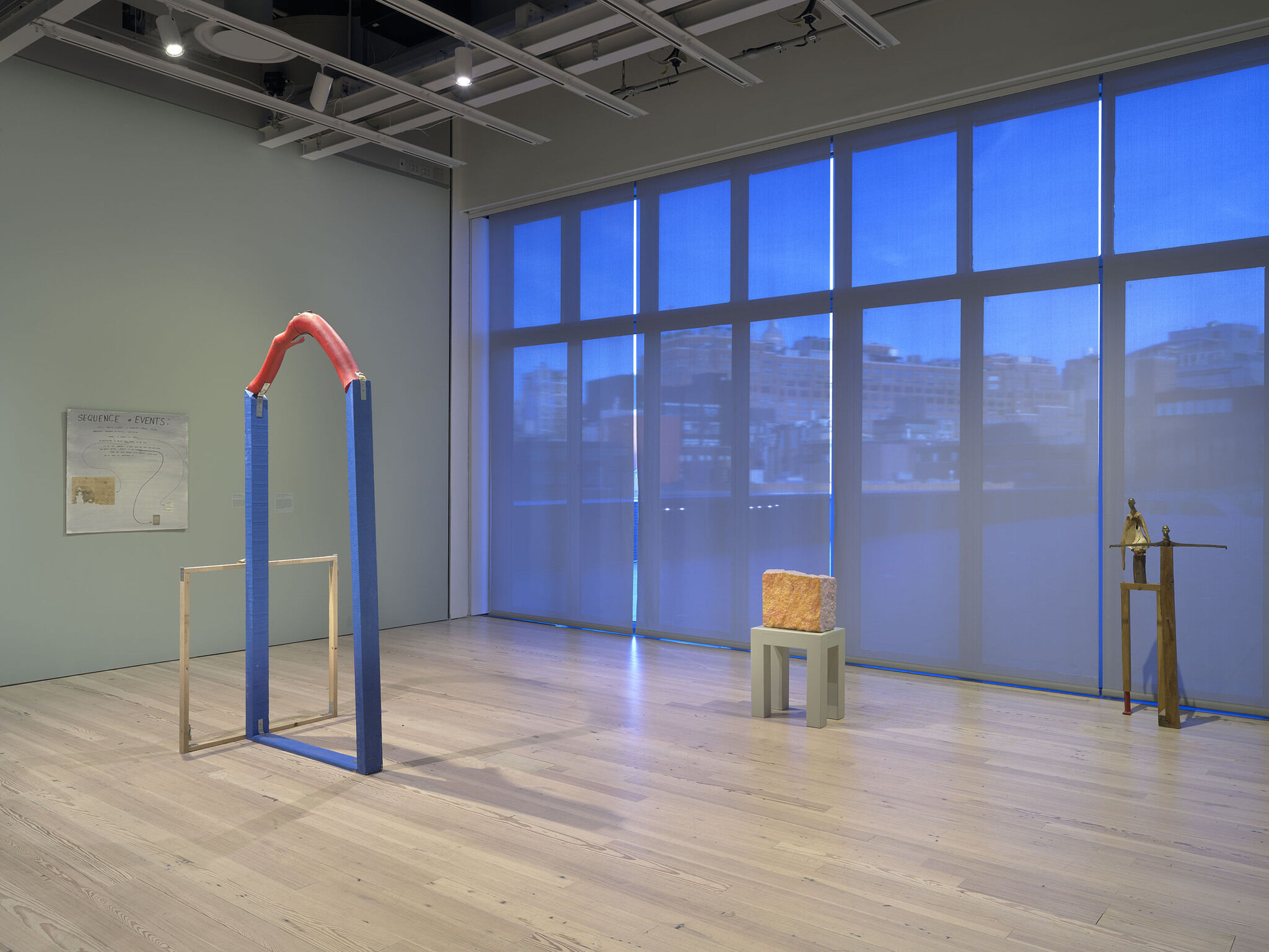

Installation view of Jimmie Durham: At the Center of the World (Whitney Museum of American Art, New York, November 3, 2017–January 28, 2018). From left to right: Sequence of Events, 1993; Arc de Triomphe for Personal Use, 1996; A Stone Rejected by the Builder (1), 2006; Forbidden Things, 1993. Photograph by Ron Amstutz
-
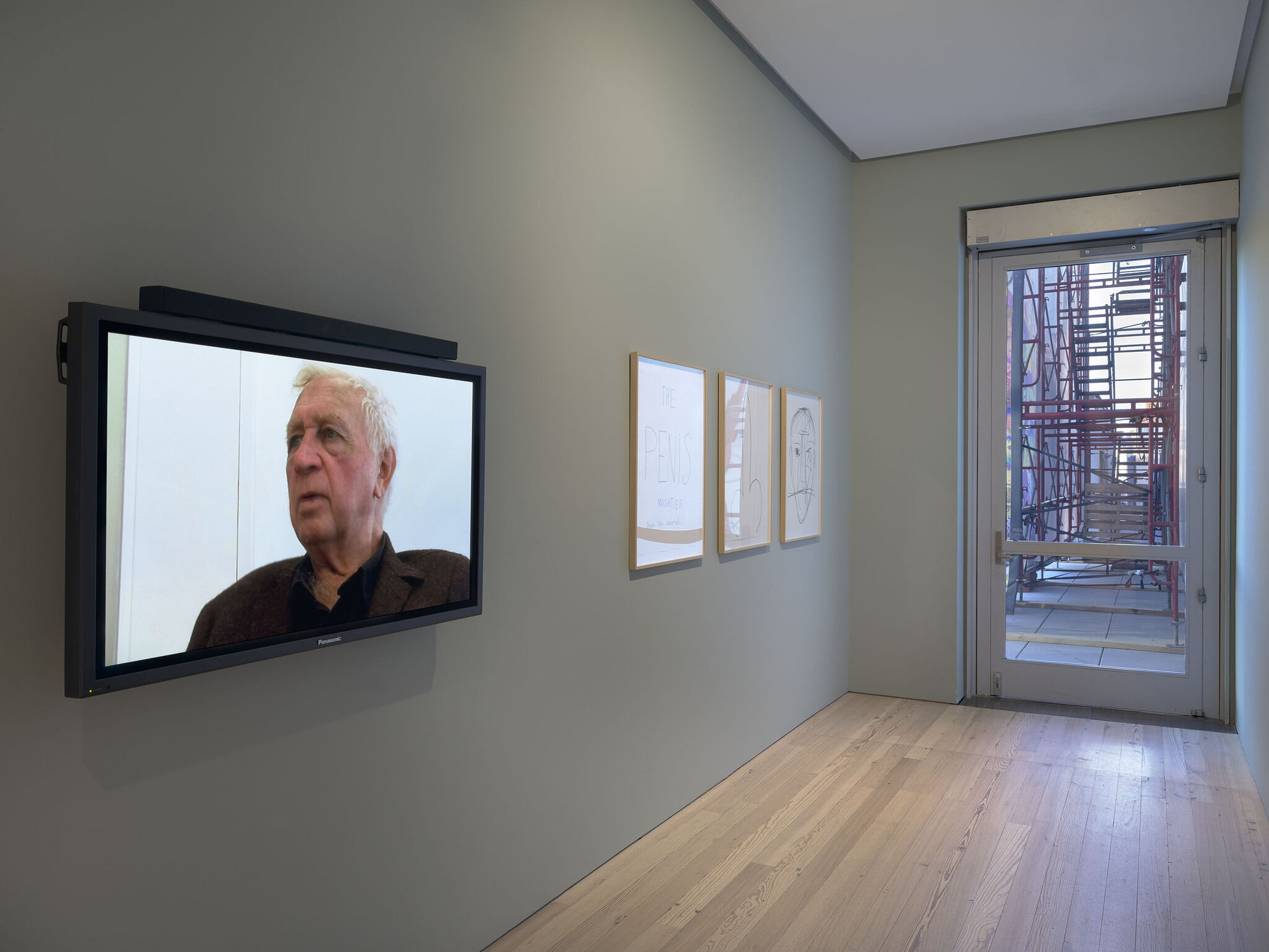

Installation view of Jimmie Durham: At the Center of the World (Whitney Museum of American Art, New York, November 3, 2017–January 28, 2018). From left to right: Cristian Manzutto, Selections from Not About Me (Jimmie Durham Documentation Project 2008-2016), 2017; Jimmie Durham, Untitled (The Penis Mightier), 2007. Photograph by Ron Amstutz
-
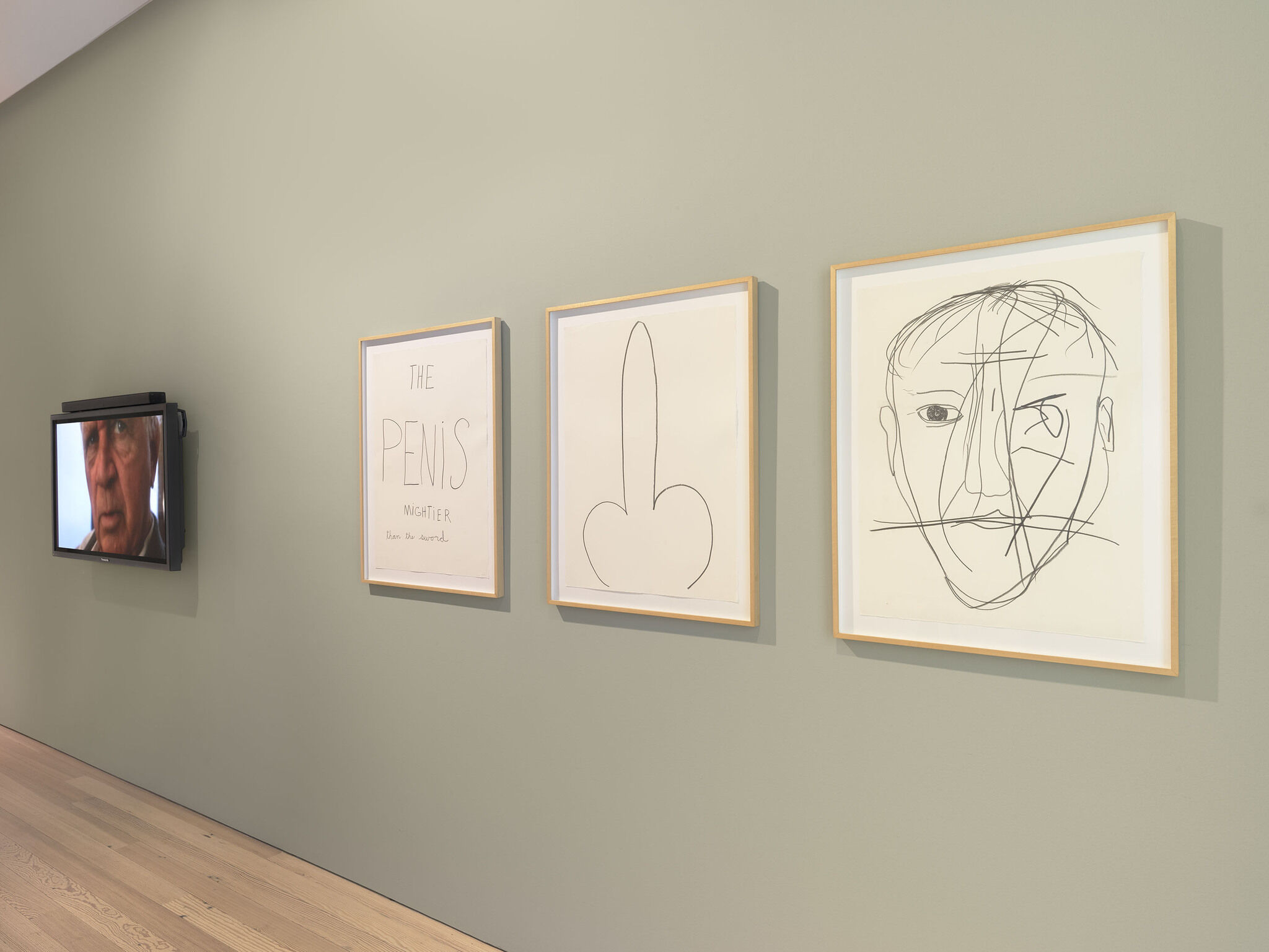

Installation view of Jimmie Durham: At the Center of the World (Whitney Museum of American Art, New York, November 3, 2017–January 28, 2018). From left to right: Cristian Manzutto, Selections from Not About Me (Jimmie Durham Documentation Project 2008-2016), 2017; Jimmie Durham, Untitled (The Penis Mightier), 2007. Photograph by Ron Amstutz
-
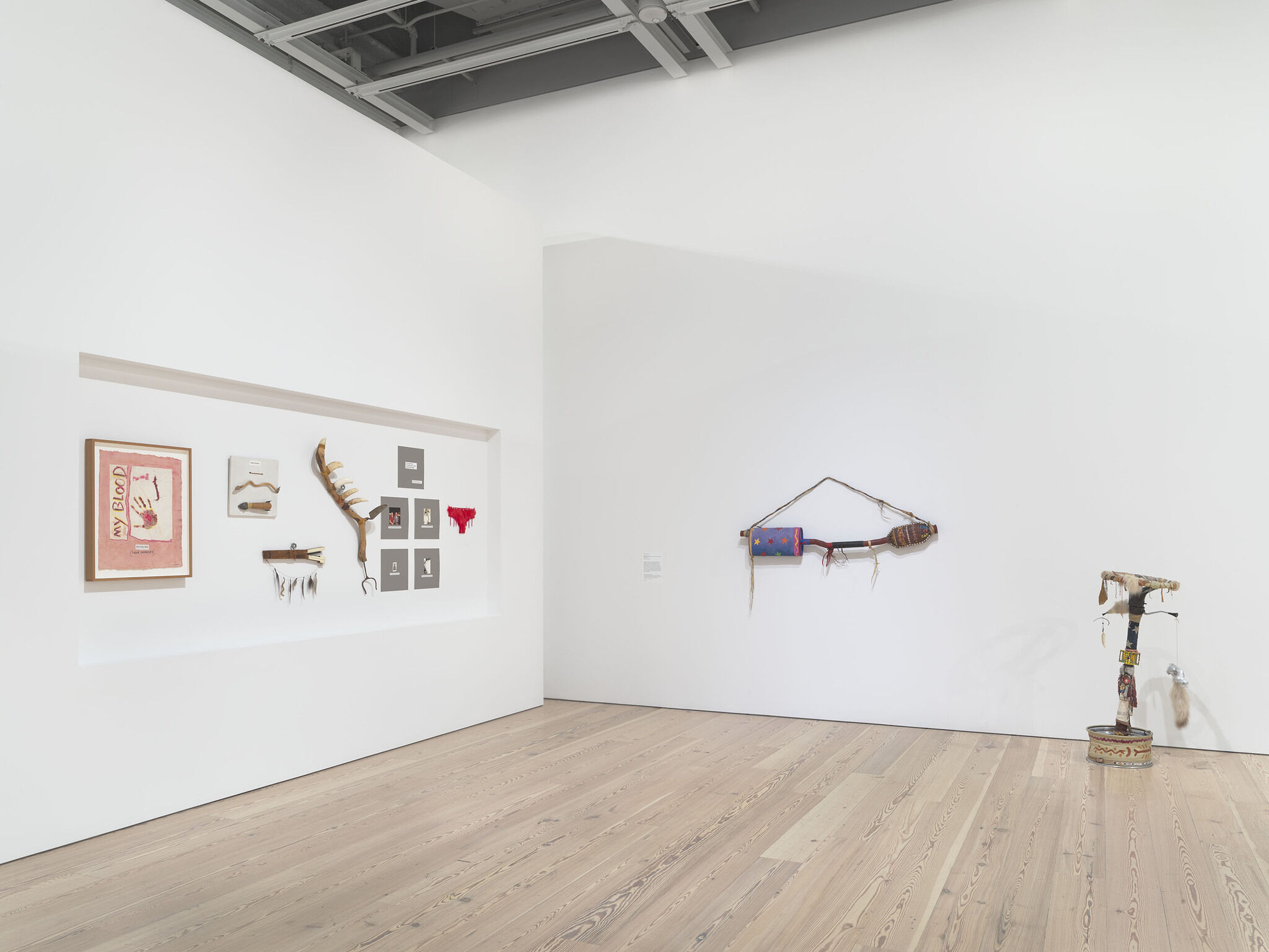

Installation view of Jimmie Durham: At the Center of the World (Whitney Museum of American Art, New York, November 3, 2017–January 28, 2018). From left to right: My Blood, 1985/1991; Types of Arrows, 1985/86; Whose Hair Is It?, 1985; Whale Tooth Stick, 1985; The Indian’s Family, 1985; Pocahontas’ Underwear, 1985/2016; Bedia’s Muffler, 1985; Bedia’s Stirring Wheel, 1985. Photograph by Ron Amstutz
-
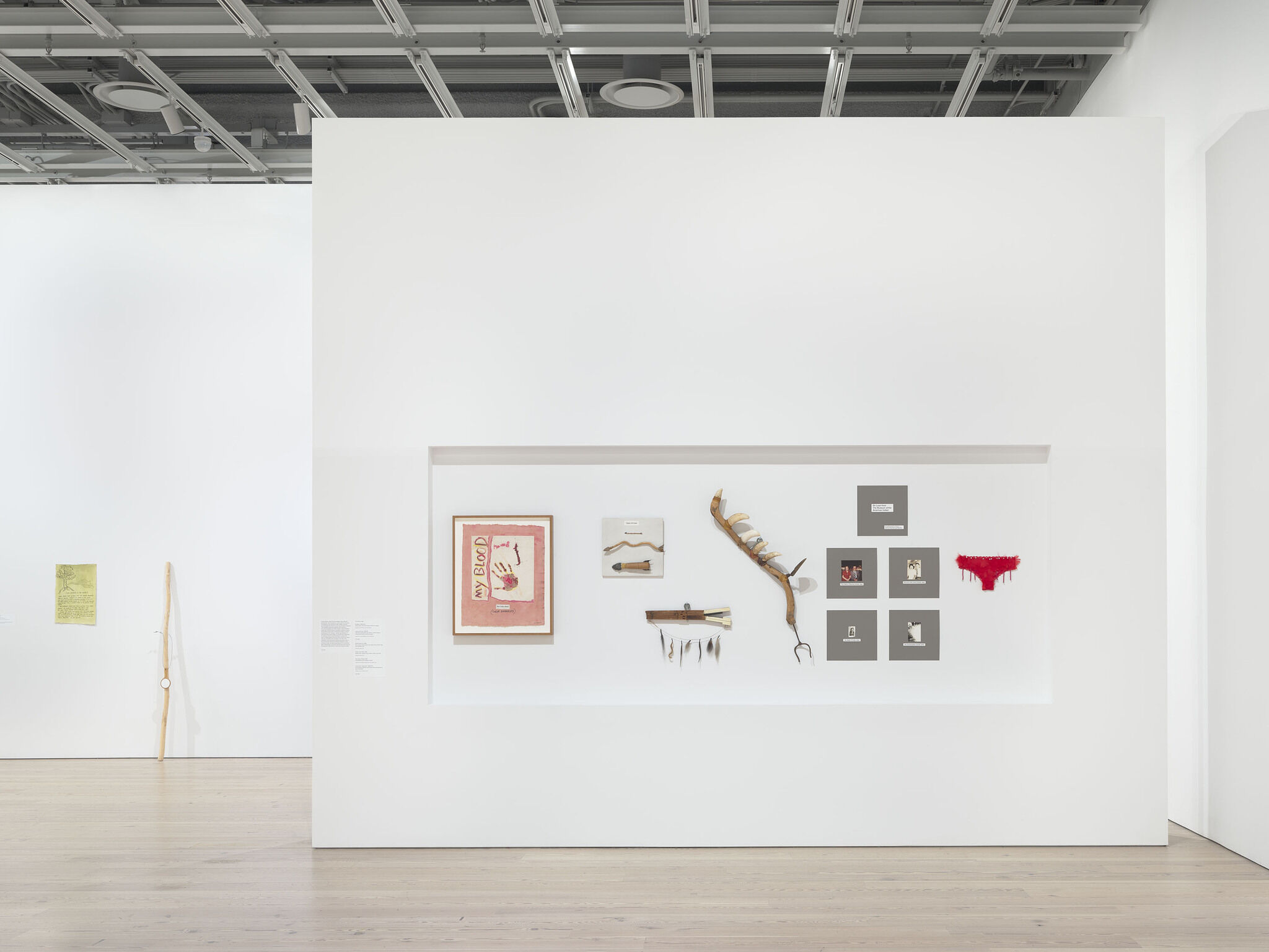

Installation view of Jimmie Durham: At the Center of the World (Whitney Museum of American Art, New York, November 3, 2017–January 28, 2018). From left to right: Anti Flag, 1992; A Pole to Mark the Center of the World in Berlin, 2004; My Blood, 1985/1991; Types of Arrows, 1985/86; Whose Hair Is It?, 1985; Whale Tooth Stick, 1985; The Indian’s Family, 1985; Pocahontas’ Underwear, 1985/2016. Photograph by Ron Amstutz
-
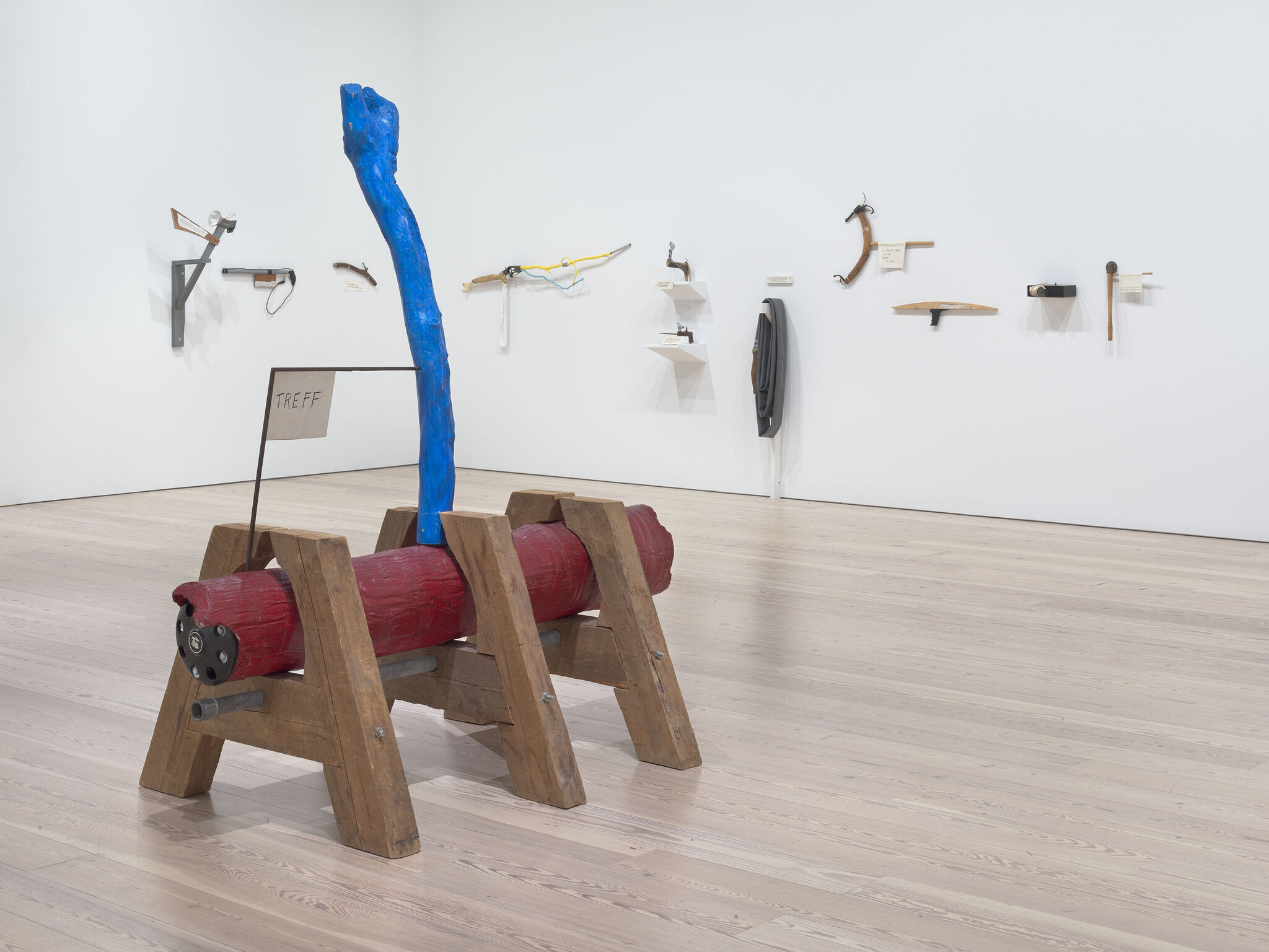

Installation view of Jimmie Durham: At the Center of the World (Whitney Museum of American Art, New York, November 3, 2017–January 28, 2018). From left to right: Treff [Encounter], 1992; Sonderbar kam es mir vor, daß sie diese Übung an einer alten Stadtmauer ohne die mindeste Bequemlichkeit für die Zuschauer vornehmen; warum sie es nicht im Amphitheater tun, wo so schöner Raum wäre!, 1993–2012; So saß sie, wenn sie nicht liegen musste, in Gesellschaft der Rätin Spatz, verhielt sich still und hing, eine Handarbeit im Schoße, an der sie nicht arbeitete, diesem oder jenem Gedanken nach., 1993; Tu ne cede malis, sed contra audentior ito., 1993; False Orthografie, Broken English, 1993; In flaming fire take vengeance upon them that know not God and that obey not the gospel of our Lord Jesus Christ., 1993; He bid his Angels turn askance the poles of Earth twice ten degrees and more from the sun’s axle; they with labor pushed oblique the centric globe:, 1993; Весь этот и следующий день друзья и товарищи Рóстова замечали, что он не скучен, не сердит, но молчалив, задумчив и сосредоточен. Он неохотно пил, старался оставаться один и о чем-то все думал, 1993; I Forgot What I Was Going to Say, 1992; Mishap in the jungle. The rest of them were mostly Indians: tough young fellows with wiry strength and impassive faces. The whitest, 1993; Behold my hands and my feet, that is myself: Handle me and see; for a spirit hath not flesh and bones – as ye see me have., 1993; ελθων δ΄ εξ ορεος μεϒας αιετος αϒκυλοχειλης πασι κατ΄ αυχενας ηξε και εκτανεν, 1993. Photograph by Ron Amstutz
-
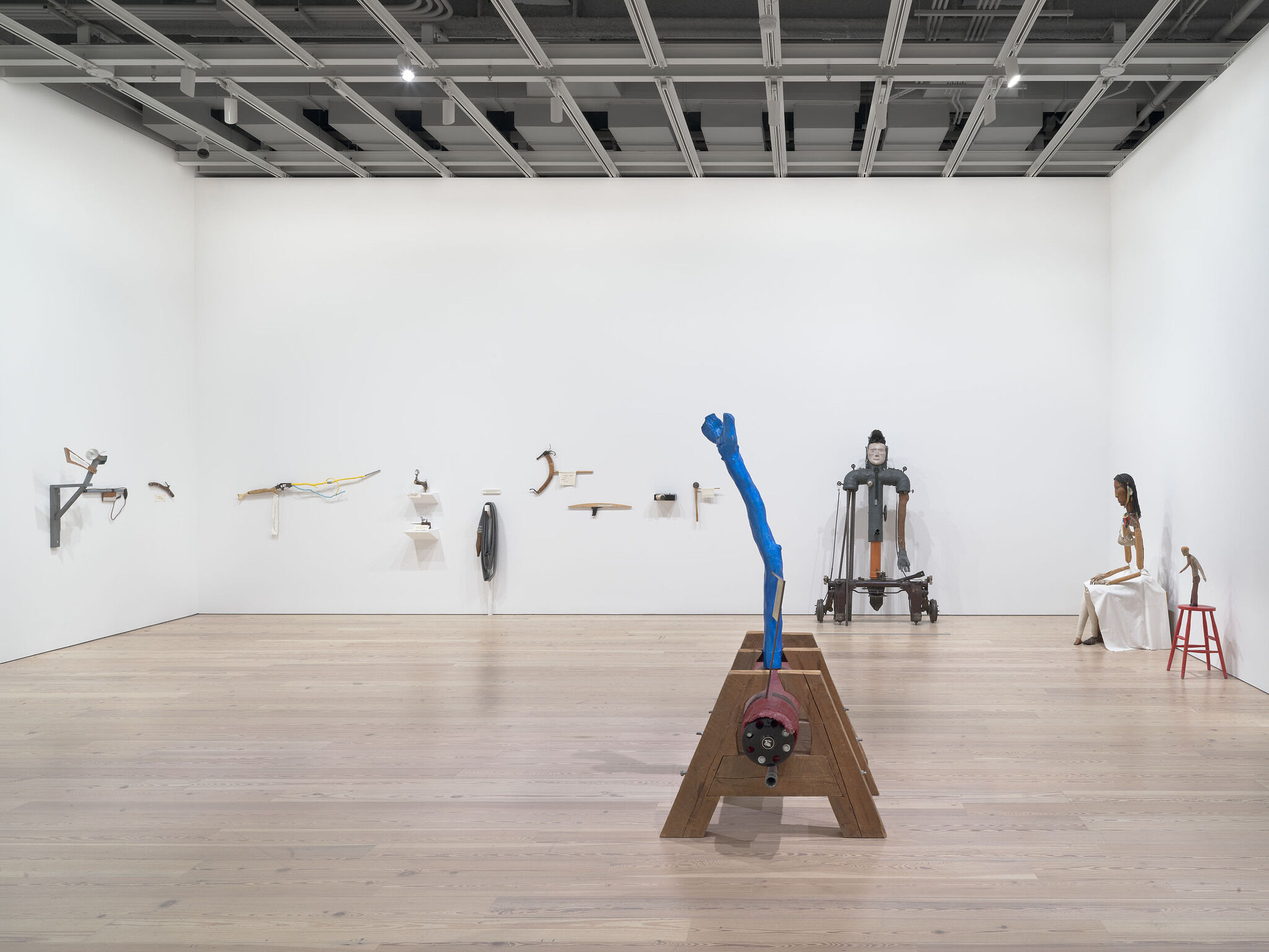

Installation view of Jimmie Durham: At the Center of the World (Whitney Museum of American Art, New York, November 3, 2017–January 28, 2018). From left to right: Sonderbar kam es mir vor, daß sie diese Übung an einer alten Stadtmauer ohne die mindeste Bequemlichkeit für die Zuschauer vornehmen; warum sie es nicht im Amphitheater tun, wo so schöner Raum wäre!, 1993–2012; So saß sie, wenn sie nicht liegen musste, in Gesellschaft der Rätin Spatz, verhielt sich still und hing, eine Handarbeit im Schoße, an der sie nicht arbeitete, diesem oder jenem Gedanken nach., 1993; Tu ne cede malis, sed contra audentior ito., 1993; False Orthografie, Broken English, 1993; In flaming fire take vengeance upon them that know not God and that obey not the gospel of our Lord Jesus Christ., 1993; He bid his Angels turn askance the poles of Earth twice ten degrees and more from the sun’s axle; they with labor pushed oblique the centric globe:, 1993; Весь этот и следующий день друзья и товарищи Рóстова замечали, что он не скучен, не сердит, но молчалив, задумчив и сосредоточен. Он неохотно пил, старался оставаться один и о чем-то все думал, 1993; I Forgot What I Was Going to Say, 1992; Mishap in the jungle. The rest of them were mostly Indians: tough young fellows with wiry strength and impassive faces. The whitest, 1993; Behold my hands and my feet, that is myself: Handle me and see; for a spirit hath not flesh and bones – as ye see me have., 1993; ελθων δ΄ εξ ορεος μεϒας αιετος αϒκυλοχειλης πασι κατ΄ αυχενας ηξε και εκτανεν, 1993; Treff [Encounter], 1992; Cortez, 1991–92; Malinche, 1988–92; The Two Johns, 1988. Photograph by Ron Amstutz
-
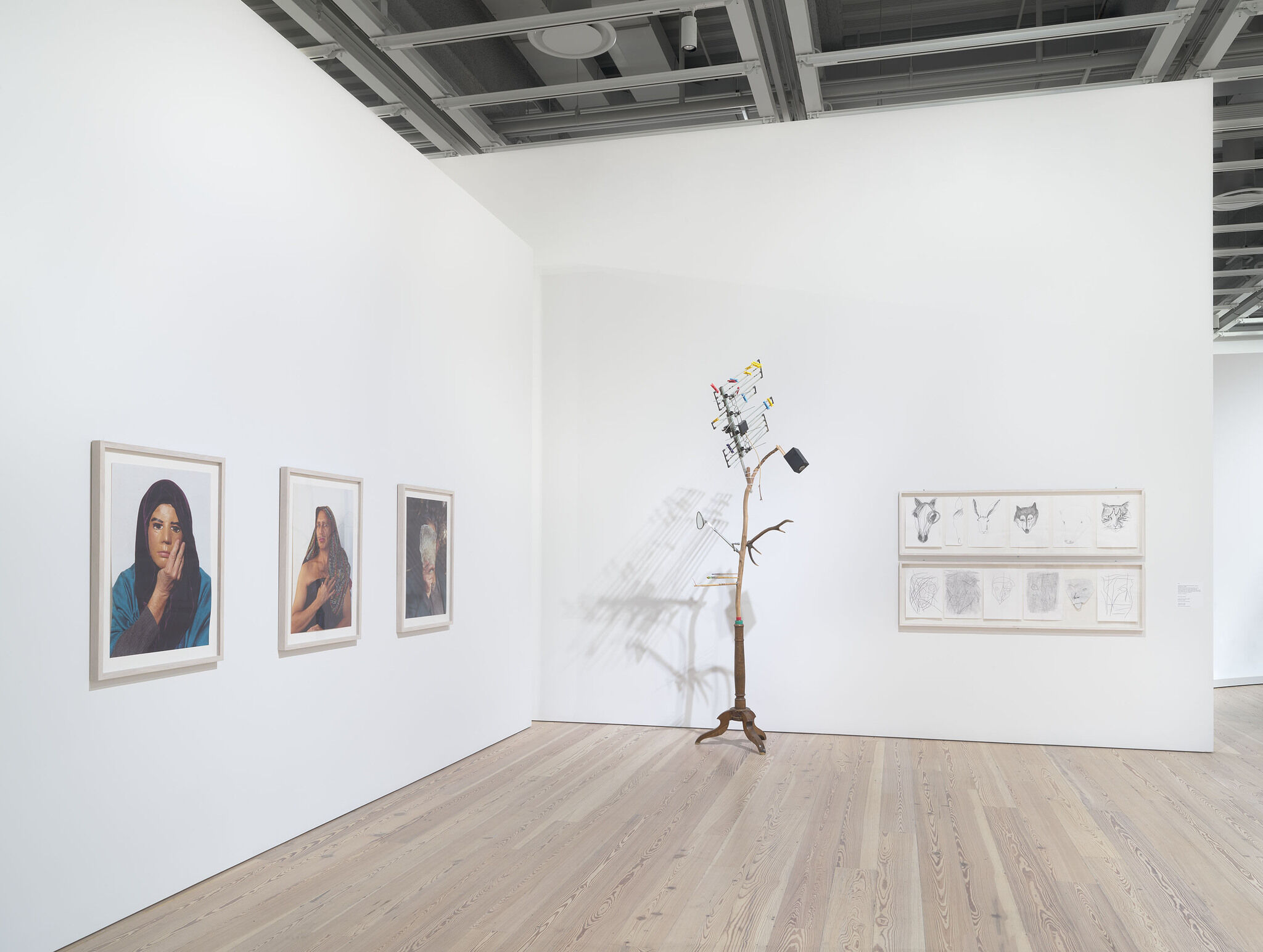

Installation view of Jimmie Durham: At the Center of the World (Whitney Museum of American Art, New York, November 3, 2017–January 28, 2018). From left to right: Self-Portrait Pretending to Be Maria Thereza Alves, 1995–2006; Self-Portrait pretending to be Rosa Levy, 1994; Self-Portrait Pretending to Be a Stone Statue of Myself, 2006; The Bluebird of Happiness and the Miner’s Canary (Classic Rock), 2008; Drawn Lines and Faces, 1998; Three Faces, 1998. Photograph by Ron Amstutz
-
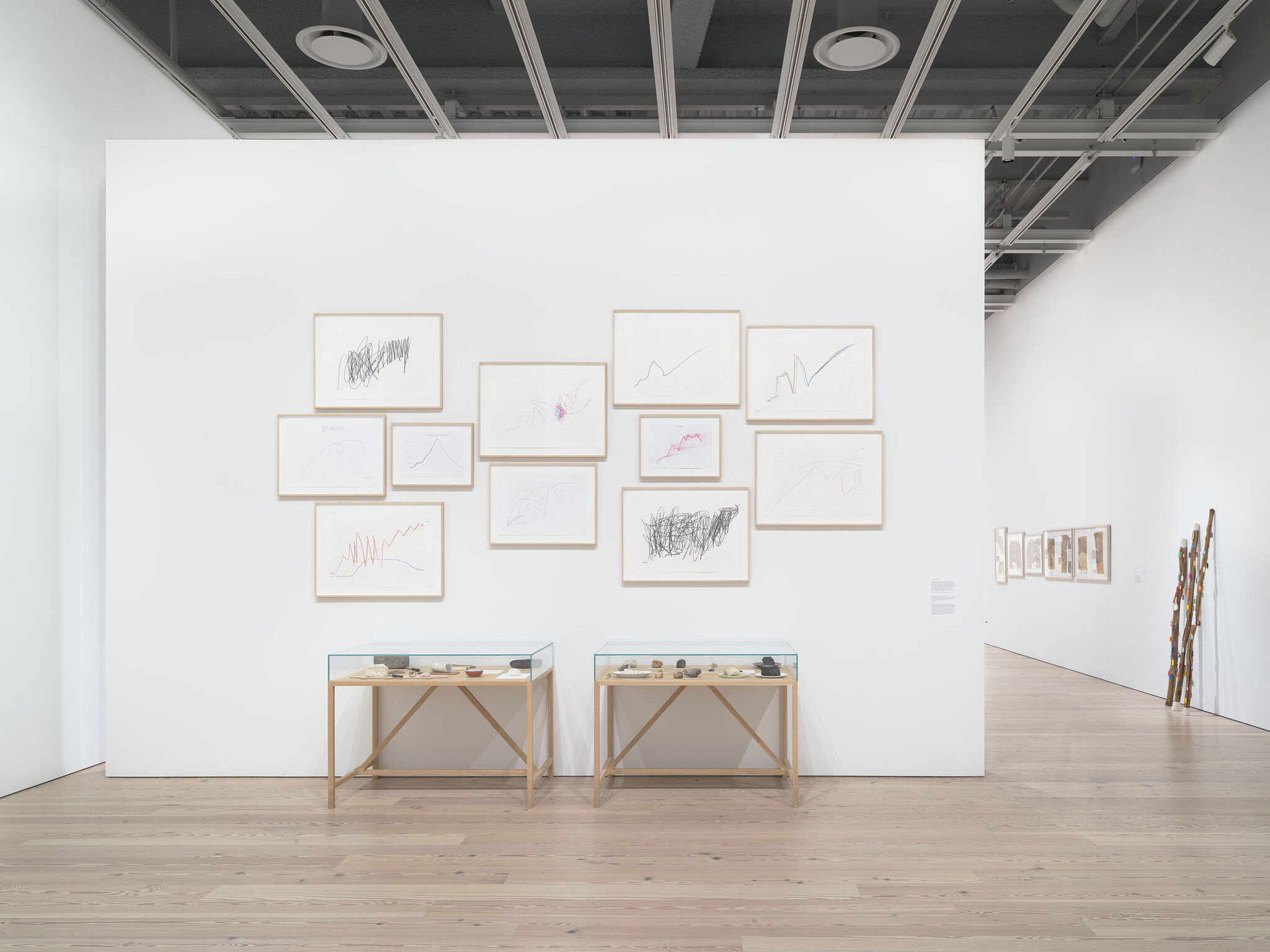

Installation view of Jimmie Durham: At the Center of the World (Whitney Museum of American Art, New York, November 3, 2017–January 28, 2018). From left to right: Untitled (On a Scale of One through Ten, Recalcitrant Trends, Ill Wind, Seven Lines Indicating Various Colors and Trends, The Turquoise Line Is Probably Indicative, Red and Blue Meeting, Water, Lightning and Anger, Clearly, Not Everything Functions, Indications of the Frequent Escape Mechanisms of Clarity, from Normality. . . , More a Process Than a Beginning and an End), 2013; The Dangers of Petrification II, 1998–2007; 1948, 2012; A Staff to Mark the Center of the World, Gwangju Biennale, 2004. Photograph by Ron Amstutz
-
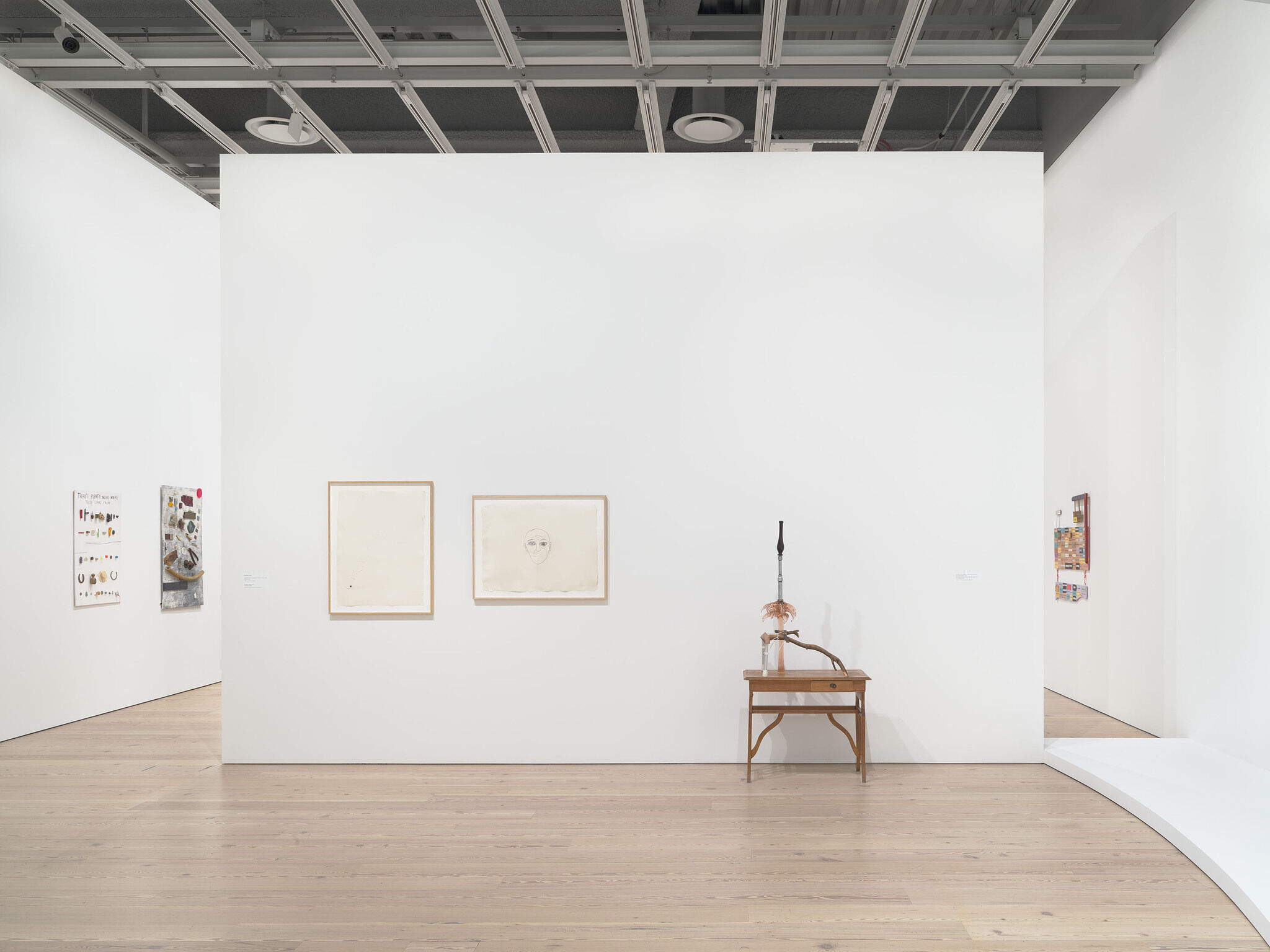

Installation view of Jimmie Durham: At the Center of the World (Whitney Museum of American Art, New York, November 3, 2017–January 28, 2018). From left to right: THERE’S PLENTY MORE WHERE THESE CAME FROM, 2008; Snake Eyes!, 2006; Obsidiana mexican, homenaje a Fontana, Mexico, 2009; Obsidian tongue, 2009; Pink Palm-Tree-Like Glass Construction with Various Decorative Elements, 2015; The names of the team of scientists who published an article on human chromosome 14 in Nature magazine, 2003. Photograph by Ron Amstutz
In the News
“One of the most compelling and multifaceted figures working internationally today.”
—ArtDaily
"A panorama of a singular, cantankerous, container-resistant career."
—The New York Times

